














Pawan Luthra
EDITOR
Rajni Anand Luthra
ASSISTANT EDITOR
Sheryl Dixit
MELBOURNE
Preeti Jabbal
Malavika Santhebennur, Hasnain Zaheer, Sudha Natarajan, Jyoti Shankar, Frankey Gerard Fernandes, Chitra Sudarshan, Noel G deSouza, Amit Dutt, Mahesh Radhakrishnan, Tim Blight, Mohan Dhall, Geeta Khurana, Avi Chandiok, Petra O’Neill, Rani Jhala, Talia Kaur, Nancy Althea, LP Ayer

ADVERTISING MANAGER
Vivek Trivedi 02 9262 1766
ADVERTISING ASSISTANT
Nitika Sondhi 02 9279 2004
DESIGN
Danielle Cairis
Indian Link is a fortnightly newspaper published in English. No material, including advertisements designed by Indian Link, maybe reproduced in part or in whole without the written consent of the editor. Opinions carried in Indian Link are those of the writers and not necessarily endorsed by Indian Link. All correspondence should be addressed to
Indian Link
Level 24/44 Market St, Sydney 2000 or GPO Box 108, Sydney 2001
Ph: 02 9279-2004 Fax: 02 9279-2005
Email: info@indianlink.com.au
www.indianlink.com.au

Ken Henry was the person deputed with the task of presenting a white paper on Australia’s engagement with Asia in the 21st century. He also chaired the 2010 Australia’s Future Tax System Review, which became better known as the Henry Tax Review. This tax review detailed changes to superannuation, resource rent tax on the mining sector, and tax reform for small businesses. Most of the recommended tax reforms have not found their way into our daily lives and those which have, such as the mining tax, have been changed substantially from their initial conception. Ken Henry’s Asian Century paper, released a few days ago, fills one with both optimism and pessimism.
The optimism comes from the fact that Australia seems to have moved on from its dependence on the United States and now has a vision of engaging more with its neighbours in the North. While the mining boom has created a better brand name for China and India because of their deep consumer markets, we have failed to capture the true potential of what these countries need in terms of services from Australia. The Asian Century white paper clearly articulates the value add which Australians can offer to the booming middle class in these countries. The emphasis will be more on services
rather than the traditional products which Australia sells to its Asian neighbours.
If they need new houses, Australian architects have a depth of experience working in this climatically diverse country. If they need to set up financial services to meet the needs of middle class affluence, Australia has a robust financial services programme. If our Asian neighbours need to implement environmentally-friendly offices, Australia has the expertise to sell these as well. This and a lot more can be done to increase Australian engagement in Asia, beyond the sale of crops and coal, and to expand to selling our intellectual expertise.
The introduction of Hindi as an option of study is another reason for optimism for Indian Australians. That Hindi has been recognised at such levels of decision making is indeed a credit to all the local Indian associations, community groups, media and community leaders who have worked hard to make sure India’s national language gets noticed in mainstream Australia. While a number of community language schools are currently teaching Hindi, they have never had the recognition that Chinese or Mandarin community language schools enjoy. The emergence of the Hindi language in school curriculums will be a welcome move for Indian Australians and will lead to a better involvement of Australians with India.
But there is pessimism because while the Asia paper paints a vision for the future, it has merely stated the obvious. Australia and its policy makers have been down this path before with former Prime Minister Paul Keating painting a ‘big picture’ of
the country’s future, breaking away from traditional ties with Britain and forging new alliances within the Asia Pacific region. He was keen to foster a meaningful strategic and cultural future for Australia in its Asian neighbourhood. But fast forward 15 years, we are still singing from the same old music sheet. Australians have done business in Asia, but they have not won the hearts and minds of their immediate neighbours. While trade and tourism has boomed, we have still to build a deep and meaningful friendship with many of our Asian neighbours, India included.
What will bring Australia and its Asian neighbours closer will be a deeper understanding of their cultures. Culture, amongst its many definitions is also described as ‘the ideas, customs, and social behaviour of a particular people or society’. A good start could be the Australian government changing the name and functionality of its Foreign Affairs department. Known now as the Department of Foreign Affairs and Trade, it may be an idea to divorce the Foreign Affairs from the Trade segment in this area of government. Diplomacy and business do not have to go hand in hand. One can have friends without doing business with them.
In Asian countries, forcing a friendship to do business is a difficult concept to accept culturally and ethically. But once strong friendships are forged, business will occur of its own accord.
To help progress the engagement principles listed in the Asian Century white paper, perhaps some housekeeping may be in order.
Religious discourses by Sri Velukkudi
Swami
7 – 11 Nov The Vedic Society of Victoria announces a series of lectures in English by the renowned Sri Velukkudi Krishnan Swami. Sri Velukkudi Swami comes from a long parampara (tradition) of religious scholars and is singularly equipped to give pravachans on all forms of Hindu scripture, due to his knowledge of various Hindu theological traditions. He has travelled widely, giving religious discourses and representing Hindu dharma in world forums and his lectures on the Bhagawad Gita are at once aweinspiring and moving, lucid and erudite. Details Ramesh Raghuraman 0406 133 233.
Ramakrishna Sarada Vedanta Society of NSW activities
Thurs 15 Nov 2.30-3.30pm
Vivekananda Book Club Meeting:
Discussion Group exploring the book:
Letters of Swami Vivekananda
Sun 18 Nov 10.40am to 12noon
Kali Puja. Celebration commences with Hari Om Ramakrishna Chant, Silent meditation, Talks by Pravrajika Gayatriprana and Mrs.Bala Lakshmanam, followed by a special candlelight ceremony/offering and distribution of offered food.
Sun 18 Nov 3.00-6.00pm Young
People’s Discussion Group for ages 17 and over. Theme: Emotional Intelligence.
Sun 15 Dec 5.30-7.30pm Avijit Sarkar & Friends. Free early evening concert of devotional songs. Complimentary tea/ coffee, sweets & savouries provided.
Venue: Vedanta Hall, 15 Liverpool Road, Croydon. Details 02 9745 4320 or email:
admin.saradavedanta@bigpond.com
Website: www.saradavedanta.org
Mahavir Nirvan (Diwali)
Sun 18 Nov Sydney Jain Mandal
celebrates Mahavir Nirvan at Sri Mandir
286 Cumberland Rd, Auburn, 9.00am. Program includes pooja and cultural items, followed by Jain lunch.
Details Abha Jain 0432 248 791.
Sri Guru Nanak Sahib’s Agman Purab (Advent Day)
Wed 28 Nov Sikh Nation urges all Sikhs to adorn a turban on the day marking Agman Purab, to raise awareness about Sikhi and the turban, in the wake of recent worldwide incidents against Sikhs. At a special event at Martin Place Sydney, everyday Australians will have an opportunity to try the turban on themselves. Details 00423 017 011 or visit the website www.sikhnation.com.
au
VHP Australia
VHP Australia is seeking volunteer teachers to teach Hindu Dharma in Public Schools (approved by the Dept of Education). Training and materials will be provided. Details Akila Ramarathinam 02 8814 7016.
* Sydney Veda Patasala is open for children and adults. It involves Vedic chanting and Sanskrit language. Classes are held at on Sundays Baulkham Hills, Carlingford, Moorebank and Westmead.
Details Sri Subbuji 0425 284 501.
* Bala Samskara Kendra (Sanskrit
Language, Indian Culture and Heritage School for children) operates out of Toongabbie, Moorebank, Hornsby and
Flemington.
Students learn Sanskrit language (writing, reading, speaking and reciting poems).
Details Rohini Srinivasan 02 9863 3067.
FESTIVAL
RAIN Diwali
Sat 3 Nov RAIN seniors plan to celebrate Diwali at the Woodville Park, Hudson Street, Hurstville at 4.30pm, as part of the Discovery festival put together by the Hurstville City Council. The program will include singing by RAIN Gitanjali Choir group, dances by RAIN Nrityanjali group and a special performance of RAIN Nritya Yoga dance. Details Sudha Natarajan 02 9585 9158.
Deepavali Milan
Sat 10 Nov Celebrate Diwali with friends on the North Shore: Laxmi Poojan, cultural program, lucky draw prizes, dinner. Town Hall, 1186 Pacific Highway, Pymble NSW, 6.00pm. Details Kamini Sahni 0401 059 923.
Vision 2020 Diwali Dinner
Sat 10 Nov Vision 2020 celebrates Diwali with a 3-course dinner and variety entertainment at Asquith Community Centre, 10a Old Berowra Road, Hornsby. It is also organising the ordering of Diwali sweets and savouries from Grand Sweets Adayar Ananda Bhavan, Chennai. Details Vision2020au@gmail.com
STAGE
Classical music concert
Sat 17 Nov Sarod player Steve Oda (a senior disciple of Ustad Ali Akbar Khan) and tabla player Ty Burhoe (senior disciple of Ustad Zakir Hussain) present
a concert in classical north Indian tradition, at Manly Yoga, 27 Pittwater Rd, 7.30pm onwards. (Workshop on 18 Nov). Details www.TalaRecords.com
FUNDRAISER
I-India Project’s Diwali Night
Sat 10 Nov I-India Project is organising a wonderful night of themed entertainment including Bollywood singing and dancing, magic and comedy. Grand Ballroom, Four Seasons Hotel, 199 George St, Sydney, 6.30pm.
Details Renate Barnett 0402 958 582.
MISC
Going to the Mahakumbh next year?
Australian independent documentary film-maker Mark Gould is searching for Hindu Australians who intend to go to the upcoming Maha Kumbh Mela at Allahabad (Prayag) in Feb 2013.
ABC TV’s religious program Compass (6.30pm Sundays) is keen to tell the story of this sacred journey and what it means to the devotees.
The subjects of the film would need to be prepared to share their stories, their bhakti and relationship to their faith on camera in a documentary focussed on this special pilgrimage - why they are making it and what they hope to gain from this great event.
The ideal subjects would be devout Australian Hindus - individuals or a family who are articulate about their faith and keen to reconnect with their Hindu traditions. Details Mark Gould 0419 635 614 or email mark@ BondiRocksMedia.tv
Being South Asian and GLBTIQ Sat 3 Nov Trikone Australia, a GLBTIQ (Gay, Lesbian, Bisexual, Transgender,
I just had opportunity to visit the Indian Consulate recently and I don’t know if you are aware that they have relocated to Level 3, 109 Pitt Street Sydney from their 190 George St address.
I am surprised to note our Indian Consulate office has moved from a prestigious building of Bligh Street to such an awful building.
109 Pitt St is just above Hunter Connection: the building is like a mini Chungking mansion of Hong Kong. There are a few drunkards sitting near the front door, and while the Consulate is on the third floor, neither the concierge is aware that the Indian consulate has moved into their building nor has the foyer tenant directory been updated with this information.
When you get to Level 3, you find the old tenant’s name imprint still there: our Consulate has made no efforts to fix it.
I feel aghast to state that while we say our country is progressing, our Consulate here does not stand up and present itself to those standards. Even a small country like Thailand has its consulate offices on Macquarie Street and presents itself well. I don’t know what impression we are presenting to the local Australians.
Darayus Patva Padstow, NSWThis is with reference to a letter to your publication by Mr. Darayus Patva regarding the location of Consulate General of India in Sydney. I wish to set the record straight on this matter.
The premises at Bligh Street, where the Consulate General of India in Sydney was previously located, were first leased in 1994-‘95. Over the years, as the work and staff of Consulate expanded along with the growing Indian community, the area available at the premises became increasingly insufficient to house the Consulate. There were, in fact, many complaints from the Indian community about lack of adequate space at our offices in Bligh Street.
The Consulate then relocated to 190 George Street, but as the building became scheduled for demolition, it became impossible to continue the tenancy.
The Consulate relocated to Level 3, 109 Pitt Street with effect from 22 October 2012 (Monday). Consular services were provided without interruption till 19 October 2012 (Friday) and resumed again on the
next working day 22 October 2012 (Monday), after the entire Consulate staff worked selflessly through the weekend to ensure a smooth transition. Not a single working day was wasted on the transition, nor was a single applicant turned away.
Notices of Consulate’s relocation were put at the Consulate reception on 190 George Street, and on the Consulate website as well as on the Consulate Facebook page. It is, of course, not possible to personally contact each and every person who may have to visit the Consulate. However, I would like to note that the new Consulate premises are barely a 10 minute walk away from the old offices, and are a stone’s throw away from the so-called “prestigious” location at Bligh Street.
Consulate’s new premises have exceptionally good public transport access from the stations at Wynyard, Martin Place and Circular Quay.
The Building Manager and the Concierge for 109 Pitt Street have been in touch with us constantly during the relocation process, as there can be no building access
Intersex, Queer and Questioning) group comprising South Asian-Australians and South Asians living in Australia, is organising an Open Forum with the aim of exploring avenues to survive, evolve and move forward while being both South Asian and GLBTIQ. It also hopes to bring untold stories to the surface as members negotiate the complex social dynamics of being South Asian as well as GLBTIQ. Venue ACON, 414 Elizabeth St, Sydney. Details Kalani 0434 504 306 or email contact. trikone@gmail.com
Dynamic Global Changes: ICAI conference
Fri 23 Nov The Australian Chapter of the Institute of Chartered Accountants of India is organising a one day international conference at Four Points by Sheraton, Darling Harbour, Sydney, entitled ‘Dynamic Global Changes –A World of Opportunities’. The full day conference will have presentations from an elite panel of speakers from the fields of accounting, corporate governance and management and includes Dr. John Hewson (renowned economist and former Federal Leader of the Opposition) and Padma Shree CA T N Manoharan, globally acclaimed speaker on accounting, taxation and corporate governance and former President of the ICAI. The topics for discussion would include India as the next investment destination, opportunities and challenges; IFRS (accounting standards for the future); Carbon Tax (accounting, implications and opportunities); Cloud Accounting (accounting the global way); and Indian and Australian economic overview. Details www.icai.org.au
for new tenants without their knowledge, permission and handing-over of keys and access cards.
As your publication must be aware, commercial buildings in Sydney are usually managed by a Strata Manager and issues like signage and minor works are handled in accordance with buildings’ bye-laws and such work can only be carried out by approved sub-contractors. We are aware of these issues, which are in the process of being addressed. There will soon be signage on the tenant directory, as well as inside all the lifts. Inconvenience caused on these counts is sincerely regretted.
I have no substantive comment to offer on derogatory phrases like “mini Chungking mansion of Hongkong”, or on where the free citizens of Australia should choose to sit in public places outside the control of this Consulate.
Vivek Kumar Deputy Consul General Indian Consulate in Sydney

It’s Diwali 2012! And once again, the urge to celebrate the festival of lights with its traditional fanfare is upon us. We want to go the whole shebang –new clothes, festive food, decorations, parties, fireworks – to relive the atmosphere of past Diwali celebrations.
Memories of sweet and dried fruit boxes brought home
by parents
as gifts by grateful employers; the mandatory plate of sweets distributed by friends and neighbours, literally going house to house, the excitement at going to the shops to choose fireworks… they’re all deliciously
several dhinchak parties, inviting friends and family over to join in the revels. We revive the spirit of Diwali, and we succeed.
But let’s make Diwali 2012 even more special by creating our own traditions and adding them to how we normally celebrate the Festival of Lights.
Let’s introduce a spirituality and meaning in our own individual way, which we can repeat in future years if we choose.
Indian Link asked its readers for some ideas on how to make Diwali different, perhaps by adding a touch of modernity to a tradition, or extending generosity to include a good cause. It may be a unique way to celebrate, but hey, we’re creating our own traditions!

Remember the time when the ledges of verandas and doorways
were tended with loving care, and extinguished only after the festivities had ended and the last guest had left the home.
Nowadays we use tealights instead of the oil and wick, which is still meaningful and less messy, and we adorn our porches with fairy lights. The battery-operated flameless candles are even more convenient, and you can even get ones that flicker. But this year, why not think a special candle, or a few special ones? Almost universally the concept of light means hope and new beginnings. Candles are available in abundance, and in a variety of shapes, sizes and aromas that boggle the mind. They can be found in dollar or boutique shops, depending on how snobbish you may be. Find a candle that holds a special meaning for you, like a beautiful lotus flower to indicate serenity, or a stylish high-heeled shoe for the more materialistic.
Supreet Mohindru of Kangaroo Point QLD gets her kids involved: this year, it’s a book candle for her daughter requesting divine blessings as she sits for Year 12 exams, and a motorbike candle for her daredevil son. “My husband would probably like a beer candle, but has to refrain given the

skull candles and thong candles, and for a few years repetitively, soccer-ball candles, but she allowed the kids their whim, having instituted the ritual. The number candles that were put on birthday cakes in the year, were also brought out at Diwali and lit as “special candles”, if only to use them up and prevent them from
you’re inclined, perhaps make or decorate your own candle to celebrate this special festival.


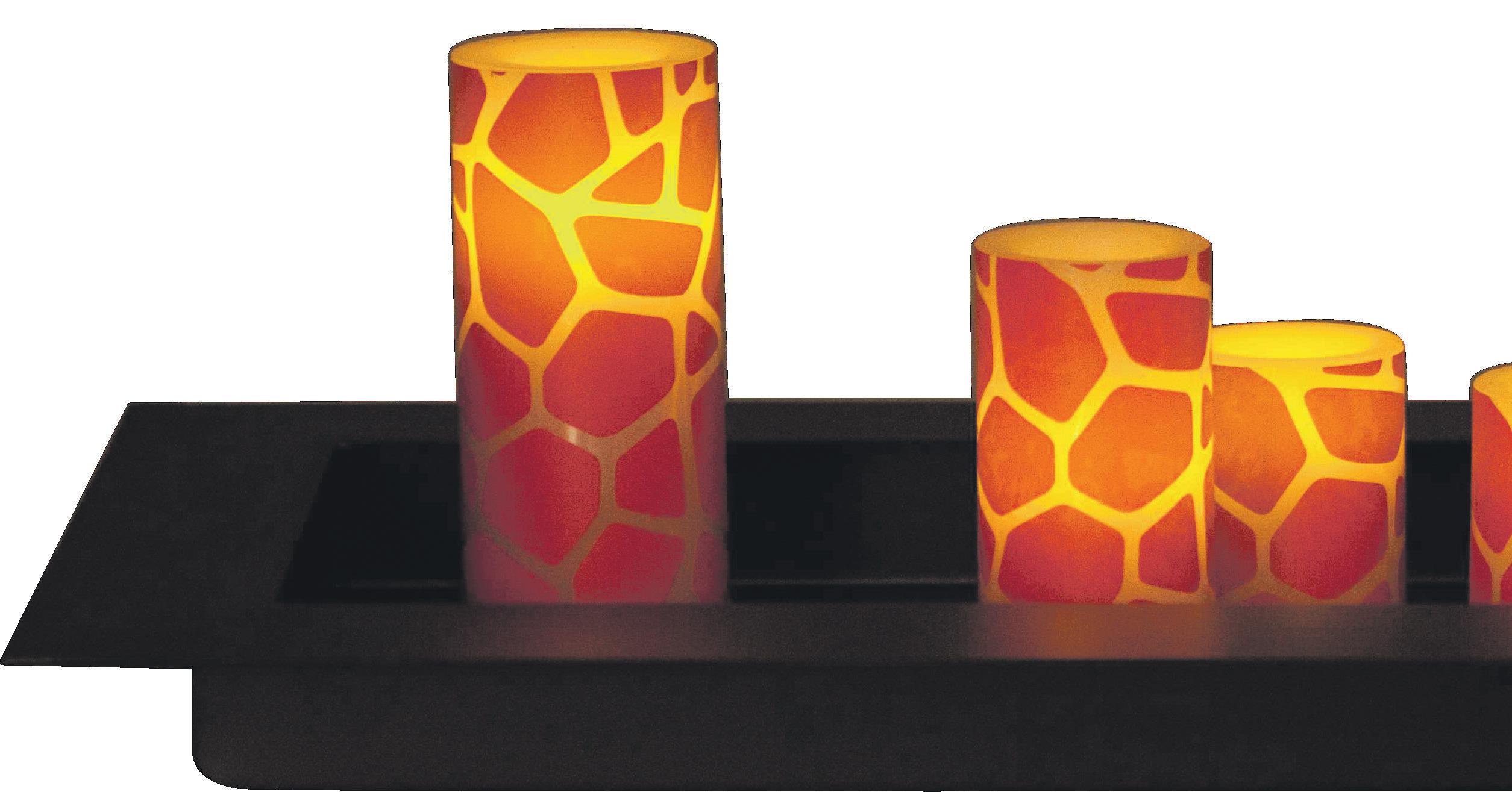


Where would we be without our Diwali parties! The dhamaka that goes with guests arriving all bedecked in their traditional finest,
It’s Diwali with a difference, as our readers innovate on the traditional and introduce a modern touch
everyone brings a plate to make things easier on the host who’s put his home at risk by offering to throw the party. But this time, like the Singhs of Orange NSW, make it a mite different.
“We’re asking our guests to carry a small donation with them, and anonymously place the money in a covered jar at the entrance of our home,” said
out.” It’s a great way to get people thinking of sharing and caring on Diwali, without the pressure of attending a formal fundraiser.
Imagine this: you wake up at 5am to cook a whole batch of traditional sweets to offer guests at the party you’re hosting that night. And at the end of the party, the sweet tray
that ghee and sugar are a deadly combination, and they’re not sure if you’ve used low-fat milk!
This year, in deference to popular trends, make your Diwali spread a healthier one.
How about crudités as a first course, served up differently –individual serves of neatly cut veggies, with their own dip, all in a tiny glass? Not only will they look fab on the table waiting to be picked up, they will also be easy to walk around with. You could do the same with the main meal. In addition to that delicious jeera or vegetable pulao, have an offering of couscous or brown basmati rice. Baked paneer, instead of curried paneer. Indian spiced quinoa salad, maybe. Stuffed zucchini flowers. Time to bring out that Nigella Lawson / Gary Mehigan / Neil Perry cookbook…. Now how about dessert, a tough one as kheer or malai kulfi may get the thumbs down.
Anita Shetty of Wentworthville NSW has just been diagnosed with diabetes and she has vowed to have a fruity Diwali. “I hope it sticks as a family tradition!” she says.
mangosteen, durian, kumquats, starfruit, jackfruit, rambutans. Fancy!
But don’t cut out all the goodies if you don’t want to: make your usual spread, only less rather than more. You’ll be amazed at how much
Now there are some things that are synonymous with Diwali, like the traditional pooja which is



will get an insight into the festival and who knows, it could mean the start of a better cross-cultural understanding as they reciprocate the invitation to join in celebrating Christmas or Eid. Besides, if you can convince your Aussie friend to get into a sari, think of the amount of hits your YouTube upload of her tripping over would get. It would be an instant hit, Gangnam style!
Diwali decor
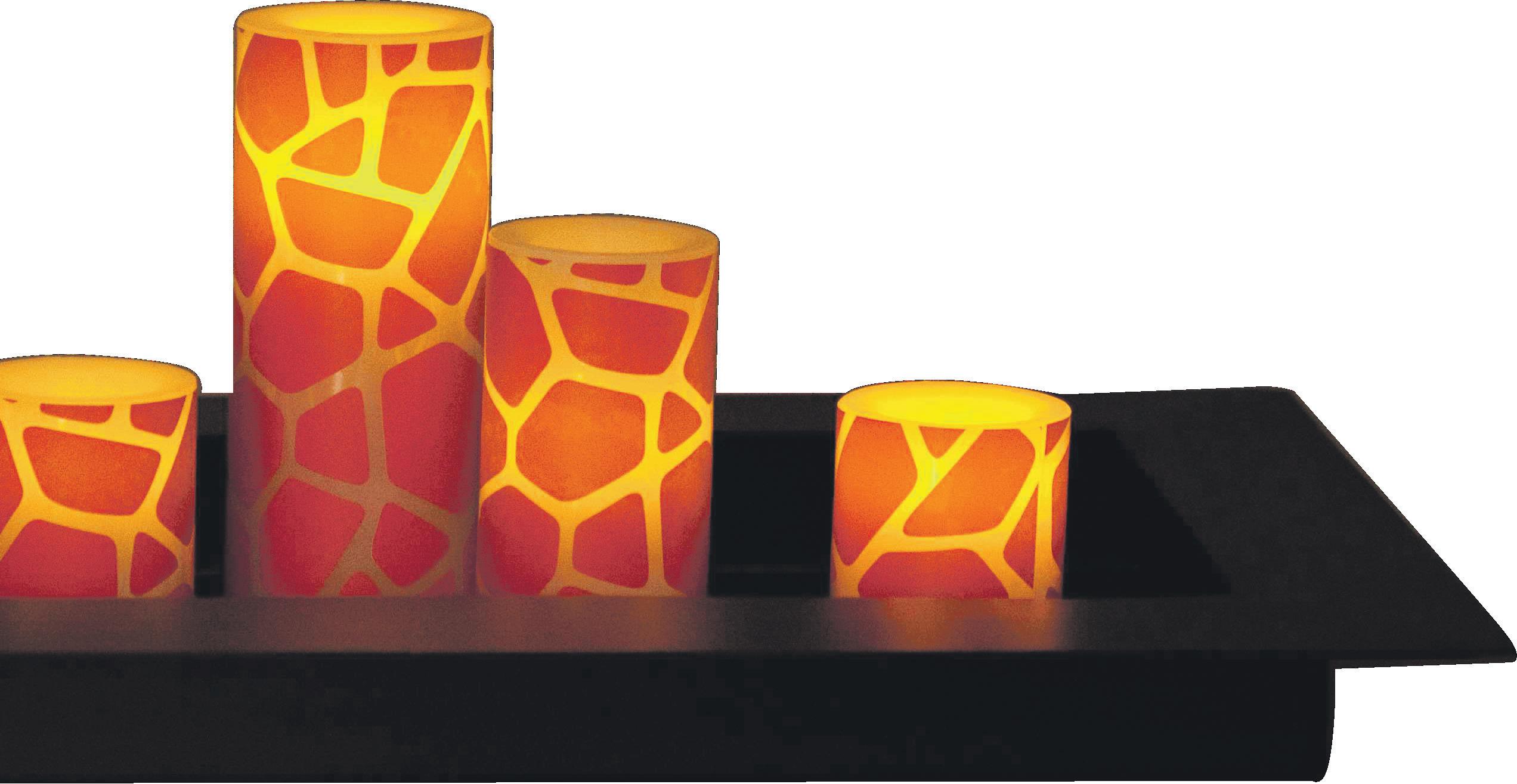
“I haven’t been able to do my traditional Diwali decorations very well in the last couple of years because of our latest family member – the puppy!” bemoans
Nisha Chaman of Perth. The earthern lamps with oil are a clear danger; the floral rangoli is an appealing play area for the canine, and the traditional swastika markings with kumkum-and-rice mixtures have to be completely avoided, as the pup can lick them clean.
“This year I’ve stuck upon a new idea,” Nisha reveals. “Guests are going to see ‘tablescape’ decorations instead of rangoli and lamps.”
In a sample tablescape that Nisha made up for us in her elegant Nedlands home, she picked candles of different sizes and laid them out on some satin fabric, adding matching rocks in silver, as well as rock dust

Sharmas down the street do the same thing, and their home always has a cheerful, festive look on Diwali”.
on our doorstep is also a good idea, but it’s likely to be smeared off in the first ten minutes, so chalk would be a better option” says Meera Joshi from Kellyville NSW. “By slightly wetting the chalk before making your design, it tends to stay put for a while longer, instead of getting smudged designs are a great way to get your kids involved in creating unusual artworks, with possibly a few Aboriginal designs in
different colours too.

“Inside the house we’ll put up the usual streamers,” Meera adds, “but my older son has now taught me that origami is a breeze when you watch how it’s done YouTube. We will end up making festive lanterns in different colours, hanging them at strategic points in the house”.


The tradition of playing cards on Diwali is an age-old one, and the only day in the year on which you can legitimately gamble. Legend has it that the Goddess Parvati played dice with her husband Lord Shiva on Diwali, and she decreed that whoever

reason to play flush, rummy or teen-patti! Kulwinder Singh has planned a big do this Diwali.
“I’m planning to get the players to pledge to donate a small percentage of their winnings to charity,” he says.

“They’re already having a go at me for making this year a ‘donate to Diwali’ affair,” he adds, tongue in cheek. And if you’re not into gambling, bring out the UNO or memory card game, and maybe Lady Lakshmi will smile on you for the rest of the year.

Many of us would think it isn’t fair to have to spend a quiet Diwali without the customary noise pollution brought about by lighting crackers at any time of the day or night. But most others would be grateful for undamaged eardrums, clean air to breathe and the absence of toxic fumes. Visiting India during Diwali a few years ago, the sight of a thick pall of smoke hanging heavily on the city for several days was an appalling sight. Firecrackers, proudly called atom bombs, would go off literally in our backyard at 4am, while the staccato sound of fireworks going off reverberated in the distance through the night. People living in India are used to the noise, but imagine creating that kind of din on your quiet street. You’d have half the police force armed with tasers and the like in your backyard, eager to join the revelries.
“We usually confine ourselves to sparklers excitement as fireworks and everyone is happy to participate”.




So this year, do something different to make Diwali more meaningful and memorable. Make sure you take lots of photographs to feature in next year’s Indian Diwali special!


 Photo: Pinky’s Pantry
Photo: Pinky’s Pantry
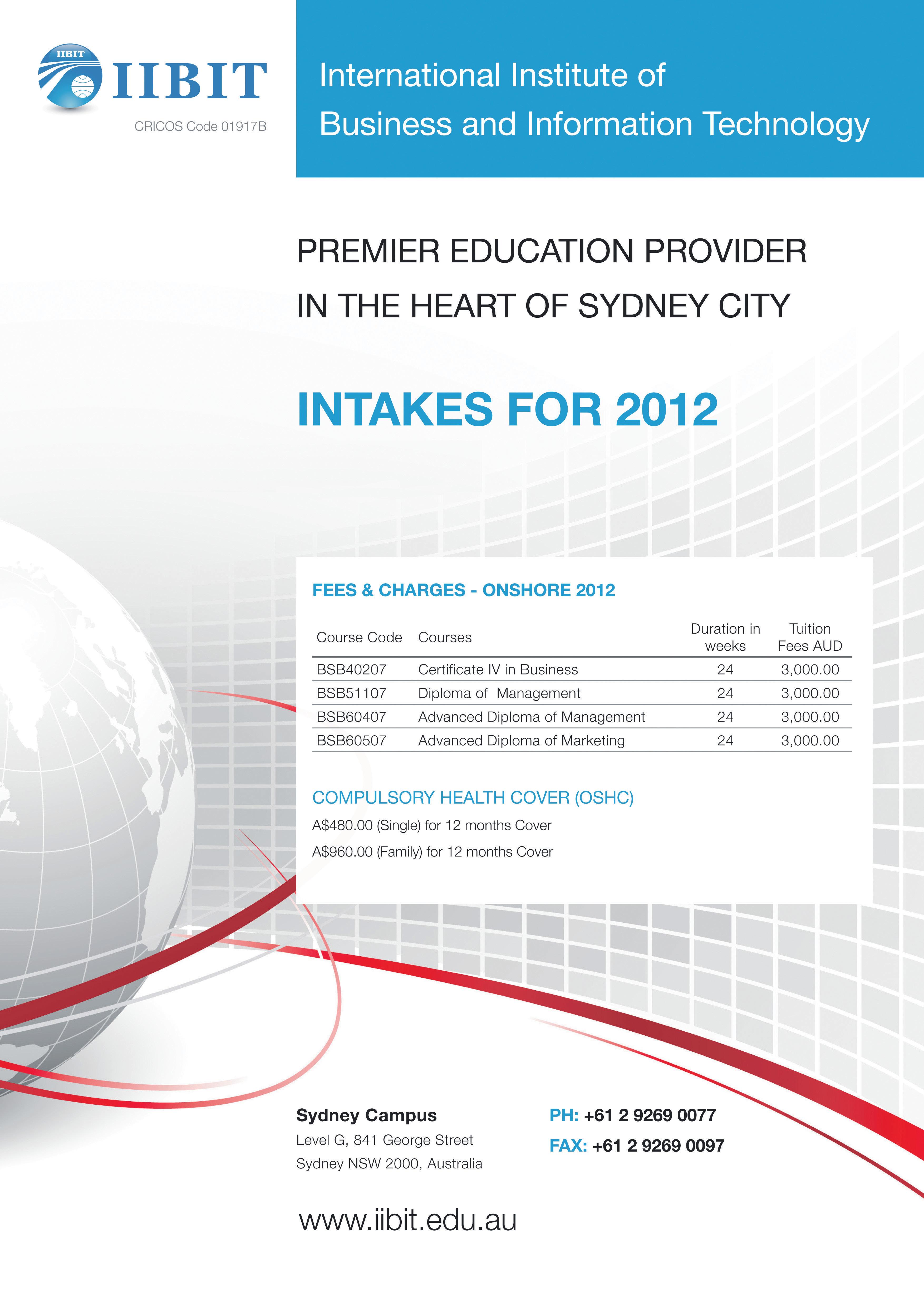









Abust of former Indian Prime Minister Rajiv Gandhi was unveiled at the University of Technology, Sydney (UTS) on October 18.
The bust was presented to UTS by the Indian Council for Cultural Relations (ICCR), New Delhi, which is part of the Indian Government. Mr Arun Kumar Goel, Consul General of India in Sydney, and UTS Vice-Chancellor Prof. Ross Milbourne officially marked the donation of the bust by placing a garland around it. The ICCR has established the Rajiv Gandhi Visiting Chair of Contemporary Studies at UTS, its first academic chair in Australia.
Political scientist Prof. Ujjwal Kumar Singh from the University of Delhi was the first academic Rajiv Gandhi Visiting Chair this year, and nominations are now being taken for the next incumbent.
The question on some of the attendees’ minds was, why Rajiv Gandhi?
Prof. Milbourne expressed his pleasure at receiving the former prime minister’s bust at UTS and conveyed his admiration for him.
“I personally am pleased about it because I have always, as an economist, regarded Rajiv Gandhi very highly,” he said. “And for those who may or may not know, he really was one of the great fathers of economic modernisation. He laid the foundation for a lot of deregulation, and a lot of the
economic growth that we’ve seen in India has come from the work he did. So it’s a particular pleasure for me as an economist, to have his bust here.”
Mr Goel also expressed his joy at unveiling the Rajiv Gandhi bust, saying that this gesture is not only an example of growing relations between the Consulate General of India in Sydney and the University, but is happening ‘at a very opportune time’, right after the establishment of the Rajiv Gandhi Chair. He also heaped praises on the former prime minister.
“As you all know, Rajiv Gandhi was considered to be a most visionary prime minister; the rare prime minister who understood India’s problems. After leading
the Congress to a major election victory in 1984, he brought about many important changes in the political and more importantly, in the economic landscape,” he said.
Mr Goel also added that Rajiv Gandhi initiated the process of economic liberalisation in 1985.
“When asked how he would like to be remembered, Rajiv Gandhi said he would like to be remembered as someone who brought India into the 21st century parallel with the most advanced countries in the world, out of the branding of India as a developing country to the status of a developed nation,” he added.
Prof. Milbourne said Australian Prime Minister Julia Gillard’s visit to India recently had refocused attention on the
importance of India as a major world and regional power and the opportunities for Australia through trade, investment and education.
“Cultural and social understanding between neighbours is crucial to achieving positive outcomes,” he said.
Rajiv Gandhi (1944-1991) was the sixth Prime Minister of India (1984-1989). He took office after his mother, Indira Gandhi, was assassinated on October 31, 1984. He was the youngest Prime Minister of India to take office at the age of 40, and he was tragically assassinated on May 21, 1991. He was posthumously awarded the Bharat Ratna, India’s highest national award, in 1991.
Rajiv Gandhi laid the foundation for a lot of deregulation, and a lot of the economic growth that we’ve seen in India has come from the work he did (Prof. Ross Milbourne)
“Rajiv Gandhi said he would like to be remembered as someone who brought India into the 21st century, parallel with the most advanced countries in the world, out of the branding of India as a developing country to the status of a developed nation (Mr. Arun Kumar Goel)




The Indian Consulate in Sydney welcomed the announcement by NSW Premier Barry O’Farrell in India that international students will be eligible for travel concessions of upto 35%.
Mr Arun Kumar Goel, Consul General noted that it was significant that the announcement was made in India and on the very first day of the Premier’s visit there, even though students from across the world enroll at educational institutions in the state.
Mr O’Farrell made the announcement on Oct 30 while on a week-long trade and investment mission there, his second so far.
With this, one of the major recommendations that had come out of the students’ crisis of 2009-10, now becomes policy.
(NSW and Victoria are the only states not providing this facility so far).
The Premier said international education is the state’s secondbiggest export industry, worth $6 billion.
“We have world-class universities, vocational institutions and research organisations, but we need to do more to attract international students seeking high-quality education, cultural and employment experience,” he said. “The travel concessions will increase the attraction of NSW as an ideal location for further education and provide better access to safe and affordable public transport options for overseas students.”
The concessions apply to all forms of travel, not merely to and from students’ place of study.
This year 10,200 Indian students are enrolled at educational institutions in NSW, the second largest number from any country.
Another major announcement by the Premier was a new annual scholarship for an Indian student at the University of Wollongong.
The scholarship, named in honour of Sir Don Bradman, has been established by the University of Wollongong (UoW) and the Bradman Foundation.
Mr O’Farrell said the annual scholarship would be awarded to a male or female Indian student who had completed secondary school and demonstrated academic, sporting, personal and social skills as well as strong participation in cricket. It will waive 50 per cent of their chosen degree’s tuition fees – making the scholarship worth about $11,000 per year.
University of Wollongong
Ambassador to India and former Australian cricketer Adam Gilchrist, who was present on the occasion, said, “Sir Donald Bradman left an enduring legacy to the game of cricket with his incredible achievements - Indian cricket fans understand that as well as anyone,” Mr Gilchrist said.

Professor Paul Wellings said the UOW Bradman Scholarship was an indication of the growing strength of the University’s ties with India, as well as with the Bradman Foundation.
During the one-week trade mission Mr O’Farrell will visit Mumbai, Hyderabad and New Delhi for a series of meetings with senior Indian government officials, business leaders and investors.
Aiming to strengthen trade with India, Australia’s state of Victoria opened its second business office in India on 29 Oct.
To mark the opening, a Rs.1 billion agreement was signed between Victorian company SenSen and Mumbai’s L&T IDPL to deliver video-based, through CCTVs, data analytics technology to the latter.
The technology would be deployed at road toll posts across India and address the major problem of traffic congestion in the country.
The software provided by SenSen will recognise and accurately capture number plates in any language, in any font, size or configuration and pass the information directly to the billing mechanism.
Louise Asher, Victoria’s MP and Minister for Innovation, Services, Small Business, Tourism and Major Events, officially threw open the office at Nariman Point in south Mumbai.
“The deal between SenSen and L&T IDPL further enhances Victoria’s reputation and leadership in ICT (information and communication technology). It emphasises the outstanding talent at home and hi-tech capabilities locally that are ready to benefit the world,” Asher said.
The minister added that Australia already had established partnerships with other major companies in Maharashtra, like Mahindra & Mahindra, TCS and Aegis, which have significant investments in Victoria.
“Within the IT sector, nine leading Indian IT companies, including Wipro and Infosys, have invested in Victoria. We believe that our commitment to
India is for the long term and are positive that it will only grow in the future,” Asher said.
Victoria’s two-way goods and services trade with India has been valued at approximately $2 billion in 2011-12. The Victorian government runs an active programme of trade missions to India to create new business opportunities between the two economies.
On her third visit in the past 18 months to India, the minister is leading a strong business delegation to India to boost trade ties.
An Australian documentary producer and his wife were prevented from entering Idinthakarai on Oct 25, the epicentre of the protests against the Kudankulam Nuclear Power Project (KNPP) in Tamil Nadu, said police in Chennai.
According to police, David Bradbury a documentary filmmaker and his wife were stopped near Idinthakarai in Tirunelveli district, some 650 km from Chennai, from proceeding further and were taken to
Radhapuram police station.
Nuclear Power Corporation of India Ltd (NPCIL) is setting up the KNPP at Kudankulam with two Russian-made VVER 1,000 MW reactors. Villagers in Idinthakarai have been opposing the plant for more than a year fearing for their lives in case of a nuclear accident.
According to police the Australians were told that their activities were not in line with the kind of visa they possessed.
Police said the Australians went back to Nagercoil, around 40 km from
If you held a student visa on 8th february 2010, you can use old Skilled occupation list (Sol as at 08/02/2010) to choose a suitable occupation from that generous Sol and apply for skilled Graduate visa (S/C 485). or
If you had applied for subclass 485 visa prior to 8th february 2010 or you held a subclass 485 visa on 8th february 2010, you can use old Skilled occupation list (Sol as at 08/02/2010) to choose a suitable occupation from that generous Sol and apply for subclass 885( Skilled residence) , subclass 886 (Skilled Sponsored residence ) or Subclass 487 ( Skilled Regional Sponsored – Provisional ). You can also use old points test. You Must Lodge above applications prior to 1st January 2013. Contact us to assess your possible options if you think that you are one of those lucky applicants who can avail the above generous transitional provisions.
We can also help you with the following applications: expression of interest, Skilled migration, Graduate skilled, State sponsorship, partner visa, Skill assessments, Student visa, employer nomination scheme , rSmS, Work visa subclass 457, Visitor visa, resident return visa, entertainment visa, mrt & aat reviews.
We have recently formed collaboration with regulated Canadian Immigration Consultant” practise in Canada We can now also arrange a free assessment for your Canadian visa options. potentIal applICantS
CooKS and other suitable applicants Can be sponsored by Canadian employers for work visas.

assistance is also available for following Canadian visa applications.

If your application has reasonable prospect of success, “regulated Canadian Immigration Consultant” will advise you in writing of the application process, fees & charges associated with the application.
Suite 1, level 1, 127 Burwood road, Burwood, nSW 2134
email: ajagota@iprimus.com.au phone: 02 97476071 fax: 02 97474031
AmRIT PAL JAgOTA 0414 338 423 (marn: 0532014)
mAnVInDER K JOSAn 0410 719 375 (marn: 0962796)


Web address: www.theimc.com.au



Finance is subject to standard credit criteria and approved applicant


Many people associate Bollywood with song and dance, colour, glamour, stars, fantastic locales – everything about it is larger than life. But there is another side to Indian cinema where characters and locales are steeped in reality, depicting a living and breathing India with all its joys and challenges, that tells the story of its people in a way that touches one’s soul. Variously called alternative, niche, new wave and art cinema, this cinema has counter-balanced the so-called Bollywood arm of the industry.
On October 26, UNSW’s Australia School of Business (ASB) hosted a presentation and panel discussion on marketing the new wave of Indian cinema, as part of its Marketing in AsiaSpeaker Series. The event was called ‘Beyond Bollywood: Marketing the new wave of Indian cinema’, and was well attended. The context was set by senior marketing academic Ashish Sinha, who delivered a well-researched view on cinema and its economics; whereas new wave cinema director and producer Partho Sen-Gupta provided his practical insights while actually producing films.

Ashish Sinha, producer and head, School of Marketing at ASB spoke on the concept of vital few and trivial many, and how the advent of alternative channels of distribution is radically changing the nature of Bollywood.

The central tenet of Ashish’s thesis rested on the argument that the creative act does not happen in a vacuum, and focusing on the creative work or the creative person is only half the story. The other, perhaps more important half is the system in which the creative person exists. The creative work is a product and sometimes a by-product of the system in which the creator is operating. Cinema is no different, and the systems in place can enhance or hinder creativity. In this talk, Ashish focused on the connection between the economics of doing business, in common parlance referred to as the ‘revenue model’, and the creativity in both Hollywood and Bollywood. He looked at the role that different channels of distribution – digital and online, play in fostering an
environment in which creativity can flourish. Ashish made the point that Hollywood is getting disrupted as theatrical releases are often no longer a requirement for movies to become successful. This is because of the advent of services such as Netflix, which boasts of having more than 75,000 movies and 16 million subscribers; and iTunes that in theory or principle has virtually no cost of carrying inventory. Most of these movies being made available are independent movies.
Traditionally, Hollywood (the big studios) have had a stranglehold on the motion picture industry through absolute control of the theatrical channel, thereby literally pushing out content that it felt threatened its power – independent movie producers are a good example of the same. But these independent movie producers have now the ability to earn revenue distributing their movies through alternate channels of distribution. This is the very reason why the independent movie movement is becoming a force to reckon with, and one that is disrupting Hollywood. This is because niche content is now becoming available to the masses.
However, the lack of such channels in India has led to independent movies becoming a fringe movement. This is not
because of the lack of talent, ability or expertise; rather an outcome of the lack of the channels of distribution that are available in Hollywood. Piracy pretty much kills auxiliary channels in India and does not provide the opportunity for both, Bollywood and independent movie producers, to garner revenues from this channel. This stifles creativity in the sense that the niche content that is being made widely available in the US is not available to the same extent in India.
Partho Sen-Gupta, writer and director of the award winning feature film Hava Aane Dey (Let the wind blow) spoke about his experience with the Indian as well as international film industry. He focused on financing and marketing the film, and the many lessons that he learnt.
Partho is preparing to direct and produce his newest venture, Arunoday (Sunrise). He explained the unique financing method of ‘crowd funding’ that he has deployed in his latest project. Crowd funding means that money for creative projects is raised collectively from a lot of interested people who are keen in seeing that project succeed. These hundreds or even thousands of investors share in the success of the project as they are given shares or other benefits in return for the
extent of their financial support.
Partho informed the audience that Sunrise has already been crowd funded to the extent of $71,000. The funders receive a title that ranges from co-producer, associate producer, lover, patron all the way to buddy, fan or friend, depending upon the extent of their contribution – from $15,000 of a co-producer to $10 of a friend. While a co-producer receives equity in the project, a friend receives a thank-you card from the film crew. An ally, who has paid $200, receives a DVD, poster, name on the film credits and a thank you card.
Besides financing, the upcoming director and producer discussed new ways of marketing employed in the Indian film industry. These revolve around an improved distribution brought about by digital prints, the role of the internet and social networks, and targeting of smaller niche audiences as opposed to mainstream films meant for everyone.
Overall, it was an interesting evening when the audience, many of who comprised students and teachers of marketing and cinema, learned the highly evolved marketing and distribution of Indian cinema, especially the cash-starved genre alternative cinema and how it is changing.
The advent of alternative channels of distribution is radically changing the nature of Bollywood.
Ashish Sinha
Crowd funding means that money for creative projects is raised collectively from a lot of interested people who are keen in seeing that project succeed Partho Sen-GuptaFilm-maker Partho Sen-Gupta and marketing academic Ashish Sinha at the UNSW event
PoSition vACAnt Parkus
We are 24 hours reputed Fuel Station in Sydney NORTHERN BEACHES.
We are currently looking for enthusiastic Full time / Part-time Customer Service Attendant.
• Mature minded
• Ability to work a flexible roster which may include weekends, evenings and public holidays across 7 days of the week (minimum 2 nights a week)
• Communicate effectively with customers
• Work in a fast paced environment
• Portray a positive attitude
• Ability to work independently and without supervision
• Project a professional image at all times
• Deal with customer queries and complaints
• Abide by company policy and procedures at all times
• Australian permanent residence or citizen
• Previous experience in service station will be an advantage
• This role will be suitable to someone living in Northern Beaches or having own transport.
Please forward your resume to retailjobs.sydney@gmail.com
TRAINING:
Transition is easy with our short term courses
Little or no knowledge of networking?
Don’t worry we can start from basic and fast track.
Why not talk to us... There are many options available
Parkus is a CISCO authorised Learning Partner. offering courses in Sydney & Canberra.

We provide Microsoft & Juniper training as well.
GOVT. FUNDED COURSES
We also provide Small Business CertIV course (Govt.Funded)

In association with our partners in Sydney & Canberra

JOB OFFERS:
We need Cisco/ Juniper Network Expert Engineers who can work on either full time or part-time contracts.
CCIE, CCNP, JNCIE, JNCIP and JNCIS certified engineers apply now.
TEST CENTRES:

We have our testing centres opened all days including weekends
Call us on: 02 9633 2003 or email: info@parkus.com.au


It was a very special day for Resourceful Australian Indian Network (RAIN) seniors as they gathered at Club Central in Hurstville on October 4. They were present at the St George Community Awards and were pleased and excited to receive the award for Community Group of the Year in the St George area.
Sixty awards were presented to community groups and individual volunteers, recognising their services to the community. Over 400 people attended the awards ceremony and applauded the winners.
The award to RAIN was presented by special guest Andrew Scipione, NSW Commissioner of Police, along with Mark Coure, State MP for Oatley. Dr Sudha Natarajan accepted the award on behalf of RAIN, in her capacity as the organisation’s public officer.

“The awards are a way of saying thank you to the many volunteers and community organisations that work to make our area a better place,” said Mr Coure, in a press release. “I believe that it is very important
that we recognise the services that our volunteers provide, they are truly the glue that holds our community together”.
“Needless to say, the RAIN seniors are undoubtedly highly excited at receiving this important felicitation and being recognised
for their efforts,” said Dr Natarajan.
“We are grateful to Mr Mark Coure for recognising our services to the community. RAIN will continue its services with extra vigour and enthusiasm in the coming year,” she added.
It is a particular honour for RAIN to be felicitated for all their good work in the St George area. Established in 2006, RAIN has been pioneering ethnospecific senior care for the Indian subcontinent community in St George and Sutherland Shire,
The gentle sound of tinkling bells, soft bhajans and prayers of earnestness accompanied the nine-day celebration of the kolu or doll festival, crowned by Viyajadhasami on the tenth day. This was celebrated at the RAIN (Resourceful Australian Indian Network) senior care and community aid centre at Penshurst. Seniors unable to participate in vigorous garba activities gently swayed to the music with ease and experience, before sitting down with a smile to share refreshments and memories of past celebrations and younger days with friends. Some have been friends for over half a century now, and have shared happiness and sorrow along the pathway of life, with their experiences making them closer. The first three days of Navratri began with Durga pooja, presided over by Mr Amratlal Bhatt, with his wife Jayabehn assisting him. Dr Meenakshi Karthikeyan also attended as a special guest.

The group was treated to a talk on the concept and special significance of the South Indian Navratri kolu Kolu is a doll display arranged on odd-numbered tiers, often to a theme. In this particular case, the theme was the theory of evolution. This was depicted in stages through the arrangement of dolls, with the first steps occupied
in response to the community’s needs. RAIN’s vision is to provide creative and knowledge-based and positive diversion in the lives of seniors within the Indian subcontinent community.
With values like positive attitude and self help, respect for old age, promoting dignity in old age, community networking and effective fieldwork, RAIN has proved to be not just supportive, but encouraging towards seniors from the Indian subcontinent.
With a strategic focus of continued organisational growth, better facilities for social inclusiveness of Indian subcontinent seniors, the introduction of a life long learning centre activity room and the aim of building a stronger community network, RAIN looks forward to the years ahead with enthusiasm and passion. Thanks to the total commitment of the management team as well as effective teamwork by efficient partners and most importantly, the support of the community, RAIN acknowledges the award and is grateful to all those who have contributed to its success.
by figures of plants and animals, and then proceeding upwards with the steps above occupied by human dolls in various colourful attire from different walks of life. Above these came the ‘seers’ or ‘teachers’ saints and sadhus, while the top three steps were occupied by the gods and goddesses, Ganesha, Durga, Lakshmi and Saraswathi.
The display was enthusiastically put together by members of the group hailing from the south of India. Our celebrations have a way of teaching our youth respect for education and the moral value of being righteous. The nine days are significant of the Goddess Durga fighting the demon, and the tenth day is a celebration of her jubilant victory, that of good over evil which should be celebrated in everyone’s mind as happy living comes from virtuous thoughts.
The Navaratri celebrations with intergenerational activities were funded by the Illawara Catholic Club and the Hurstville RSL Club under the Clubs NSW grants.
RAIN members sponsored the daily poojas and the celebrations also helped raise funds towards the construction of a fence, an immediate need for the safety of the seniors. RAIN also plans to build an access ramp to facilitate easy access for less mobile seniors.
Sudha Natarajan

 By JyOTI SHANKAR
By JyOTI SHANKAR
Dr Kiran Bedi needs no introduction to Indians. Her action packed life has been covered by media through all its stages - National and Asian titles in lawn tennis, the first woman police officer in the IPS, ‘Crane’ Bedi, MSN’s Most Admired Icon of 2011, and now, alongside Anna Hazare, she has been at the forefront of the war against corruption in India.
That Kiran Bedi does not waste time to do things that need to be done was evident in the way she exhorted the people gathered for the charity dinner, recently organised by the Council of Indian Australians at Parramatta, to contribute their mite to social causes, join the fight against corruption and come together as Indians. Hearing about the 200 Indian associations operating in Sydney, she asked if “anyone was willing to put up their hand to bring them together”. When there was none forthcoming, she was happy to take up the mantle herself, if the database of people was made available. Kiran well understands the ability to leverage the power of social networking and tools like Twitter, which can reach thousands.
Fearlessly, all through her life, Kiran has sought to change systems wherever she went. When posted as the Inspector General Prisons of Tihar jail, India’s most notorious jail and home to over 10,000 inmates, many thought she herself had been condemned to the prison rows. But the irrepressible Kiran sought to change the world around her with simple ideas she implemented, that transformed Tihar from a den of evil to a place where inmates could meditate and ponder upon other possibilities in life, educate themselves and learn new skills.
Yes Madam, Sir a film by Australian filmmaker Megan Doneman documents Kiran Bedi’s life, and won the best documentary award at the 2009 Santa Barbara International Film Festival.
Kiran retired from the police service five years ago, but not from the work she is passionate about - prison

reforms and bettering the life of those around her. It was this mission that brought her to Sydney – promoting her charity organisations – Navjyoti Foundation and India Vision Foundation, and garnering the support of non-resident Indians for the fight against corruption.
India Vision Foundation - started with seed money from the Ramon Magsaysay award Dr Bedi wonundertakes prison reform, works to empower women and care for children in prison. These children, whose only recreation was crushing ants in the jail, now attend pre-schools run inside the prison, providing education, nutrition and childcare. Navjyoti Foundation works towards empowering women in rural and urban settings. Sydneysiders can contribute by sponsoring a child, undertaking project-based internships, volunteering at events or teaching, and spreading the good word.
Speaking to the press at a conference before the charity dinner and others at the dinner, Dr Bedi freely and enthusiastically answered questions ranging from her views on politics, her inspiration (parents), Arvind Kejriwal, the non-independence of Indian vigilance bodies, and meditation. She narrated the story of the crane incident that made waves when Prime Minister Indira Gandhi’s wrongly parked car was towed away, earning her the moniker ‘Crane’ Bedi.
“I believe that support from non-resident Indians could be a huge force,” says Kiran.
A website has been formed
to rally NRIs to support the anti-corruption movement, www.nriac.org. This would provide a platform to gain direct information on the anti-corruption movement. Membership fees would support their activities such as leadership building in villages.
When asked about the volteface of Arvind Kejriwal and her decision to steer away from politics, she replied that each one of us has a core personality and we need to be true to ourselves. While she herself has no political bones, she bears no ill-will against Arvind Kejriwal who has left the anti-corruption core group to form his own party. But for her, the simplicity of an andolan is its strength.
“The moment one is a politician, one becomes suspect, howsoever credible and honest a politician he may be,” she comments.
The fall in the standards of bureaucracy and its nonaccountability, is her concern. None of the scams would have happened if civil servants had done their job. Having been one herself, she understands that every file speaks for itself and no actions could be possible without the backing of the bureaucracy.
“The frame of integrity and professionalism that the bureaucracy is supposed to provide to the country has weakened. The Anna Hazare movement is to create a movement of awareness among the population. India has no system of recall and politicians continue for their term in spite of
scams,” she rues.
The Indian scenario could change with compulsory voting, but that has to come along with education of the voter. People should be able to question the politicians for whom they have voted.
“The next two elections will decide India’s fate – if we come together and act as a pressure group to bring about a clean democracy and change the system, we could become one of the finest countries of the world. The ageing populations of the world will need Indians,” she states.
On Nov 24/25, Anna Hazare has called a meeting where he has invited a host of social activists, writers, retired bureaucrats and stalwarts of different fields who have no political affiliations, to form a think-tank and expand his core committee. From January will begin the travels through India to raise awareness about these issues.
When asked what keeps her going and did the seemingly insurmountable problems facing people in India ever make her feel dejected, Kiran, a true Vipassana practitioner and Karmayogi, replies that there can be no dejection if one has no expectation and when one works for no reward. Being blessed with good health, resources, and the capability for work was itself a reward.
The programme was well organised and it is great credit to Council of Indian Australians President Subba Rao Varigonda and his team that they could put together an event of this magnitude.
Hearing about the 200 Indian associations operating in Sydney, she asked if “anyone was willing to put up their hand to bring them together”
“The frame of integrity and professionalism that the bureaucracy is supposed to provide to the country has weakened”
Kiran Bedi






Hundreds of Goanorigin Christians in Australia came out to welcome an ancient relic which was brought here this month from Rome.
The relic of St Francis Xavier – an arm – has been venerated at the Church of Gesu in Rome since it was detached from the body of the saint in 1614. Auxiliary Bishop of Sydney, Peter Comensoli, who coordinated the Australian leg of the tour of the relic, was quoted as saying in The Southern Cross that is “very rare” for the relic of the arm to leave Rome. It is the one with which



St. Francis Xavier baptised many thousands of people.
St. Francis Xavier, despite spending only a few years of his missionary life in Goa, had great love for the land and its people.

After his death his body was brought to Goa to honour his wish to be buried in this land. Since then, Goans have reciprocated that love in abundance and his holy relics have been preserved in the mausoleum at the Bom Jesus Basilica at Old Goa. For the Catholic community of Goa, the Basilica has become a place of pilgrimage with a visit to the holy relics at Old Goa at least once a year, a must.
The Relic in Adelaide Christians in Adelaide rejoiced as they celebrated having the relic of St. Francis Xavier amidst them, at the Saint Francis Xavier Cathedral.
The relic of the famed Jesuit
missionary was in Adelaide from October 14-19, and to mark the event, the Catholic, Goan and wider Indian community marked the occasion through a special Eucharistic celebration followed by a get together. The holy mass was organized by the Indian community with Fr Antony Adimai as the main celebrant, along with five con-celebrants, and was attended by around 700 people.
The homily spoke of the life of Saint Francis Xavier, the patron saint of Goa and Australia. Fr Antony’s sermon was a powerful talk on the five steps involved in the Christian journey of faith, drawing analogies from St. Francis’ life whilst on his missionary services across the globe.
The five steps in the Christian faith cycle are: Faith Received, Faith Personalised, Faith
Witnessed, Faith Celebrated and Faith Proclaimed.
And it was this faith that brought together people from all over Australia to pay homage to this special saint. Every person involved benefitted from knowing that they had contributed towards the making of a wonderful celebration – from the altar servers, readers, ushers, musicians and offertory bearers to every volunteer who gave freely of their time.
Families attended the service from far and wide, travelling to venerate the sacred relic of the blessing arm of Saint Francis Xavier.
People lined up in sombre reverence to touch the casket which housed the relic, seeking the Saint’s blessings and intercession. At the end of the service, the community congregated at the Cathedral Hall to partake
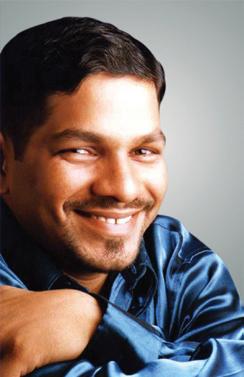
in a Goan meal and witness a presentation on the life of the Jesuit saint, covering his history and spirituality. Children presented a drama based on the Saint’s lifeportrayed through Goan culture. The Goan community was particularly instrumental in raising awareness of the relic in Adelaide.
Bryan Fernandez of Goan origin who coordinated the event stated, “In this year of faith, may we come together as a united family in Christ and support each other through the cycle of our Christian faith, just like Saint Francis Xavier did all those years ago.”
Blaise Fernandes said, “The event is a reminder of St Francis’ life and how he left name, fame and wealth simply to serve the Lord.”
The relic next travelled to the Port Pirie Diocese in South Australia, as part of its Australia tour.


The relic of St Francis Xavier was welcomed with great honour by the Konkanni Cultural Heritage Inc. Victoria, a Goan community along with the other communities at the Chapel of Monash University, Clayton, Victoria, Australia on Sunday 7th October 2012.
The Relic was moved from the hearse to the altar with great honour by the organisers. It was greeted by the people with lit candles and a hymn played on saxophone by Derek Stuart as the procession moved to the altar.
The Mass was celebrated by five priests, Fr. Anthony, Fr. James, Fr. Eugene, Fr. Rolio and Fr. Robin being the main celebrant, whilst the eight-member choir was organised by musician Joe Fernandes.

Fr. Robin celebrated a welcoming liturgy and gave a beautiful sharing about the Relic and the life of St Francis Xavier thereby linking the Saint to our times and this Year of the
Grace. 700 people of different communities including members of Goan associations attended this Eucharistic celebration which was followed by veneration of the Relic.
Generally the feeling was one of gratitude for the presence of the Relic and the work involved in bringing the Relic to Australia. One of the attendees noted, “We were grateful to be able to spend time in the presence of the Relic of St. Francis Xavier. The experience enabled us to consider prayerfully the great sacrifice he made to spread the faith and prompted us to consider our role and responsibility in sharing this great gift of God”.
It was rather special for all in the community to be able to view the relic closely and thanked the Konkanni Cultural & Heritage Inc. for making this possible – in particular Mario Carvalho and the organising committee Jude and Saroj Desa, Vernon and Corryne Da Gama, Titus andUrsula Fernandes, Simon and

Nancy Mendonce, Royden and Lidia Rodrigues, and Cherylanne Carvalho, who personally thanked the Priests, the choir, Archdiocese of Evangelisation, Richard, Monash University, the sponsors, the ushers and others who helped in this great Eucharistic celebration.
Many people commented afterwards how special the evening was and how they experienced the grace and blessing of Almighty God through the life and ministry of St Francis Xavier.
The Relic had a great reception everywhere in Australia.
Centuries ago when Goa was under the Portuguese rule, Sambhaji, the Maratha chieftain from North attacked Goa and was all set to conquer the land. The then Portuguese Governor is chronicled to have visited Old Goa and prayed to St. Francis Xavier in the night, and is also supposed to have opened the coffin and picked up the saint’s sceptre.
The next morning, Sambhaji withdrew from Goa and rushed back to protect his own land which was under attack on its Northern border from the Moghal forces. This change of scenario was attributed to St Francis Xavier’s intervention, and since then he has been considered as the saviour and protector of Goa. Probably that is why he is called ‘Goencho Saib” (The man from Goa) The novena of the feast of St. Francis Xavier during November and December is indeed a revelation to understand how much Goans venerate this saint. Not only Catholics, but all faiths including Hindus and Muslims visit Old Goa to pay obeisance to the Saint in significant numbers. The irony is that St. Francis Xavier who has been installed as the Patron of the missions, was never the Patron Saint of Goa. However, Goans believe that he is their Patron who looks after them and protects them from all evil.
People lined up in sombre reverence to touch the casket which housed the relic, seeking the Saint’s blessings and intercession
The irony is that St. Francis Xavier who has been installed as the Patron of the missions, was never the Patron Saint of Goa
Medical interviews are different from normal interviews and seek specific qualities. They happen right after your HSC exams so, for:
TUITION FOR MEDICAL INTERVIEW PREPARATION by a current medical student: Contact yashutosh on 0402 788353
I’m experienced at interviews, having been to many myself two years ago and having tasted success not only in medical interviews but for scholarship and cadetship interviews as well. I’m proud to say that last year 95% of my interview students were successful in gaining entry into MBBS. It’s all about preparation and knowing how to present oneself for the optimum outcome.
Make the most of the opportunity now and ace those interviews!
ALSO A FEW VACANCIES LEFT for September 2012 and January 2013 school holiday classes of

PERSONALISED TUITION FOR UMAT 2013 and HSC English Advanced
SyDNEy JAIN MANDAL
Celebrate Mahavir Nirvan (Diwali)
Date: 18th November 2012


Day: Sunday
Time: 8:45am for 9.00am start
Place: Sri Mandir 286 Cumberland Rd, Auburn, NSW
Program: - Pooja starts 9am (please bring your own pooja samagri) - Cultural program 10.30am - 12.00pm
Followed by Jain delicious lunch
Catering by Famous Sydney caterer
For more information. please contact Abha Jain on 0432 248 791 or Mukesh Jain on 0425 247 575

A HoMoeoPATHy CeNTre
iN THe HeArT of SyDNey. A safe, gentle and natural solution to your health problems.
Homoeopathy can treat various kind of acute or chronic disorder in all age groups including. To name a few acne, eczema, psoriasis, hair fall, IBS (Irritable Bowel Syndrome), flatulence, indigestion, heart burn, constipation, piles, Sinus problems, adenoids, tonsillitis, hay fever, Allergic problems, cough and cold, asthma, backache, stiffness, sciatica, premenstrual syndrome, menopausal syndrome and other female problems, anxiety, depression, memory and concentration issues, sleep disorders, headaches (e.g. migraine), kidney stones and infections, thyroid disorders and more.
Contact Consultant Homoeopaths for Consultation or medicines.

Consultant Homoeopaths:
0431 818 552
Jaya Chander Madhurakavi
B.H.M.S. M: 0430 322 757
www.homoeopathyplus.com.au 1/15 (First Floor), Station Street Wentworthville NSW 2145



Comedian and actor Aziz Ansari’s show on October 9 at the newly refurbished Hamer Hall in Melbourne was a thumping success. The Hall that accommodates 2464 patrons was almost full, with the audience a mix of all sexes, ages and races. Of course, in this age of the internet, news spreads fast, and Ansari’s cyber fan club already has a large following, especially among young people. It was no surprise, therefore, to see young people queuing up for the show well before time for his stand-up comedy show, Buried Alive. Ansari regaled the audience for more than an hour, keeping them in stitches with jokes and witticisms coming in fast and furious! He held it together under a broad theme which embraced datingmarriage-sex – so there was never a dull moment, no long pauses –and somehow was also a kind of social commentary. This is his first tour of Australia, and despite the largely American slant, he seemed
to have no trouble at all relating to the Melbourne audience which gave him a standing ovation at the end of the show.
Aziz Ansari was born in Columbia, South Carolina, US, to Tamil parents who emigrated from India. His father is a gastroenterologist, and his mother Fatima works in a medical office.
Ansari grew up in Bennettsville, South Carolina where he attended the Marlboro Academy. He began his career performing stand-up comedy in New York while attending New York University, at venues such as the Upright Citizens Brigade Theatre frequently. In 2005, Rolling Stone included him in their annual ‘Hot List’ as their choice for the ‘Hot Standup’, and he won the Jury Award for ‘Best Standup’ at HBO’s 2006 U.S. Comedy Arts Festival in Aspen, Colorado. Ansari tours colleges and music festivals occasionally, and has also toured with the Comedians of Comedy and the Flight of the Conchords. Ansari headlined his own comedy tour, the Glow in the












(ABN- 91 761 820 052)
For queries on July’12 changes, Skill Select and Expression of interest call now at 0433 986 780 0421 119 628
Free consultation for 15 minutes or via email
i) Advice on Migration pathways
ii) General Skilled Migrationspecialist
iii) Student Visas( new and extension)
iv) State Sponsored Visas / ENS / RSMS / 457
v) Business Migration
vi) Partner and Family Migration specialist

vii) Admission in Australian Colleges and Universities
• MRT Review procedures in Australia
• OCI / POI / Indian Passport Application / Renewal
We also specialize in Home / Commercial Loans (MFAA Certified) specialist
Contact:
Sonal Agrawal Syed Mohiuddin (JP) Ex-Visa officer


MARN:1169617, MMIA:5385 MARN:1171248, MMIA: 1021, MFAA:54385
Level 2, Suite 8A, 48 Macquarie Street, Parramatta, Australia 2150
PH (02) 86775161, FAX: (02) 98916314
Email: contactus@completemigrationservices.com.au


(We Speak English, Hindi, Marathi, Urdu, Telugu)
For quick visa assessment fill the online visa assessment form on www.completemigrationservices.com.au
We help you achieve a better life and pursue your dreams
PM deals
Prime Minister Manmohan Singh sought to shake off the perception of an inert government with a major revamp of his council of ministers, inducting 17 new faces and elevating five to cabinet rank, in what is possibly the last rejig before the 2014 elections. The new portfolios were announced on October 28.
Congress general secretary Rahul Gandhi did not join the government - leaving the field open for him to play a larger role in the party.
Several key portfolios changed hands, some new faces were introduced, some elevated to cabinet rank and at least one old face - Shashi Tharoor - was back in an exercise that jettisoned tainted ministers like Subodh Kant Sahay and roped veterans like Ambika Soni and SM Krishna back into the party organisation to gear up for the 2014 electoral battle.

“It is a combination of youth and experience,” Manmohan Singh said after the ceremony at the Rashtrapati Bhavan where President Pranab Mukherjee administered the oath of office.
“The road ahead is full of challenges,” he said, expressing hope that this was the last such exercise before his UPA-II government heads for elections.
Of the seven new ministers sworn in with cabinet rank, two are debutants - former
Rajya Sabha deputy chairperson K Rahman Khan and Congress MP Chandresh Kumari Katoch. The other five - Ajay Maken, MM Pallam Raju, Dinsha Patel, Harish Rawat and Ashwini Kumar - have been elevated to cabinet rank.

Fifteen ministers of state were also sworn in.
In the reshuffle of berths, Salman Khurshid, who has been battling allegations of graft, got external affairs. His previous ministry, law, went to Ashwani Kumar. Khurshid had served as junior foreign minister under PV Narasimha Rao in the 1990s.

Pallam Raju was made human resource development (HRD) minister in place of Kapil Sibal, who was left only with communication and IT. Pallam Raju’s minister of state in HRD was Tharoor, who had to resign as minister of state for external affairs in 2010 over a controversy regarding his alleged conflict of interests in the affairs of the Kochi IPL cricket team.
The crucial railways ministry, which had long been with one-time ally Trinamool Congress, was given to PK Bansal.

M Veerappa Moily was given petroleum, while his previous responsibilities of corporate affairs and power were splitSachin Pilot was elevated as minister of state with independent charge of corporate affairs and Jyotiraditya Scindia got independent charge of power. These two ministers are known to be close to Rahul Gandhi.
Rawat was made water resources minister and Katoch union culture minister. Maken was elevated as housing and poverty alleviation minister and Dinsha Patel as mines minister.
S. Jaipal Reddy got science and technology and Kamal Nath got additional charge of parliamentary affairs besides urban development.
Amongst the ministers of state sworn in were Congress spokesperson Manish Tewari who got independent charge of information and broadcasting. Earlier with Soni, the ministry has been downgraded.
Telugu actor Chiranjeevi, whose PRP merged with the Congress, got independent charge of the tourism ministry. Tourism is one of the country’s major foreign exchange earners.
Special attention was paid to Andhra Pradesh, where YS Jaganmohan Reddy has been gaining in influence and where Telangana issue has split ranks. It got the maximum representation of six with five new faces and one elevated to the cabinet rank.
Besides Pallam Raju, there was Chiranjeevi, Kotla Jaya Surya Prakash Reddy, Sarve Satyanarayana, Porika Balram Naik and Killi Kruparani.
There were also three new faces from West Bengal - Adhir R. Chowdhury, Deepa Dasmunsi and A.H. Khan Chowdhury, all known to be fiercely opposed to state chief minister Mamata Banerjee, whose Trinamool
Congress broke ranks with the ruling coalition recently to bring about several ministerial vacancies.
Apex industry chamber CII welcomed the reshuffle and said: “India’s young demographics is starting to get reflected in the political leadership of the country, which is only natural.”


The opposition was not so impressed.
Describing the rejig as a “desperate move”, BJP spokesperson Nirmala Sitharaman said “no major decision was taken and no corrupt minister dropped”.
Activist-politician Arvind Kejriwal, who had earlier this month produced documents of alleged financial bungling by a trust run by Khurshid and his wife, was equally scathing. “Corrupt people are not just protected but also rewarded,” he tweeted.
The Samajwadi Party chief Mulayam Singh Yadav predicting an early Lok Sabha election. There was also intense speculation that S Jaipal Reddy had been eased out of the petroleum ministry due to corporate pressure. But the Congress veteran made it clear that Manmohan Singh had taken him into confidence before moving him to the science and technology ministry. “The prime minister took me into confidence about the change in my portfolio and that was enough for me,” he told the media. “I have never in my life haggled or bargained for portfolios.”
Amid mounting allegations of corruption and poor governance, the Congress is determined to put its house in order in the
run up to the 2014 general election. The reshuffle is widely seen as a move in that direction.
As many as 16 of the newly appointed and elevated ministers joined work on October 29, despite it being a restricted holiday on account of Balmiki Jayanti.
The cabinet ministers who assumed charge included Railway Minister Pawan Kumar Bansal, Law and Justice Minister Ashwani Kumar, Petroleum and Natural Gas Minister M. Veerappa Moily, Minority Affairs Minister K. Rahman Khan and Parliamentary Affairs Minister Kamal Nath. Khurshid assumed office within hours of being sworn-in.
Among the ministers with independent charge, Manish Tewari took charge of information and broadcasting, KH Muniyappa got micro, medium and small enterprises and Bharatsinh Solanki got drinking water and sanitation.
The ministers of state were Kotla Jaya Surya Prakash Reddy and Adhir Ranjan Chowdhury (railways) Jitin Prasada (human resource development), K.C. Venugopal (civil aviation), Kruparani Killi (communications and IT) and Ranee Narah (tribal affairs).
The Congress has taken charge of the railway portfolio after a gap of 17 yearsminus the short spell when CP Joshi of the party held charge of the ministry after the Trinamool Congress quit the government.
Commenting on his new portfolio, new Petroleum Minister Moily said he would not keep things pending. “There is $50 billion worth of foreign investment waiting.”
Tewari said his job was not to regulate the media but to ensure a level playing field for everyone.
Scindia, a young MP from Madhya Pradesh termed power as an “extremely strategic and important” sector.
“It is a daunting challenge, and I look forward to the support and guidance of ministry officials and colleagues in other departments,” the young MP from Madhya Pradesh told reporters.
The Reserve Bank of India on Oct 30 cut a key policy rate by 25 basis points to release some Rs.175 billion into the system for commercial lending with the hope that it will keep inflation under check, while also pushing growth.
The cash reserve ratio, or the money against deposits which commercial banks have to retain in the form of liquid assets such as cash, has been cut to 4.25 percent from 4.5 percent.
These changes were effected during the second quarter review of the monetary policy for this fiscal conducted by RBI Governor D. Subbarao at the central bank’s headquarters at Mint Street in downtown Mumbai.
“The reduction in the cash reserve ration is intended to pre-empt a prospective tightening of liquidity conditions, thereby keeping liquidity comfortable to support growth,” Subbarao said, explaining the rationale of the policy action.
All the other policy rates and reserve ratios were kept unchanged.
US Boeing’s Chinook CH 47F helicopter is
set to win the Indian Air Force’s helicopter tender, defeating the Russian Mi-26 in the open international tender by a decent margin.
The tender was opened recently in the presence of representatives of both the companies, and according to reliable sources, the quote by the US company was “surprisingly much lower” in both the initial and lifecycle costs.
Russia - and the erstwhile Soviet Unionhas been the biggest supplier of aircraft and defence equipment to India, but all these so far have been acquired on the basis of government-to-government agreements.
With the loss of the heavy-lift tender, Russia has lost both the competitive tenders in India in which it participated, the other being that of combat helicopters. In that, Russia withdrew its Mi-28, and Boeing’s Apache AH 64D won on both technical and financial merit. Earlier, the Russian Mig 35 lost against the French Rafale in the sixcorner combat jet competition on technical grounds for 126 combat jets for the IAF.
The IAF had issued tenders, officially called request for proposals (RfPs), after evaluating globally available machines for 22 combat and 15 heavy-lift helicopters.
The result for the combat helicopters was announced earlier, and for the heavy-lift, it should be officially announced within a few days. But the sources confirmed that the Chinook is L-1, or the lowest in acquisition and maintenance costs in the official jargon.
Notably, the IAF has been using the Mi-26 for a quarter century now, and there appeared to be a leaning towards this machine because of familiarity and the fact that it can carry more weight than the Chinook. But Russia does not make this helicopter any more, and even with refurbished machines perhaps, its projected costs are higher.
The Chinook is a much more versatile machine, and the only helicopter in the world that can also float on water for launching and recovering inflatable boats with commandoes. In terms of operational capability, while the Mi-26 can carry more weight, it is nowhere near the American machine.
In fact, in the Himalayan heights, the Mi-26 has sometimes had problems in taking off and small runways had to be built to give it some lift.
According to Lt.Gen. (retd.) B.S. Pawar, an expert on rotorcraft, the newer version of the Chinook, which India will get from the US, is a proven machine and perhaps the best in comparison to other helicopters. “It is versatile and has proved as a great workhorse both in Afghan and Iraq operations in heavy logistic roles.”
“Chinook will be useful not only in ferrying under-slung artillery guns and jeeps but also be useful for integrated day and night commando operations for which it is well-equipped,” Lt. Gen. Pawar observed.
The Formula One Indian Grand Prix might have seen a steep fall in spectator turnout, but it had all the makings of a Bollywood masala flick, and that thrilled the 65,000 fans who did not mind commuting almost three to four hours to watch the show.
There was drama, high octane action, romance and plenty of star power.
The circuit might have been far from any inhabitable area, but the organisers
did everything in their power to make it comfortable for the fans driving in.
Like last year there was a shuttle service which was provided from the car park to all ticket holders, making it a bit easier for them to reach the circuit.
Vodafone, who are one of the sponsors of the McLaren team, paid off the day’s toll tax so that the traffic could flow smoothly on the DND flyway.
A random survey showed that a lot of youngsters, who were there at the inaugural race last year, were there this time, too. At least five out of ten youngsters IANS talked to in the Main Grand Stand, said they were coming a second time for the race.
It was seven-time world champion Michael Schumacher’s last race in India and it had all the emotions packed in it. Alas, the great man failed to complete the race and there was no farewell befitting his stature.
Indian cricketer Harbhajan Singh came as a guest of the Ferrari team and was seen with Bollywood actor Geeta Basra, said to be his girlfriend.
Among others spotted were Bollywood actors Neha Dhupia, Gul Panag, Dino Morea, Sonali Bendre with her husband Goldie Behl, Mandira Bedi and Bengali actress Locket Chatterjee.
Olympians too turned out in numbers. Sushil Kumar (silver medallist in London), Vijay Kumar (silver medallist), Gagan Narang (bronze medallist), Deepika Kumari and Vijender Singh were all there. Narang also had the honour of waving the chequered flag with Hrithik Roshan excusing himself at the last moment.
F1 management and Jaypee Group, promoters of the Indian GP, remained unfazed about the 30,000-dip in the number of spectators for the second year of the race at the Buddh International Circuit (BIC) after a massive 95,000 packed the circuit for the inaugural race last year.
The BIC capacity stands at over a 100,000. A top Jaypee official told IANS that only 3,000 complimentary passes were distributed.
Those who came got to see history being written as Red Bull’s Sebastian Vettel recorded his fourth consecutive victory. The German driver, currently the championship leader, became the first person since the legendary Brazilian driver Ayrton Senna in 1989 to have led every lap for three races in a row.
It was Ferrari’s Fernando Alonso, however, who took the cake as the crowd favourite. During the drivers’ parade before the race, the crowds went bonkers to get a glimpse of the two-time former World Champion.
When the Spaniard, who started in third position, overtook Vettel’s teammate Mark Webber on the back straight for second place, the crowd went into a frenzy, clapping and cheering for him and waving the Ferrari flag.
Last year the Circuit courted controversy. This time around it was devoid of any such incidents and was managed very well. That sends out a clear message that the Indian GP is here to stay.
After two successful editions of the Indian Grand Prix, it is probably the best time to raise the question: Has the arrival of Formula One helped the country’s motor sports?
The glitz, glamour and the adrenaline rush associated with F1 has surely grabbed the attention of sports fans in this cricketcrazy nation. But has it done enough to produce another Narain Karthikeyan and improve the domestic circuit?
All that seems to be work in progress. Federation of Motorsports Clubs of India (FMSCI) president Vicky Chandhok told IANS that the race has been a boon for the country but he doesn’t see another Indian F1 driver on the grid anytime soon.
“Since the first race in 2011, we have seen a 30 percent growth in the number of events including all categories. So, that has been a big positive. But if you ask me about the next F1 driver from India, I don’t see that happening for the next eight years. How are you going to get the money to get there,” Chandhok told IANS.
A Formula One aspiring driver needs around $10 million to land himself a seat for a full season in small teams like HRT. Karthikeyan and Chandhok’s son Karun are the two Indians who have driven for F1 teams. But for them success was hard to come by.
Three-time F1 world champion Jackie Stewart, during the inaugural Indian GP, had stressed on the importance of good tracks in India.
But the growth in the domestic circuit has been sluggish.
Talks are on for hosting a round of the JK Tyre National Championship, premier domestic series, at the Buddh International Circuit (BIC). The championship so far has been confined to Chennai and Coimbatore, the two hubs of motorsports in the country. Karting, considered a breeding ground for a future Formula One car driver, takes place only in Hyderabad, Kolhapur and Coimbatore.
The scene is no better in biking as well. The machines used in the existing series also don’t give the budding talent a platform to get noticed, forcing them look towards Europe.
“Hosting a Formula One race can’t do much in improving the grassroots. F1 is only the cream at the top. You need to have enough race tracks especially in a big country like India. You got to give the youngsters a decent car to drive. Like the way you have in Europe.”
“You start with karting, compete in Formula Renault or F3 for a couple of seasons before thinking about F1,” Gary Anderson, former racing car designer and currently a F1 expert for BBC, told IANS.
From the drivers’ point of view, Karthikeyan says there is still a long way for Indian motor sports.
“Nothing happens overnight. It is good that F1 has come to India. It has helped in getting the corporate interest in the sport. But still the major chunk of the sponsors are still inclined towards cricket. I have been rather lucky to get TATA’s support. It would take another 5-8 years India before makes its presence felt on the world stage,” Karthikeyan had said ahead of the Indian Grand Prix.
Karthikeyan feels the only competitive Formula car series in the country is the MRF Formula 2000, which was run as a support race in the Indian Grand Prix.
It would be fair to say that getting a Formula One race has little to do with the progress of the sport in a region.
IANS







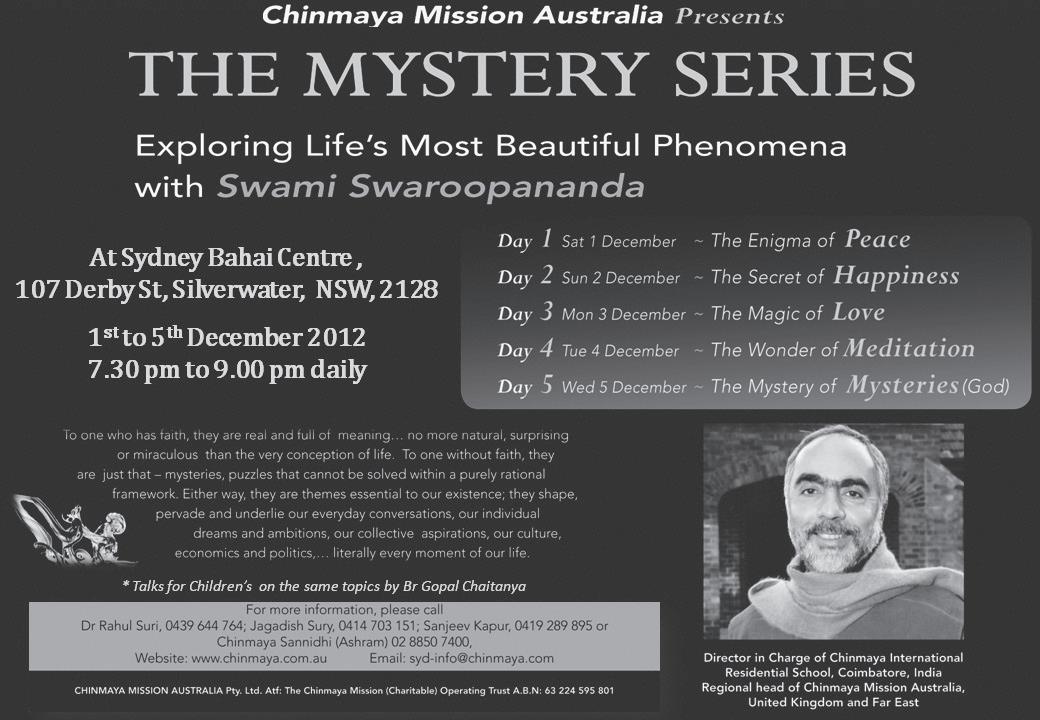




India is a country with many, many facets in which a single picture speaks in thousands of words. Enjoy these moments captured during the festival season as people celebrate their faith in a medley of colour, tradition and spirituality.



 Main Picture: Thousands of Hindu devotees hold earthen lamps as they participate in the Maha Aarti ritual on the eighth night of Navratri festival in Gandhinagar, Oct. 22. Photo: AP
Clockwise from bottom left: 1 Hindu devotees apply vermilion on each other in front of a large idol of Goddess Durga as they prepare to immerse it in the River Yamuna during Durga Puja festivities in New Delhi, Oct. 24.The festival commemorates the slaying of a demon king by the lion-riding, ten-armed goddess Durga, marking the triumph of good over evil.
Photo: AP
2 A student at Udaipur’s Guru Nanak Girls College performs the ritual garba dance of the Navratri season
3 An effigy of demon king Raavan burns to denote the end of all evil, at the end of the Navratri period.
4 A Muslim boy rests as elders offer prayers during Eid al-Adha in New Delhi, Oct. 27. Eid al-Adha is a religious festival celebrated by Muslims worldwide to commemorate the willingness of Prophet Ibrahim to sacrifice his son as an act of obedience to God.
Photo: AP
5 Ushaben Dave, 65, wears a framed costume decorated with dozens of oil lamps during celebrations for the Festival of Nine Nights, Navratri, in Ahmadabad, Oct. 21. Photo: AP
Main Picture: Thousands of Hindu devotees hold earthen lamps as they participate in the Maha Aarti ritual on the eighth night of Navratri festival in Gandhinagar, Oct. 22. Photo: AP
Clockwise from bottom left: 1 Hindu devotees apply vermilion on each other in front of a large idol of Goddess Durga as they prepare to immerse it in the River Yamuna during Durga Puja festivities in New Delhi, Oct. 24.The festival commemorates the slaying of a demon king by the lion-riding, ten-armed goddess Durga, marking the triumph of good over evil.
Photo: AP
2 A student at Udaipur’s Guru Nanak Girls College performs the ritual garba dance of the Navratri season
3 An effigy of demon king Raavan burns to denote the end of all evil, at the end of the Navratri period.
4 A Muslim boy rests as elders offer prayers during Eid al-Adha in New Delhi, Oct. 27. Eid al-Adha is a religious festival celebrated by Muslims worldwide to commemorate the willingness of Prophet Ibrahim to sacrifice his son as an act of obedience to God.
Photo: AP
5 Ushaben Dave, 65, wears a framed costume decorated with dozens of oil lamps during celebrations for the Festival of Nine Nights, Navratri, in Ahmadabad, Oct. 21. Photo: AP


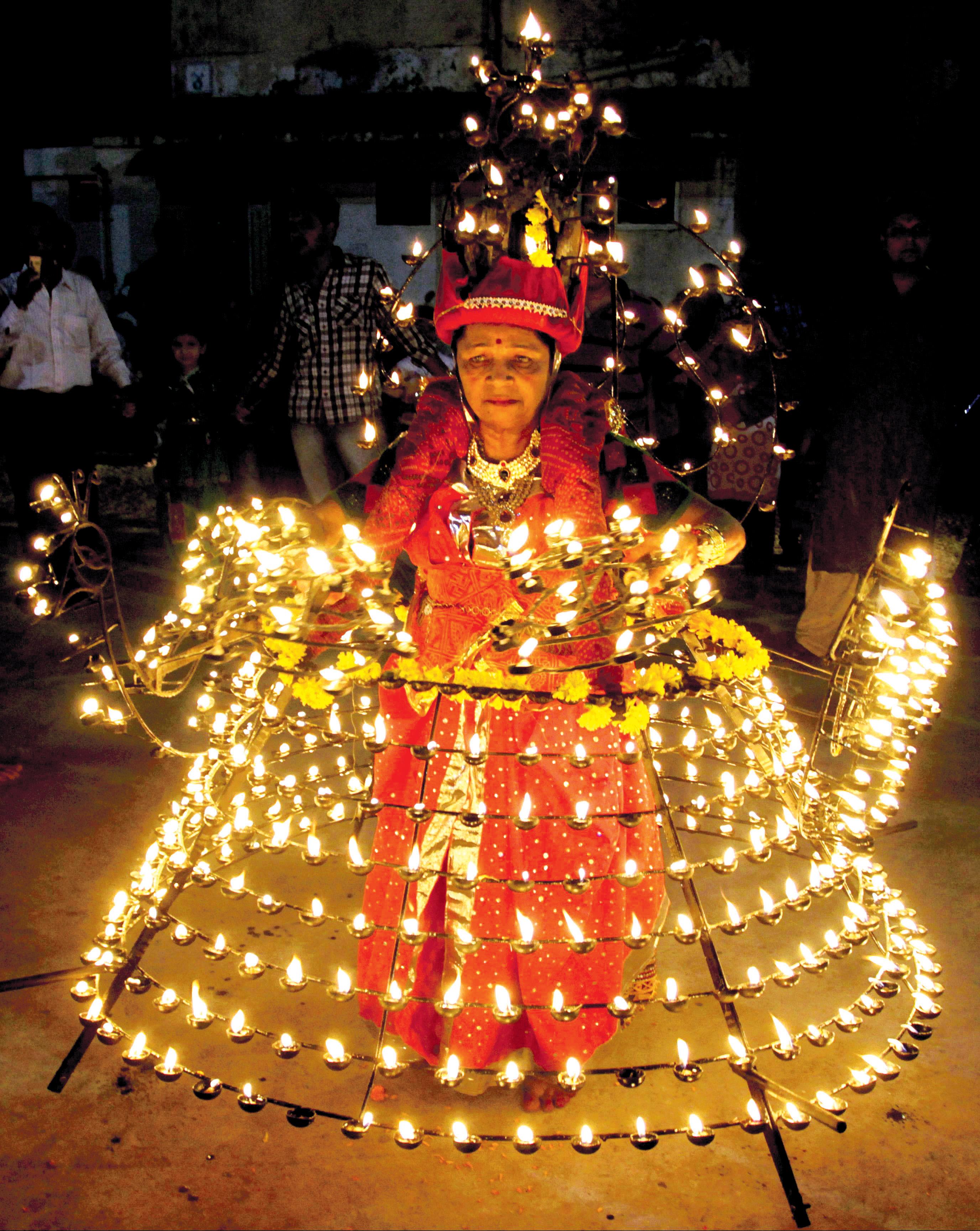


Speaking on the occasion of his book release on September 9 at the Australia India Institute (AII), University of Melbourne, former diplomat and peace keeper, current Member of Parliament and author Shashi Tharoor clarified the use of the term ‘Pax Indica’. By that he did not imply Indian world domination or an empire like Pax Romana, but a ‘peace system’ of cooperative relationships in which India would play an important role in developing a contemporary set of rules that will help ‘promote and maintain a period of cooperative co-existence’. He cited the example of the world wide web - a world in which countries are connected to each other, and through which they will pursue their interests in a cooperative way. Until recently, India was a ‘rule-taker’; today however, India contributes more to rule making, and will be a key rule maker in the 21st century.
India already represents and exemplifies it: it is, on the one hand, a member of the Non Aligned Movement; a member of the community of democracies which includes Imperial powers against which it had fought; it is at the same time a member of G77 (group of developing countries) as well as G20 (a consort of the biggest economies of the world); a part of SAARC, a member of RIC; BRICS – representing South-South cooperation. Tharoor believes that India is a lynchpin of this diverse international cooperative endeavour. This is what he celebrates and promotes in Pax Indica
In order to play a greater role in the world, India needs a robust foreign policy, which in turn requires more foreign services officials. He examines the role of the Ministry of External Affairs (MEA), Parliament and public opinion on the shaping of policy, and outlines his new grand strategy for the nation, arguing that India must move beyond non-alignment to multi-alignment.
The MEA is grossly unequipped for this role – being under-staffed and under-resourced. India, with a population of over 1.2 billion
Parag Khanna rightly pointed out that India has neither the capability nor the ‘strategic appetite’ yet, to be a world or even a regional power
has around 900 foreign services officials across the world -the same size as Singapore and New Zealand. That is less than Brazil‘s which has over 1200 career diplomats; and China’s, which has around 4200 foreign service officials, and the US 42,000. There is an urgent need to expand India’s foreign service, argued Tharoor.
Tharoor believes that India’s external orientation has been downplayed, largely because of the belief that foreign policy has little impact on rural voters in India – who may constitute the bulk of most MPs’ constituencies.
Tharoor opines this is a misconception: foreign policy affects everyone in a globalised world. Economic liberalisation has made India a more globalised country than ever before; much of her growth has come about as a result of her international connectedness. The younger generation in India is growing up working with foreigners, travelling abroad on work or holiday, and such like. The purpose of India’s
foreign policy must be to promote and facilitate the domestic transformation of India.
There are individual chapters in Tharoor’s book on Pakistan, China, US, South Asia; one on India’s ‘soft power’; a chapter on the domestic underpinnings of Indian Foreign Policy, especially on the MEA. Tharoor also evoked the concept of ‘Soft Power’ (first coined and elaborated by the Political Scientist Joseph Nye) during his book launch– that is, a country’s ability to influence its region or the world – not through military power, but through ideas, culture, institutions, and a web of cooperative endeavours. He believes India has considerable ‘soft power’ that it can rely on and invoke, which is a source of strength.
Tharoor’s talk on the occasion of his book launch was impressive, persuasive and engaging. The book too is a serious attempt to articulate a vision for India in the near future: God knows there are too few thinking politicians in India
Shashi Tharoor
Economic liberalisation has made India a more globalised country than ever before; much of her growth has come about as a result of her international connectedness
today. Some of the chapters are fairly in-depth and address some really serious issues that need to be confronted. This book must be read by anyone interested in India’s foreign policy. However, it is this reviewer’s opinion that those reading Tharoor must also make it a point to also go though Ramachandra Guha’s “Ten Reasons why India will not – and must not – become a superpower”, if only to get a sense of perspective. Far too many books have come out in the last 10 years harping on the rise of China and India, that the Indian middle classes have come to believe that their country is an ‘Emergent power’, a ‘Rising superpower’, a ‘Reluctant superpower’ and other epithets, and it is there for the asking.
Parag Khanna rightly pointed out that India has neither the capability nor the ‘strategic
appetite’ yet, to be a world or even a regional power. When travelling in India, one often wonders whether the Indian upper middle class which flits from mall to air-conditioned offices to gated communities – is aware of the stark inequalities, the appallingly inadequate infrastructure and power shortages – when it stakes such a claim for India. At any rate, why can’t they – and Tharoor – wish for an India that is different: one that is more ethical, concerned about the welfare of the less fortunate, more interested in ideas and ready to lead by example? That would indeed be showing real leadership – and doing justice to our long and hoary past.
Shashi Tharoor’s Pax Indica: India and the World of the 21st Century is published by Penguin.


Move over fine writing, thrillers are spurring creativity among new Indian authors. Critics say thrillers with Indian twists are fetching mega bucks in the booming mass fiction
The trend is primarily western, prompted by the glut in imported thrillers by the mega retail chains to keep the market alive in the face of the downturn.
Thrillers set in an Indian milieu are long overdue, says writer Anita


“Perhaps, why they haven’t taken off is because thrillers demand a great deal of research and precision. Information gathering is not easy in our country. Also, as Indian literature in English is still shaping itself into a canon of writing, most writers are perhaps unwilling to be branded by the tar brush of commercial writing,” says Nair, who switched from poetry and literary writing to plotting a thriller this year.
Nair’s thriller, Cut Like a Wound (Harper Collins-India) published in September, is modelled on the classic Euro-American style with private investigator Borei Gowda stumbling across the murder of a male prostitute at Shivaji Nagar in the heart of Bangalore. Gowda is beyond his prime and battles his mid-life blues with an extramarital affair.
The trail leads Gowda to a psychopath, a serial killer....
The book occurred to Nair during an e-book tour in Rome in 2010. “In fact, it is only when I started work on my novel that friends began recommending writers I ought to read - Ian Rankin, Michael Robotham, Mark Billingham and Daniel Pennac. However, inspector Gowda has little to do with the noir heroes of western literature,” Nair says.
Entrepreneur-turned thriller writer Aroon Raman projects a fantastic hypothesis in his book, The Shadow Throne. A shadowy group - a collection of individuals from Indian intelligence and security agencies - plans an audacious nuclear strike by smuggling a Pakistani ballistic missile into Afghanistan and firing it into India from the Durand Line, the Af-Pak frontier, in the hope of igniting a sub-continental Armageddon. Just two men and a woman - an Indian journalist, a police officer and a college lecturer - stand between them. Do
they succeed?
Raman, who has been inspired by pioneers of the genre like Sir Arthur Conan Doyle, says it was his intent to place The Shadow Throne (Pan Macmillan) “against the backdrop that mirrors the current underlying reality - especially as it applies to India’s political predicament and its impact on our geopolitical security - and the uncertainties in Pakistan”.


Known for its impressive lineup of foreign titles in the thriller category, Pan Macmillan says the “Indian mass market is ready for thrillers created indigenously”. This month, it added Madhumita Bhattacharya’s The Masala Murder to its fledgling coffer of homegrown mystery stories.
The Masala Murder, a serial thriller, is about a woman private eye, who manages a private investigation agency - a la Alexander McCall Smith’s The Ladies Detective Agency Series. Written in first person, the writer, a detective-turned-food-critic and baker, returns to snooping by default when she is entangled in the murder of a gourmet importer.

In a recent interview, Bhattacharya said to get a first novel published in a challenging environment, she needed to write “something that fits into a genre of some sort - that a publisher could see it working


commercially”.
“The one closest to my heart is mystery... It works for me,” Bhattacharya notes.
First-time crime thriller writer and filmmaker Piyush Jha believes that “it takes an extraordinary mind to write a thriller”. Jha, who published his first crime thriller, Mumbaistan (Rupa & Co) - an anthology of three novellas about the underbelly of Mumbai - says “thriller as a genre is yet to show its mettle in India unlike in the west where writers of crime thrillers come with a lot of background”.

“All those who write thrillers in the west have a lot of background, depth and a lot of life. In India, one has to explore the surroundings to come up with credible stories,” says Jha.
The list of writers is growing with early trend-setters like Mukul Deva and Ashwin Sanghi making way for new names like Juggi Bhasin, Abhisar Sharma, Shantanu Dhar, Hemant Kumar, Abhay Narayan Sapru, Saad Shafqat and several more. A thriller has to factor in the reality around us.
“A thriller, I discovered, is a reality check every writer has to undergo to know how grounded we are in the world we inhabit,” Nair said.

And India sure is weaving its fair share of mysteries in its crowded cities and dark alleys.
Madhusree Chatterjee
Thrillers haven’t taken off (in India so far) because they demand a great deal of research and precision. Information gathering is not easy in our country. Also, as Indian literature in English is still shaping itself into a canon of writing, most writers are perhaps unwilling to be branded by the tar brush of commercial writing
 By Noel G De SoUZA
By Noel G De SoUZA

When public decisions are made often under great pressure from one or more interested parties, the outcome may not be favourable for all the affected parties. Some may be favoured by the decision, whilst others could be adversely affected.
A very good example is the lowering of the interest rate by 0.25% to 3.25% on October 2 by the Reserve Bank of Australia (RBA). This reduction was not expected by either economists or currency traders. There had been much pressure on the RBA to stimulate the economy by the real estate sector, in particular. The housing sector wanted an even greater cut, but the RBA had several other important considerations to take into account.

The move undoubtedly favoured home buyers because an average home loan mortgage of $300,000, if reduced by 0.25%, would save around $50 a month. But at the other end of the economic spectrum, pensioners and others who depend on their savings can expect banks to simultaneously reduce rates on term deposits. This means that pensioners are going to earn less, and this in turn puts pressure on the government to increase part pensions to retirees.
High interest rates have kept the Australian dollar high and this has adversely affected Australia’s manufacturing industries which cannot compete with cheaper imported products. Even Australia’s agricultural sector, once its economic backbone, has become, as a result, uncompetitive in the world market. The reduction in interest rates led to an immediate fall of 0.7cents against the US dollar, which is possibly a desirable outcome to the RBA.
Following the nowunravelling new Global Financial Crisis (GFC) in European economies, the price of coal and iron ore has fallen. This has resulted in mineral assets being sold in Australia at reduced prices. The buyers who want to grab such bargains come mainly from Asia, principally from China and India.
Mineral concessions can make the owners megarich, often resulting in litigation. The granting of mineral concessions in Australia can depend very much on decisions in the hands of the state governments, state mining ministers and at times, with the federal government.

The situation is similar in India where there are currently on-going battles regarding the grants of mining leases. Governments on both sides of the political fence have been made to answer questions regarding the granting or cancelling of mineral concessions.
A good example is the mineral-rich small state of Goa. There were so many issues involved that a royal commission, led by Justice Shah, was instituted to probe into the matter. There were allegations of improperly granted concessions, of illegal mining in places where there were no concessions at all, and finally of royalties not being paid. Not paying government tax dues meant the people of the state are being denied revenue.


To add to the above illegalities, there were questions of environmental spoilage, damage to agriculture, dust pollution and traffic congestion, and of dangerously driven ore carrying trucks.
The Supreme Court, in October 2012, suddenly clamped down on this sorry state of affairs by banning all mining in Goa. This abrupt event has had varying reactions from different groups in the state, depending on their interest in the mining sector. The miners themselves have reacted with disbelief as they had counted on the State Government to save them.
There were allegations of improperly granted concessions, of illegal mining in places where there were no concessions at all, and finally of royalties not being paid.
Besides the miners themselves, the affected people include mining contractors, truck owners and barge operators who employ thousands of people. Barge owners alone are said to employ 6000 people. All these groups create indirect employment for a great number of people.
There was recently astounding news for residents in Western Sydney: the highway to Parramatta is proposed to be dug up and replaced by an eight-lane motorway, using a new technique of “cut-and-cover” which would entail ripping up parts of the existing road and building a new road underneath.
Coal is a prized asset as coal-fired electricity plants are the norm in India and China, despite the growth of alternative energy sources. Coal generates half of Asia’s energy needs. Besides, high quality coal is used to produce steel. These mining deals total a sizeable $47 billion which prevents the Australian dollar from declining too rapidly.
One can imagine the panic of residents and businesses along the proposed route as it could take years to build.
The cost of this amazing proposal is an astronomical $10-15billion! For a figure this high, there are certainly going to be tolls, possibly to attract private entrepreneurs so as to make the venture a private-public partnership.
No matter what the solution may be to a problem, there will always be some winners and losers
casual?
Is it just the clothes or a state of mind that define your attitude to the world?
By AMIT DUTTAfew days ago, my wife and I were invited to casually dine at a friend’s place.
“Come over,” she said. “Nothing too formal, we will just have a lazy Saturday night.”
On the dot, defying the IST, we arrived at her place with a nice bottle of red in hand. Her husband opened the door, welcoming us.
“We didn’t want to make it too formal, so we invited no one else,” he said, making sure we knew there was no one else for company.

has become so relaxed that casual at the workplace to many, means what you would wear around the house on a Sunday morning. In the last 16 years of working in big corporations and small businesses, I’ve seen my co-workers dressed in torn trackies and socks, singlets with an open view of cleavage and stomach, to the extent of intimate garments and athletic wear suitable for a gym. While at some places the trend has been corrected, at others, the risk to rectify it has been too great in the name of political correctness.
I strongly believe that what you wear reflects your state of mind.
As we entered the living area, there sat his wife in lazy, crumpled pyjamas, plastic slippers, and a singlet. “Just wanted to make it a casual evening,” she said, justifying her appearance. Looking at her I certainly did feel overdressed in my jeans and t-shirt. The evening went well. Takeaway, a few drinks and the local gossip. Casual, it was. In fact, it dropped to the nadir of casualness.
Sitting there started an interesting thought process in my mind. Have we become too casual, and when is casualness too casual? And has this casualness crept into all spheres of our lives? Casual food, friendship, sex, affair, drink, smoke and the list goes on… Have we taken the very word ‘casually’ too seriously?
I am by no means a connoisseur of fashion and dressing up. But I do strongly believe that what you wear reflects your state of mind in general. A pair of jeans may scream casualness, pyjamas and singlets don’t.
•
•
*
As the workplace is a major part of our life today, our attitude there flows freely to our weekend life too. The ‘casual’ attitude is no different from the ‘use and throw’ attitude we have developed. When it’s cheaper to replace, why bother repairing or fixing. Electronics, computers, lawn mowers or relationships, the mindset is, it’s easy to get a new one, why fix the old one. Casualness driven to the extent today screams, I don’t give a damn in any sphere of my life. And walking down the street, it shows.
Don’t get me wrong. I am, by all means, for making our lives easy and relaxed. In fact after wearing suits for 16 years of my corporate life, I am thoroughly enjoying the jeans and polo t-shirt I now wear to work. The issue is more than clothesdeep. Clothing is the only visible sign of our attitude. It is what has contributed to our thoughts and the way we want to get away without making any effort in our daily lives.
Casualness driven to the extent today screams, I don’t give a damn in any sphere of my life
It’s that old “Chalta hai” attitude all over again: ‘anything goes!’ There is no difference in the two. They both say loud and clear to the world that we just can’t be bothered, and it infuses in us the very same feeling.


In the last few years, there has been a concerted effort to make the workplace casual. Hence the emergence of workplaces like Google or some leading IT companies. Taking a cue from them we have ‘casual Fridays’ at many workplaces. However, it seems in the present day, our culture
The whole purpose of casualness is open communications and an unconstrained outlook. And that is only possible when we know where to draw a line. When we can make an honest distinction between what we wear and how we think, and not let either one of them overpower the other.
 By MAHeSH RADHAKRISHNAN
By MAHeSH RADHAKRISHNAN
This year, we were not able to make it back to Sydney to spend Navarātri with my parents. But the festival, as always, is a good opportunity to reflect on the concept of Shakti or the Goddess that is manifest as nature, the flow of energy in the cosmos, and womanhood.
The philosophical elements of Shakti are relevant and transcend the confines of religion and doctrine, so I invite readerswhatever your faiths and gender - to journey with me on this reflection on a Hindu tradition.
Navarātri, the nine nights of the Goddess, celebrates the various aspects of Shakti, including the forms of Lakshmi - abundance; Durga - destruction (which always entails regeneration), and Saraswati - creativity and knowledge. The idea is that these concepts of flowing abundance, flowing destruction, and flowing creativity are female forms of divinity. Through worship we express our gratitude to them, and recognise that their embodiment on earth is in womanhood.
While some Hindus may wax lyrical about the place of women in philosophy and ancient practice, current conservative Hinduism still largely maintains women to have secondary status. I cannot say how long it has been this way, but the fact that continuing practices such as the dowry system, restrictions placed on widows and menstrual ‘impurity’ are entrenched (not to mention the more extreme institution of
be an issue grounded in secular life - and I think this is largely a good thing - there are some contributions to be made by the Hindu philosophical tradition and the way people approach it. The abstraction of energy, nature, (positive) destruction, abundance, creativity and knowledge as forms of feminine divinity is one useful aspect.
However, these spiritual ideals can conflict when we come to certain rituals, for example, rituals where women pray for the long lives of their husbands (one of these is called kāradaya nōmbu). It is reprehensible that the onus is on women to pray for the long lives of their husbands. One solution is to abandon such prayers. The other approach is to adapt the tradition as an opportunity for both partners to pray for one another’s long life. We are constantly adapting our traditions to contemporary life and this should not just be limited to practicalities (such as shorter ceremonies due to
B OOKK eeper
Experienced accounts clerk / bookkeeper required to work in friendly office for a concrete contracting company.
Experience with MYOB is essential. Duties include accounts payable, receivables, various project reports and payroll. Must have attention to detail and motivated.
Chipping Norton. Joe 0414 282 066
time constraints or the use of lamps instead of fire), but social progress.
Subramanya Bharati, the great Tamil poet and Indian freedom fighter kept alive the connection between devotion and gender justice through his devotion to the Goddess in Kāli and Shakti, as well as his dedication to the emancipation of women through access to education and social participation beyond the traditional role of motherhood.

In his poem and song Om Shakti Om, which I learnt from my first singing guru Lakshmi Raman, he sings the praise of the Goddess as manifest in all forms of divinity - both male and female. The final verse praises Lakshmi described as ‘Thirumahal’, or ‘the auspicious one’. The Tamil word ‘mahal’ means ‘daughter’. While I have not delved into the origins of the name ‘Thirumahal’ for Lakshmi, there are certainly strong connotations of womanhood. In
Bharati’s verse, he suggests that “by meditating on Thirumahal, we will have abundance and our inner light will take flight”. An added layer of interpretation is that by meditating on the auspiciousness of womanhood (and not just dominant ideas of what an ideal woman should be) we make our lives worthwhile.
The spiritual dimensions of Navarātri carry with them a beautiful message. And while many of us may absorb ourselves in the colour of traditional practices such as garba, temple festivities and golu, it’s worth seeing how the philosophy of revering womanhood and femininity can be applied in everyday social life. And though the division of male and female is based on biological reality, there is diversity in the ways that they manifest in people, another layer in the quest for gender justice between and beyond the genders.
life.
Ladies required to work in warehouse sorting Second Hand Clothing for Export Company. Full training provided.
Must provide Tax File Number. Casual - Award Wage Monday – Friday 8.30am – 4.00pm
ONLY hard working and reliable people to apply in person Mon - Fri between 9.30am - 3.00pm
Southern Globe Pty Ltd 3 Tait Street Smithfield
while many of us may absorb ourselves in the colour of traditional practices such as garba, temple festivities and golu, it’s worth seeing how the philosophy of revering womanhood and femininity can be applied in everyday social



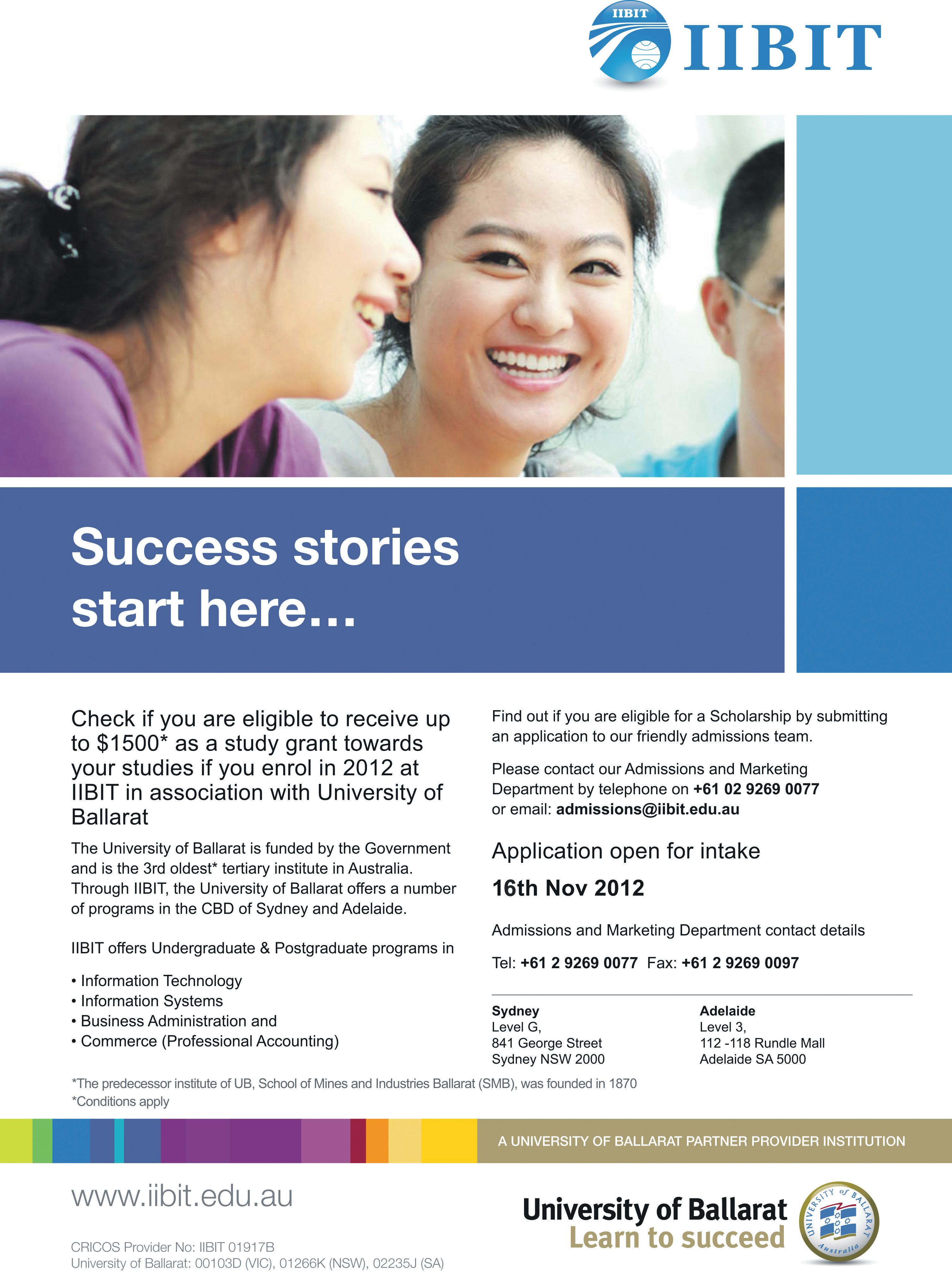

So it’s that time of the year again when we ask the eternal question: can 1.2 billion people be trusted with lots of explosives?
I love Diwali, not just for the festivities and tradition, but for what it represents. Which other nation would have so much gunpowder detonated in the space of a week, and still be intact at the end of it? Moreover, which functioning nation would actually allow its citizens access to so much low-grade explosive material?


An American ambassador to India, John Kenneth Galbraith, famously once described India as a ‘functioning anarchy’, and if you strip the word ‘anarchy’ of its stigmatic connotations, then that’s probably about right. Large swathes of the country operate with little or no interference from the central government, and often those areas aren’t tribal backwaters. Many Indian citizens appear to do whatever they want – from reversing up motorways to take a missed exit to ignoring whatever law exists to maximize monetary profit; from taking justice into their own hands to the aforementioned annual party of fireworks. In some respects, it could be said that Indians are the freest people in the world.
But how free is free? Freedom from restrictive laws is just one face of a multi-sided issue.

Aamir Khan’s issues-based show Satyamev Jayate interviewed a number of people who don’t have the freedom to access basic rights, nor the freedom to fight for them. Caste informally restricts millions from accessing dignified employment, gender roles informally deny both women and men from the freedom of choosing their lifestyle, and a lack of civic works combined with disability restrict many from accessing government services such as clinics (which sometimes feature steps at their entries). Economic freedom is often a less obvious, although no less malignant shortcoming of the weak Indian state. As Manmohan Singh, Mamata Banerjee and sundry go to war over the impact of Foreign Direct Investment (FDI) in retail, everyone seems
to be missing the point. The Left worry that FDI will do small business out of employment, while the Right say that the street vendors are doing better than ever, despite the reforms of the 1990s. Regardless of who is correct regarding FDI, have either side done much to lift the poor out of poverty? Has West Bengal’s socialism turned Banerjee’s home state into a bastion of equality? And has the past 20 years of liberal economics in Delhi helped get beggars off street corners nationwide?
The contrast is particularly glaring in the big cities, particularly in the north. The recently opened, state-of-theart Yamuna Expressway from Greater Noida to Agra passes countless impoverished villages.

The road is largely empty, thanks to the up to $10 price tag at the tollbooths. Nevertheless, the road is being touted as an example for other motorway projects to follow: Delhi to Lucknow, Ahmedabad to Vadodara, Chennai to Bengaluru. But who is benefiting from all of this? While driving along the Yamuna Expressway, I felt childlike in my freedom – speeding along, elevated above the surrounding plains, sights like the Buddh International Formula One circuit passing me by. And then I noticed the road was lined by barbed wire fences. Apart from the obvious comment to be made about safety (can you imagine the consequences of crashing into a barbed wire fence?), who was the barbed wire was intended for, I wondered. Is it there to keep out roaming cows, nilgais and other animals? Or is it to discourage local villagers from trying to cross the road? Either way, the symbolism is clear – on one side of the fence is the flawless new tarmac, hosting those who can afford her tolls, the ‘civilised’.
On the other side stands the wild, animals and people who live near them, who can’t afford the expressway tolls, much less a car to drive. The ‘uncivilised’ are literally as well as metaphorically held back by three seemingly endless lengths of barbed wire; the scene was something akin to that of a prison. Meanwhile, earlier this year, the Asian Development Bank reported that India’s middle class could equal the current national population of 1.2 billion by 2032. The question is, what will the overall population be by 2032, and in what condition will they be living?
Delhi’s clean, clear streets

The Asian Development Bank reported that India’s middle class could equal the current national population of 1.2 billion by 2032
Diwali in some ways is a leveller, a chance for those less fortunate to at least try to celebrate. Young street children stand mesmerised by fireworks, older children join in, and their parents watch as they smile and laugh. Others are in a more giving mood, and charities register a bump in donations during each November. Of course, this is no solution, but at least they can forget for a while the freedom that they live without. For a short time, India’s anarchic freedom extends to just a few more of the population. I wish you all a very blessed and free Diwali, Eid, Navratri, Guru Nanak Jayanti or whatever else you may be celebrating this month.
Which other nation would have so much gunpowder detonated in the space of a week, and still be intact at the end of it?


examinations and tests can be stressful for students and also for their families. At this time of the year, most students are exposed to the need by schools and teachers to measure, test and assess through the use of exams. Examinations can be a source of stress but there are some fairly basic strategies that students can apply to manage and do their best.

Students will normally be given plenty of notice for forthcoming exams. This means that they will know in advance what exams will be on what day, how much time there is between exams and the order or sequence of the exams.
Many students find it very useful to have a visual depiction of the examination period with the exams clearly highlighted through the use of colour or a symbol. A chart or calendar can be a very useful external visual aid to assist in helping students to get a sense of the placement and sequence of exams. It also allows for judicious planning around revision.
If exams are paced with a couple of days between them, it is common for students to leave the study for the exam to the period just before it. However, this may not be the wisest strategy. If students have a couple of weeks prior to their first exam, it is important for them to plan to isolate which subjects they would like to, or need to, spend the most time on. In this way plenty of time can be devoted to those concepts, issues and ideas of a course that may be most difficult and which can affect a student’s perception of their ability to understand the subject.
The detail of each course matters. It is common for students to ask teachers, “Is this in the exam?” If the answer is “No” then students tend to ignore that aspect of a course. It is important for students to remember that learning matters, and that detail matters too. Whilst they may not wish to emphasise aspects of the

course that are not the subject of examination, a student may find it helpful to be aware of the content as it may be foundational to other aspects of the course.
When planning a program of study it is important for students to list all the topics that may be covered and also the relevant chapters of any texts that cover the subject matter. In this way, the list can guide the preparation and all of the detail that needs to be covered can be accounted for. Students need to remember that detail is the basis for writing excellent responses and also for distinguishing their answers from the cohort.
How a student learns is central to how they will study. Parents need to be very careful and aware in this regard. What a parent did as a child might not be what their own child needs to do. It is common for students to prefer any of these study strategies:
* Writing the detail of the course out by hand
* Using colour in summaries so that particular concepts are colour-coded
* Using visual symbols to assist in memorising
* Creating palm cards and summary notes, some of which are hung on walls
* Talking out loud and repeating content so that it has an aural component
* Working in a space where they have control over what is where
Recently a young man said to me that he preferred to work in the library rather than at home, as his parents’ expectations though well-meaning, were a barrier to his studying. In the library he felt that he could really focus and not need to manage his parents as well. Students need to know that they are supported in their endeavours, rather than judged.
Study requires discipline and it can be tiring. However, students need to be able to allocate time to study prior to allocating time for friends and other activities. They need to know that the rewards come after the rigour. Rigour may mean following a timetable that allocates time during school, at lunchtime for example. It may also take the form of time out
from Facebook, YouTube, Twitter and the like, maybe ensuring that all music is off.
Students will value the reward of a break from study when they feel like they have been productive in their efforts and when they have exercised their minds and their thinking.
There is an important place for repetition in study, particularly for exams. Repetition anchors information in long-term thinking such that it can be readily recalled when required. Many students will claim that repetition is ‘boring’, and in this regard it must be seen as a discipline. Repetition can be viewed as necessary for familiarity with content and also as the basis for higher order thinking that comes with application of ideas and content to solving problems. Cramming and more cramming is often frowned upon, but is the reality of exam preparation. Thus whilst not an ideal measure, shortterm cramming may feature in the preparation. It is however, not a wise long-term strategy.
Doing past problems and practice problems is an excellent way for students to familiarise themselves with how to apply what they know.
Many students will feel very affirmed with doing practice papers, especially if there are model answers provided. Indeed really well written resources can help students to teach themselves and can build self-confidence as students realise they know more than they thought they did.
A further aspect to answering
practice problems is that students will notice that themes emerge.
Particular concepts tend to be asked more often and the breadth of a concept can become clear as various aspects of it may be tested. In the case of particular subjects such as mathematics, practice can help a student learn how best to approach particular types of problems.
Practice papers will help students to understand how to analyse different types of questions so that they can see what is important in a problem. In this way they will not be distracted by things that may not be important. Similarly, practice helps students with issues of ‘identity’. That is, quickly identifying what is required of them and thus honing in on the relevant method and level of detail to apply.
Whilst all exams are timed, the first thing a student needs to do is become familiar with all of the content and concepts which will be the subject of the test. The second thing is to practice past questions without timing in order to learn the format and approach to problem solving. The third step is to work on speed. Thus, speed training is the last of the tasks and should not be done from the outset. Rather, speed will actually automatically arise as a student’s confidence increases and can be worked on as a particular skill as a final strategy once mastery of the subject has been achieved.
Sometimes students are confronted with a particularly difficult question during an exam.
What a parent did as a child might not be what their own child needs to do
Practice papers will help students to understand how to analyse different types of questions so that they can see what is important in a problem
At this point they may freeze or even panic.
It is crucial for students to know that if they have prepared really well, they can take a degree of confidence into the exam room. If they are confronted with a tough question the first thing they need to tell themselves is, “The playing field is level. I have studied well and know my work. If I find this question tough, so will everybody else. I can therefore give it my best attempt and that should stand me in good stead.”
In summary, examinations can be daunting and stressful, but with great planning and some discipline the lesson of exams will become a life lesson. Preparation matters, and doing your best will be rewarded.





Airfreight: Flash Freight offers our clients a full range of air-freight services. Import and export services.
Seafreight: Through our extensive network of overseas agents, Flash Freight is able to offer their clients a full range of sea freight services.
• Full import and export services

• FCL 20FT & 40FT
• LCL cargo
• Breakbulk
Customs Clearance: All importers need fast and precise clearance of their goods through australian customs and australian quarantine prior to goods arriving into australia Our services include :
• Sea, Air, Parcels Post
• Customs entries
• Tariff consultation
Transport:
Flash Freight has their own fleet that includes sideloaders & 40FT & 20FT trailers.

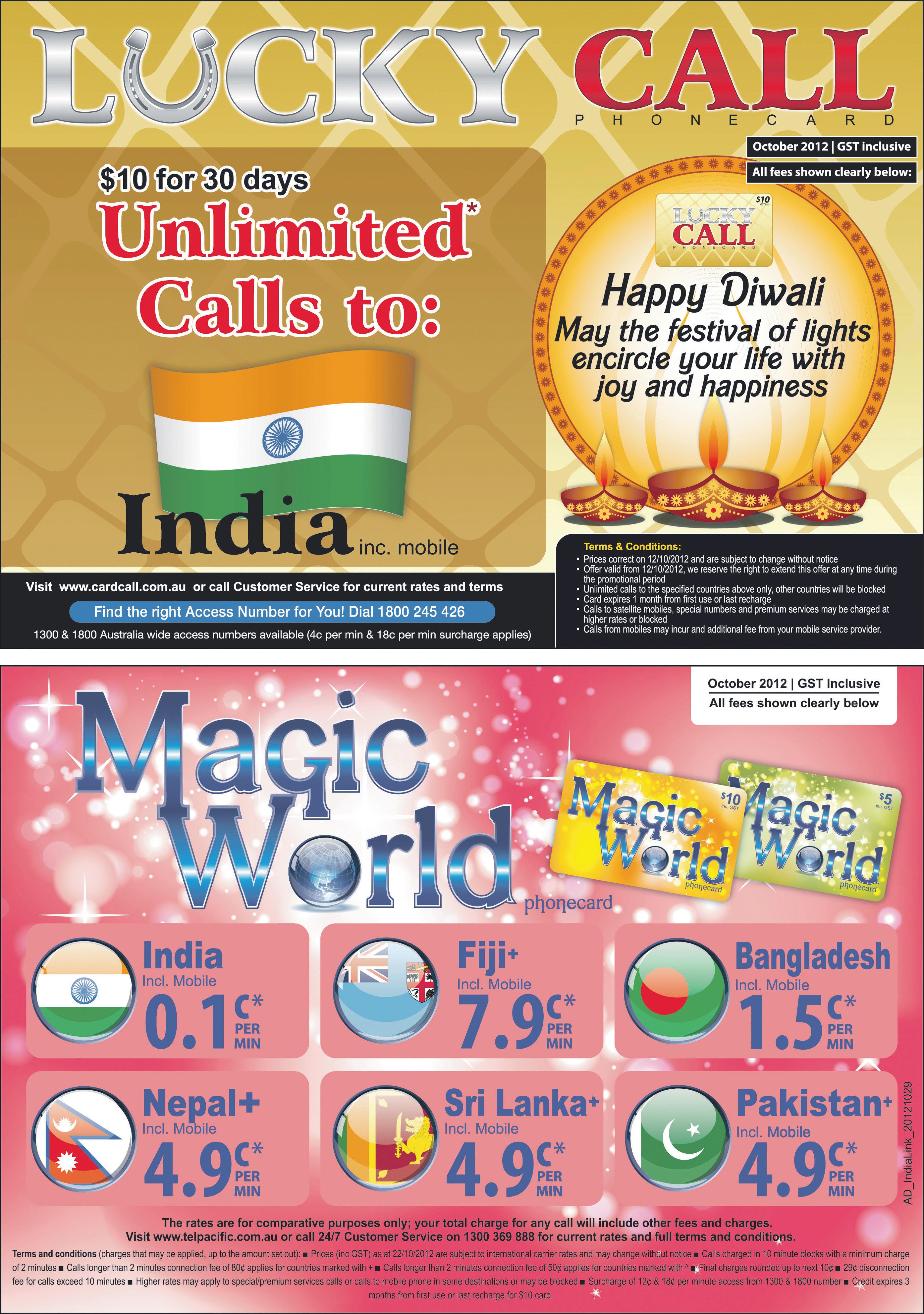

Who wants to think about a healthy shopping cart in the festival season with all that delicious traditional food around? This is the time to party and enjoy. But in fact, this is the right time to start worrying about your health and waistline after the festival season. And since we tend to eat high calorie foods a lot more than our regular routine, especially at parties, get-togethers and festivals, it is very important to have healthier options available at home. So what we add to our shopping cart is very, very important.
Is our trolley full of veggies and fruit, or does it contain loads of fizzy drinks, frozen snacks and chips? Often we are fascinated by attractive food packaging and misleading claims, which are mostly marketing hype. Even if we sometimes want to shop healthy, the time it takes to read food labels, as well as claims on various products which may or may not be true confuse us so much that we end up buying our regular stuff. There is an ever increasing range of food products available, making shopping all the more confusing especially if you have to juggle around 2-3 kids on the trolley and their unlimited demands.
Discounts, specials and costs, all affect our grocery shopping but if we can include some of the following foods in our shopping cart, we can have healthy meals.
Dairy or milk products are very important sources of calcium and protein, and are a must on the shopping list. Opt for low fat varieties of milk and yoghurt to reduce calories and saturated fat. Cottage cheese, ricotta, or Philadelphia cheeses are better options than high fat cheese.
Philadelphia cheese is excellent as a spread for sandwiches, and paneer is an excellent source of protein and calcium, especially for vegetarians. Low fat yoghurts can be used a snack as well as with a meal, or can be made into a lassi and enjoyed as a drink, instead of soft drinks.
Even smoothies with low fat milk or even low fat ice cream
with lots of fruits blended into it can be an excellent snack, a substitute for high calorie drinks.
Breads and grains are the main sources of energy. But go in for wholegrain breads and cereals instead of white grains. You get more fibre and other micronutrients from wholegrains than from processed foods. Avoid buns and bagels with cheese and bacon toppings as these add unnecessary calories and fats.
These provide us with most of our vitamins, fibre and minerals. Fill your cart with a variety of fruits and veggies to get the beneficial nutrients from different fruits and veggies. Add green leafy vegetables such as spinach and mustard leaves for folate, iron, and potassium; tomatoes for lycopene; carrots and pumpkin for vitamin A; citrus fruits such as oranges and lemon for vitamin C; berries for antioxidants; and banana for potassium. Pick up carrots, celery, baby carrots for snacking and munching. Vegetables can be enjoyed as cooked veggies or in salads. Fruit is an excellent snack, and fruit an excellent entrée for parties. You can also add a few bags of frozen vegetables without sauce for times when you run out of fresh ones, so that you do not have an excuse not to eat veggies.
Meat and poultry are an important part of our diet, but these are also sources of saturated fat. Red meat is an excellent source of iron and protein, but it is very important to look for lean cuts of meat to reduce the intake of saturated fat. Chicken breast is the leanest part of the chicken and therefore an excellent choice. Try to add some fish in your menu as it is a good source of polyunsaturated or ‘good’ fat.
Oils and fats are an essential
part of our diet and must not be ignored, but should be consumed in moderation. Include monounsaturated fats or polyunsaturated fats rather than saturated fats such as butter, ghee, and cream. Monounsaturated fat is found in foods such as avocados, almonds, cashews, peanuts, and cooking oils
for herbs such as parsley, mint, oregano, rosemary and coriander, or lemon juice, balsamic vinegar and spices such as black pepper and cumin seeds to give that extra zing and flavour.
canola, soybean, olive, sesame and peanut oils. Polyunsaturated fat (omega-6) is found in foods such as fish, margarine, linseed, sunflower and safflower oil, pine nuts and Brazil nuts. Polyunsaturated fat (omega3s) is found in oily fish such as tuna, salmon, sardines and blue mackerel as well as walnuts and linseeds. Avocado can be added to sandwiches, or salads and nuts can be had as a healthy snack.
A healthy diet does not have be flavourless or bland. But instead of high fat salad dressings, opt
In a balanced diet, it is most important to include treat foods such as desserts - gulab jamuns and chocolate whichever you prefer, as long as we adhere to the portion sizes.
Always go shopping with a planned shopping list to avoid unnecessary purchases, and try not to visit the grocery shop every other day to prevent impulse purchasing through the temptation of attractive sales and discounts.

As the festive season gains momentum, the temptation to indulge in deliciously rich unhealthy food gets stronger
Often we are fascinated by attractive food packaging and misleading claims, which are mostly marketing hype Include monounsaturated fats or polyunsaturated fats rather than saturated fats such as butter, ghee, and cream.
handling and shipping grain in its hey-day.
By AVI CHANDIoKIhad lived in Adelaide for over two decades and had still not visited the Flinders Ranges. It was one of those sights that always gets overlooked and postponed simply because it is always there. But one sometimes needs an incentive to act, so when we unexpectedly received an invitation to visit Port Augusta at more or less the southern tip of the Flinders Ranges, we couldn’t say no. One crisply cool, sunny morning we began the 4-hour drive heading north from Adelaide, on our long-awaited visit to the Flinders Ranges. We had already decided on a few places and sights, but confined ourselves to the southern ranges. (Which meant more to see on future trips!)
The first stop we made a couple of hours into our drive was at a prettily-named town called Crystal Brook. The main street appeared very wide but for a central garden area adorned with trees, bushes and picnic tables. It looked inviting and a special bonus was the giant iguana perched high on a stand. You either love that sort of feature or hate it, but some sort of coloured and pretend flame spewing out of its mouth would have added further amusement to the attraction.
We drove through many little towns after lunch, at which time they appeared to be fairly quiet. Our next stop was at Port Germein which boasts a jetty 1.5kms long that seems to keep going forever out to the sea. A lighthouse and a pub by the jetty testify to a town which would have had a bit of bustle about it,
By now the ranges had been visible for a while as small hills in the distance. At this point we cut inland to take the route via Melrose and Wilmington, driving through a corner of the ranges.

The road entered and wound along a gorge, with craggy clifffaces and vegetation, and areas where rock falls had occurred. The road twisted and turned, making for an exhilarating drive.

All the while, slanting rays of the sun picked out a kaleidoscope of colour and sparkle on rock faces as they whizzed past.
Crossing the hill through the gorge led us to a gently undulating valley at a very slightly higher elevation where a couple of wineries flourish on the way to Melrose. This town sits at the foot of the Mt Remarkable hills and nestles in a wood and forest setting, adding to its charm. As we still had some way to go, we decided not to climb to the summit but carry on to our destination.
In the glow of the late afternoon winter light, the road started its descent in gentle sweeping hillside curves. The view opened out to magnificent occasional vistas of the plains and sea, then hills beyond the gulf.
In addition, the dense vegetation on either side made this an unexpectedly pleasurable part of our drive for the day.
I lay in bed that night feeling genuinely pleased that we had finally made it to the Flinders Ranges. We had seen the fabled red earth of the country’s interior. The day had not just been a drive from A to B, but we had actually enjoyed it and taken great pleasure from the events and sights on the way.

It was chilly as we set off to visit Quorn, heading in the direction of the hills just visible
in the distance. The drive was pleasant and soon we entered the Pichi Richi Pass that cuts across small hills. The road runs parallel to the tracks of the Pichi Richi Railway, a narrow gauge rail line that now operates during school holidays and on weekends. Quorn has wide streets, a few buildings that have seen better days and a general impression of needing more people to give it vibrancy. This impression is replicated in other towns as well.
The drive from Quorn to Hawker is across a scrubby landscape of small groundhugging bushes in a vast amphitheatre surrounded in the distance by low hills.
Early settlers came in groups of families and friends setting out in wagons and carts, some walking, others on horseback. They drove a few livestock behind them and carried bags of seed which they hoped to plant in the red earth and to reap the rewards of a rich and bountiful harvest.
These adventurers had a lot to look forward to and their spirit, tenacity and hard work gave steel to their hopes and dreams. Some aimed for the hills and beyond, others chose to stop sooner. They cleared sites, built homes and carried on with their customs and beliefs. But none of this was enough. The dry hinterland just beyond the ranges can spread its tentacles far and wide. Had these souls decided to ignore the advice of George Goyder who, as early as 1865, had warned of an imaginary line which delineates cropping land from that which is unsustainable? Many would have returned broken in spirit and weakened in body, waiting for the rain to fall and restore the poor, exhausted soil. They went in hope, only to have their dreams end in tears. Is this why this stretch is called Heartbreak Plain? A most apt name!
We stopped to look at the Kanyaka ruins - a testament to those shattered dreams. The wellordered settlement had everything - an overseer, stores, blacksmith, offices, a medical facility and living areas with welcoming wood fires that would have cloaked the residents in its warming light. Many such ruins dot the landscape.
An interesting site is the Yourambulla caves, which house Aboriginal rock paintings in typical black and red ochre colours. Three caves on a hilly outcrop are connected by a welltrodden path, close to the main highway. When visiting sites off the main road, the need for a 4WD vehicle becomes evident as apart from driving being easier, there are many places that cater to off-road thrill-seekers.
Castle Rock lookout is a small outcrop of rocks near Hawker, which itself is around 300m above sea level. The 360 degree panoramic view is stunning from the top of the lookout. The next trick is to actually get down without being blown off by gale force winds that lash at you. But a cup of hot chocolate and toasted sandwich in Hawker soon got the body back to normal again.

On the day that a drizzle fell from cloudy skies, we drove to Port Augusta to explore its environs. After the plains and hills of the ranges, any city would seem rather tame. As if there is not enough water around, we drive to look at a lake. It was raining and misty, the dirt track we are crawling along had puddles, but just round a bend we saw a group of wet, bedraggled emus facing us. We stopped and they stopped. They looked at our red car,
squinted at each other and came towards us, dripping water. Then slowly in a stately fashion, they veered off into the bushes, no doubt quite annoyed with us for blocking their path and spoiling their afternoon walk. It was time to leave the Flinders Ranges. If you visit them, you will probably see much more than us. But there is one thing I can promise – you will look with your eyes, but feel the shadowy dreams of
A lighthouse and a pub by the jetty testify to a town which would have had a bit of bustle about it, handling and shipping grain in its hey-day













It was a momentous day.
As I stood on the ship’s observation deck, travelling upstream on the Irrawaddy River from Yangon to Mandalay, watching life pass by and pagoda after pagoda come into view, one of the passengers onboard came rushing over to me. On his shortwave radio, we were able to hear the historic announcement by Aung San Suu Kyi, that she had dropped her opposition to travellers visiting Myanmar (Burma). For years I’d grappled with the moral dilemma faced by many travellers, of whether or not to go there.
It was after my arrival in Yangon, formerly known as Rangoon, that after a long day of exploring the sights on foot, I caught a taxi back to my hotel.
graduating, was fortunate to find work as a taxi driver. He said he lived in hope. The Burmese are perhaps the most reserved people I have ever encountered and while that conversation was brief, it was one of the few I had during my three week stay there.

Visiting Yangon is like stepping back in time, as the city offers a glimpse of what other great Asian cities were once like, with many historic buildings, albeit decrepit and crumbling, including splendid examples of British colonial commercial architecture along the waterfront, interspersed with pagodas, temples and Chinese shop houses that come into view.

I spent several days exploring Yangon and while I visited the main sights; pagodas including the Shwedagon Pagoda, Chinese and Indian temples, the treasures at the National Museum and Bogyoke Aung San market, my favourite experiences were with the local people I met. At the Feel Myanmar Food restaurant, staff

cuisine, more subtle than those found in neighbouring countries. The green beans infused with a crunchy peanut and chilli sauce was exceptional. The restaurant was noisy and packed. With street signage in Burmese and with maps deficient in detail, it required the utmost concentration to avoid getting lost. While attempting to find Ngahtagyi Pagoda, an elderly man motioned for me to follow him. And so I did, for perhaps a kilometre, climbing hundreds of steps along the way. When we arrived, he gestured for me to enter and as I turned to thank him, he was gone.
After collecting my beautifully stitched silk shirts from Globe Tailors, I joined Pandaw Cruises for a 14 night journey travelling upstream to Mandalay.

At 2170 kilometres long, the Irrawaddy is Myanmar’s longest river. Once referred to as the ‘Road to Mandalay’, it is still used as a commercial waterway. The Pandaw II
harks back to a bygone time, reminiscent of the original paddle steamers built by the Irrawaddy Flotilla Company established in 1865 by Scottish merchants that became the largest privately owned river fleet in the world, with 602 vessels by the 1930s. George Orwell, William Somerset Maugham and Rudyard Kipling all undertook journeys by paddle steamer in Burma. Tragically, all were destroyed during World War II.
At every village and riverside town there were ramshackle warehouses, rickety jetties, dirt roads and dwellings made of thatch and woven bamboo. Young children swam while their mothers washed clothing on stone slabs and men wearing the traditional Longyi, or sarong, fished from canoes or steadied wooden ploughs pulled by oxen.

We visited Twante village to observe the famed clay water pots being made by hand. At Prome, we viewed a 5th-8th century archaeological site of early Buddhist artefacts. We visited the forts of Minhla, and many spectacular pagodas, including Myat-thalon Pagoda, built with solid gold bricks. We explored the most renowned of the 3,000 pagodas and temples at
Heritage Listed Bagan, the capital city of Burma from 1044 until 1287, and the largest ancient Buddhist site in the world. In Mandalay, a dusty town so celebrated by Kipling and the last capital of the Burmese Kings, we visited pagodas, a beautiful teak carved monastery and Mandalay Palace.

A highlight was the wonderful sleepy river town of Salay, with a beautiful teak museum, monastery, pagodas and colonial architecture. It was here that an impromptu band began playing, using rudimentary instruments and an old gramophone connected to a car battery for amplification. A crowd soon formed and the music was mesmerising. I enjoyed visiting markets to engage with the local people and exchange the greeting of “Mingalabar” or hello. And as with any country, there are traditions that for the first time traveller there are new and fascinating. At markets, I would hear “Thanaka” a paste liberally applied to the faces of women, children, even men. Many market stalls sold bundles of cuttings or small logs of timber with a mild fragrance. I asked one of the stallholders, “Thanaka?” Laughter ensued and the young woman demonstrated how it is made. With a little water, a yellow paste is produced by grinding the timber cutting on a stone slab called a Kyauk Pyin and applied to cheeks to make decorative patterns. This prized beauty product comes from the forests and has been used for over 2000 years.

As this mysterious country opens up to tourism, visitors are in for a spectacular journey of discovery through its natural and man-made wonders
On my final evening, I visited the majestic Shwedagon Pagoda once more, a perfect way to conclude my journey to Myanmar. It was while listening to the gentle humming of mantras by young Buddhist monks that I realised that while the immense beauty of Myanmar is evident everywhere, it was only the young girl selling Thanaka who I ever saw laugh. I met people who were gentle and helpful, kind and with a generosity of spirit. But a country without hope is a country without joy and with that I felt a great sadness for its people. I hope that by travelling there, we will provide reassurance that Myanmar was never forgotten.
The Burmese are perhaps the most reserved people I have ever encountered and while that conversation was brief, it was one of the few I had during my three week stay there.
monks
Bagan


Collecting timber at Bagan Golden Temples

Irrawaddy River
Mandalay
Thanaka being sold at markets
We explored the most renowned of the 3,000 pagodas and temples at World Heritage Listed Bagan, the capital city of Burma from 1044 until 1287, and the largest ancient Buddhist site in the world.
Malaysia Airlines, Singapore Airlines, Air Asia and Thai Airways International fly to Myanmar. Independent travel can be difficult. Tours are now available or contact a specialist tour operator such as Active Travel (02) 9264 1231 email: robert@activetravel.com.au or within Myanmar U Aung Kyaw Lynn email: majesticmandalay@gmail.com www.majesticmandalay.com


Built in the 1920s, the historic Governor’s Residence emanates style in a tranquil tropical garden setting. www.orient-express.com The beautifully restored Strand Hotel built in 1901 has 32 suites. www.ghmhotels.com Among many guesthouses, the Classique Inn is run by two Burmese sisters. www.classique-inn.com
Since roads are severely potholed, the preferred way to travel is by boat. Pandaw Cruises www. pandaw.com and the Road to Mandalay and Orcaella www.orient-express.com offer cruises on the Chindwin and Irrawaddy Rivers.
INFORMATION
For information including visas www.mofa.gov.mm Take new US dollars that are widely accepted. Myanmar has no ATMs and few hotels accept credit cards.
Clockwise from top left: YoungSelection of life partners by sifting online marriage proposals from BharatMartimony.com is fast catching up with prospective NRI and PIO brides and grooms in Australia. The trend not only offers convenience but better and wider options for selection of partners too.
Only an online matrimony site like BharatMatrimony.com can give a wide choice, tailored to the singles specifications. Other than the registration charges, the matrimony site does not benefit from the alliances. So there is transparency.

BharatMatrimony.com pioneered the concept of online matchmaking way back in 1997. Since then the portal has carved a niche for itself in the matrimony space, thanks to a combination of innovative features and cuttingedge technical expertise.
From a small website run by one man, BharatMatrimony has grown into the largest and most successful matrimony service in the world making a positive lasting difference to the lives of millions in several countries.
The portal has brought together a record 2.5 million couples through its innovative products and pioneering services spanning online and retail centres.
Earlier in the year,
BharatMatrimony launched a firstof-its-kind matrimonial search tool for today’s generation called SoulMate Search. This innovation in online matrimony enables its members to discover their perfect
match based on mutual likes, hobbies and interests that really matter to people planning to get married these days.
SoulMate Search has taken matrimonial search beyond traditional parameters like age, religion, height, etc. For instance, one can search for a partner who is humorous, romantic, passionate about nature, loves poetry or music and more.
There is no doubt that somewhere, possibly in the innermost recesses of our heart; we are all looking for a person who will make us feel complete.
Soulmate Search will enable members of BharatMatrimony to discover that soulmate!
BharatMatrimony invented and introduced Virtual Matrimony Meets in the world with patented technology that provides a unique platform for members of a particular community from across the world to meet and interact on a particular time and date.
On the mobile front, BharatMatrimony has developed apps for IPhone, IPad, BlackBerry, Nokia and Android users in India. The BharatMatrimony apps
enable members to search for their life partners using advanced parameters from anywhere, any time. The apps also provide unique functionalities allowing users to locate other members within a given range. In fact, all the innovative features that have made BharatMatrimony the most visited matrimony portal in the world are now available in your pocket.
Today, online matrimony is the first choice for millions of people looking for their life partners. It is rated above traditional match-making in terms of convenience, ease of use, choice of profiles and speed thanks to unique match-making initiatives and innovative services.
“We believe, we are building a better world. The future of a country depends on its citizens; good citizens emerge out of good parenting; good parenting can happen only in a good marriage; and we are the gateway to happy marriages,” this is how Murugavel Janakiraman, BharatMatrimony’s Founder-CEO sums up his vision.
09 8774 6160 Hallam

Wantirna 03 9800 3988

At a recent ceremony at Curzon Hall, a 16-yearold guest exclaimed, “Wow, what a wedding! The venue itself is like an old country manor, and when the groom arrived on a white steed, it was kind of Pride and Prejudice… the scene will stay with me for a long time for sure!”
Perhaps she will want to recreate it for her own wedding in years to come.
Well, this kind of forward planning is important if you wish to use the expertise of the organising team – known to us as Manjit’s.
Manjit Gujral is a well known and respected personality not only in Sydney’s Indian community, but in the event management business, having organised in excess of 3,000 functions. Starting off with the city-based Manjit’s Indian Restaurant in 1981, he launched Manjit’s Balmain in 1984 and Manjits Concord Function Centre in 2001.
The growth over the years was possible because the Gujral family all pooled in their resources, the two young sons gaining qualifications in the field after finishing school. Today, they each bring in their own expertise to the events they organise. While Manjit, in his matching pug and tie is busy co-ordinating processes like the conductor of a 100-piece orchestra, his son Karandeep is ensuring that the program runs like clockwork. Wife Kanwal brings in the soft glamour to the evening as she oversees the decorations, the overall settings and adds her artistic touch. Younger son Varun, who specializes in food, incorporates new menu styles and new dishes to inspire their guests to try different cuisines and fusion menu options whilst still keeping the flavours of their brand of food that people have grown to love in the last 35 years.

What sets the Gujrals apart from competitors is their attention to detail: with their experience of more than three decades in the restaurant and catering industry, they continually strive towards improving their service and implementing creativity in their menus. “We spend much time tailoring each event to the client’s individual requirements,” Karandeep notes. “It’s their party, and we want them to have a good time!”
And it is because of this attention to detail that clients walk
away with a smile on their face, taking with them memories of a function that went off perfectly smoothly.

Is it hard to cater to every whim and fancy of the clients?
“No, not at all,” pat comes Karandeep’s reply. “Even when we have unusual requests – such as a wedding menu that had only desserts, or the smaller touches such as the bridal party entering in a helicopter. We’ve done events were the guests have been transported to 3 different locations in the one night. One occasion we were asked to organise an elephant for the groom’s entry”.
Would they do a gay marriage party – once it is legalised?
“We’ve done a few of those already, ‘life partner ceremonies’ as they are called. The most memorable one they have done has been for a Philipino lesbian couple. The event was filled with an array of transsexuals, transgender, and homosexual couples. Gay marriages are becoming a rising trend and are full of excitement and entertainment (both for the gusts and the staff). No one parties like the gays!”
It’s the sheer variety in their industry that makes it unique, Karan Gujral feels.
“We have a wide variety of different clients, activities, and events. We do personal events –such as birthdays and weddings – as well as corporate events,
which means that each day, each function, is unique in itself. Sometimes the same client could have two completely different events planned with us, and alternatively sometimes there may be two very similar events planned for two different clients! Personally I love my job. I feel that a passion for the work that you do everyday is so crucial to a happy and successful life. My brother and I have worked closely together as a team to ensure the success of our business. We bounce ideas off each other and together create unique ways in which to grow the business”. With his well-honed people skills and self-assured demeanour, it is hardly surprising that Karan’s favourite aspect about the job is dealing with clients. “People come to us from all walks of life, with different experiences and backgrounds, and I find talking to these clients a fascinating experience. Planning their wedding – the most important day of their life – has a great sense of adventure and achievement for me. I have made some of the best friends in this industry. However, the sparkle in the diamond, is watching them on the wedding day! As a tear rolls down the bride’s cheek when she sways and turns during her first dance with her groom, there is magic in the room. It’s a rewarding feeling to know that you were part of creating that moment. The difficult aspect of this industry
would have to be, the long hours we work. However, the rush I get from each event we create is more than enough to outweigh any of the difficult aspects”.
Going forward, Karan articulates his company’s vision: “Manjit’s is always looking at different ventures and different ideas within the hospitality industry; we look after two restaurants, a thriving function centre, as well as a successful events management division. We are currently in discussion about acquiring a new venue, as well as tapping into the prepackaged and frozen food market. Within the company, we are looking at creating an innovative new line of menus, different service options, and different event ideas to have
our clients and guests blown away!” With passion such as this, no wonder guests are in safe hands when they plan their functions at Manjit’s Concord Function Centre, or at Shangri La or Four Seasons or Curzon Hall or La Montage. Prefer a harbour cruise for your big day? No problem, although it might be a tad difficult to get the elephant on board…. but hey, you can ask, can’t you? We are sure they will find a way to make you happy, and as Karan says, “leave with a smile on your face”.
Manjit’s Total Events Management team can be contacted on 02 9736 3366 or 0412 280 046.
Sydney Town Hall
Paddington Town Hall
ShangriLa Hotel
Four Seasons Hotel
Westin Hotel
Sofitel Hotel Sydney
Overseas Passenger Terminal (OPT) sydney
Sydney Glass Island
Starship Sydney
Doltone House
Luna Park
Taronga Centre
Hilton Sydney
Le Montage
Curzon Hall
Miramare Gardens Gap Bluff Centre
Sydney Uni
UNSW
Dockside
Watersedge Function
Centre
Sebel Pier 1
Waterview
Fleet Steps
The Tea Room
Sargent’s Mess
Ivy Bar/Function Centre
Croation Club
A range of marquees and garden events

* Sparklers
* Getting presents from the family
* Turning on all the lights in the house
* Arranging the statues of the gods and goddesses and the puja plate things
* The burning of Raavan
* Putting money in the puja plate
* Making flowers rangoli

* Sparklers
* Plucking leaves from the mango tree in the backyard to make door decoration
* Lighting candles and diyas
* Eating diamond burfi (kaju burfi)
* Diwali smell (incense sticks)


* Decorating parts of the house with tinsel (Mum uses the same ones for Xmas
– how confusing)
* Sparklers



DID YOU KNOW….Earlymanmayhave discoveredsparklersby accident when some bamboointoleavesmayhavegotthrown a fire and resulted in a Sparklerssizzleorexplosion.andfireworkswere 6thinventedbytheChineseinthe Chemistry:century.Sparklersaremadefrom metallicfuel(including aluminium,magnesium,iron,titaniumandSparklerferrotitanium).burnscanlandyouinhospital.PutLightoneatatime.burntsparklersinabucketofwater. Youcanlearnhowtomakeyourown Ifsparklersfromsciencewebsites. theysparklerscanbedangerous,whydo Senkoweddings?usethemonbirthdaycakesandat sparklersHanabiareminiatureJapanesethatgiveoffsnowflake-likesparks.forSparklerisalsoatermfordiamonds,and youdrinksmadefromchampagne.Soif don’tlikefireworks,youcanstillhaveasparklingDiwaliofadifferentkind!










Ma, I’m scared!” a toddler’s voice cried out.
“I am here my little one, right beside you. Come, let us find some light,” Sheila replied, reaching out to touch the silhouette she could see against the doorframe.
“Why can’t we put the light on, mum?” questioned the four-yearold, closely following his mum.

“The wind must have knocked down the pole again, like it did last time. Let me get your sister and I will go and ring the power company,” she replied.
Even as she spoke the words, Sheila knew another call was useless. She had already made three calls, but the company was adamant, “Pay your bill, and we will reconnect your service,” was their response.
The winter had been severe. Had Sheila been on her own she could have coped with a chilly house, but with the kids constantly catching a cold, she had no option but to use both heaters to keep the house warm. But that cosy warmth came at a price, and one that she was unable to pay.
This same winter, the car needed major repairs. Again had she been alone, she would have managed with public transport, but with little kids and their little emergencies, she was forced to get the repairs done. The money she had put aside for utilities had been eaten up by that one job; the last of what she had was now all gone.
“I’m hungry, mum,” Jay announced.
Luckily she had a small picnic gas stove that still worked. Placing her toddler in the playpen, she went into the kitchen. The candlelight was dim, but it was enough to let her baby find her toys and remain engrossed playing with them. Five minutes later she returned with scrambled eggs for both the kids. Jay fed himself, letting her concentrate on the baby.
Half way through the meal, the doorbell rang. Taking both kids with her, she went over to the door and called out, “Who is it?”
“It’s Roshini,” a female voice responded.
Sheila opened the door to let in her wonderful friend. They had been neighbours for only ten months but their friendship had blossomed from the very first day.
Both their husbands were serving in the defence forces and had been sent on secret assignments. The difference between the two was that while Sheila had two children, Roshini, now fifty, had lost hope of ever having her own.
“When did you get back?” Sheila asked her friend, surprised to see Roshini, who was supposed to be away for another week.
“I have only just driven in. Your place looked so dark that I got worried. Is everything all right?” Roshini responded as she picked up Jay and gave him a hug.
“Aunty Roshini,” Jay began “that pole has fallen again, and we have no lights.”
Roshini looked over Jay’s head and raised her eyebrows in question.
Sheila took all Roshini’s advice, she had accepted her assistance in caring for the kids when she was unwell, and she had let Roshini buffer her against negative thoughts, but she never once told Roshini of her financial problems.
And her problems were not usually this bad. Her husband’s salary was banked every fortnight and she had full access to it. Things were tight some months but they got by, even though the mortgage took away a huge chunk. It was just the past few months that were proving to be a challenge. Things kept breaking down or needed replacing. The $2000 that she had used for the emergency car repairs was the last straw. She and her husband did not believe in credit cards, so back up did not exist either.
Through every struggle Sheila ensured that she only turned to Roshini for laughter and chats. And she was adamant that it should continue in the same way.
“I have spoken to ‘Powersource’ and they are sending someone out in a few hours,” she said.
“Oh, good. I had the same problem last month. They were pretty quick. I had the lights on by midnight,” Roshini replied.
“Midnight! Like, that soon?” Jay asked. “Can I, like, come to your place, Aunty Roshini?” Jay loved to use the word ‘like’ in every sentence.
Roshini asked if Sheila would like to spend the night at her place. “I hate being in the house alone,” she said.
Sheila agreed to go over until the kids were ready to sleep, so that Jay could watch his favourite TV programs. She packed a small bag and left with Roshini and the kids.
Roshini held onto Jay’s hand and slung Sheila’s open handbag

over her arm, while her friend managed the baby. The open letter with the words ‘Final Notice’ worried Roshini, but not wanting to embarrass Sheila, she remained silent.
Once inside the brightly lit home, Jay remained glued to the TV. The toddler too, found the program interesting, giving the women a chance to catch up. But through their entire conversation, the letter kept appearing in Rita focus.
It was only when Sheila took Jay to the toilet, that Roshini let her curiosity get the better of her.
When the kids got sleepy, Sheila took them back. Again Roshini helped her, ensured that Sheila had plenty of candles and even left her a torch.
Half an hour later, Roshini was fast asleep. Sheila on the other hand, worried into the night.
At midnight the phone rang. Sheila bumped her way through the corridor to answer it. Her husband was on the line. He had been wounded during routine exercise and was being sent home for treatment and recovery. He was just minutes away.
Sheila did not have the heart to tell him of the problem that existed. He was coming to recover and she would have to welcome him into a dark home.
“Mum, who was that?” Jay called out from his bed.
“That was Dad, he will be here soon,” she said. Jay jumped out of bed, but realising it was still dark, he hopped back in. “Come and get me, mum!” he shouted.
Her little toddler cried out to be lifted as well. She dealt with Jay, and then went over to pick up the baby.
As that very moment, she heard the car. Before she could reach the door, she heard the key turn in the lock and as the door opened, Jay
charged forward shouting, “Dad!”
Her husband hugged Jay and then reached for the light switch saying, “Why are all of you in the dark?”
A moment later, light illumined the room. Sheila stared at her husband. Surely he had not performed a miracle!
After they exchanged hugs, Nick turned to Sheila and said, “Give me a moment. I need to deliver this card to Roshini, her husband sent it. Apparently it is Deepavali, an important festival in their culture; they call it the Festival of Lights.”
Sheila looked at her husband and said, “This is very strange. We have not had power for 24 hours and suddenly it has returned when you arrived. Look, go and give that letter to Roshini and then we can talk.”
Jay went with his Dad, and he carried the envelope as Nick’s left arm was still supported in a sling.
Nick handed over the note to Roshini; Jay informed her that the lights had returned and then Roshini bid them goodbye, almost rushing them out.
It was Jay that stopped their progress. “Hey Dad, this letter has your name on it,” he said, handing it over to Nick. As Nick read the final notice and the post-it sticker that had a payment receipt number, he understood the miracle of which his wife had spoken.
Roshini looked embarrassed, then recovering quickly said, “Not tonight Nick. No home should be without lights tonight. Go enjoy your time with your wife and kids.”
Nick hugged her and then saluting her said, “Yes Mum!”
After he left, Roshini tore open the envelope. In it her husband had sketched a beautiful lamp and the message inside read, “Go, my Roshini, do what you do best, and keep lighting up the world!”
Through every struggle Sheila ensured that she only turned to Roshini for laughter and chats
As Nick read the final notice and the post-it sticker that had a payment receipt number, he understood the miracle of which his wife had spoken
The gift of light is a precious one indeed, to be shared and enjoyed with those you truly care about

flattering, try a hot pink shade. Keep experimenting!
 By TAlIA KAUR
By TAlIA KAUR
Bright and bold tropical patterns are everywhere as summer approaches, from the red carpet to the runway, and now to the beach! The Hawaiian bloom theme is all about embracing the feeling of island life in a chic and modern way, with an explosion of fruity colours including yellow, aqua blue, spicy orange and fuchsia red, with black and white accents. It’s also about combining these bold prints and bright colours with cool fabrics and tropical punch jewellery and accessories to give us the feeling of an island escape or an exotic trip through the rainforest.
Since this commercial and print heavy trend is a classic look for summer, many affordable stores like Forever New and Topshop are taking full advantage of this tropical trend, and so should you!


Take inspiration from collections such as Salvatore Ferragamo, Missoni, Alberta Ferretti and Dior, and adjust it to your own personal style. It’s all about having fun with the fashion trend and not taking it too seriously. Try wearing shirts with colourful bird designs, palm trees or even feathers on jewellery. The neon trend also works really well with this theme – just pair tropical prints with solid neon colours and there you have it!
So, whether you’re planning a simple trip to the beach, lunch with friends or an evening do or dinner, it’s easy to add a little bit of a summer theme to your outfit with a few tropical-inspired fashion pieces.
The tropical trend is more versatile than you may think. It looks beautiful, exotic and fresh on dresses, skirts, tops, blazers, pants and jumpsuits, as well as accessories. These printed outfits are fast attention grabbers and can really make a statement, so be sure to select the right colours and prints that look best on you. For example, if tangerine isn’t
Find a tropical-themed item that suits your body type. If you’re not too curvy from the waist down, then try a fun pair of tropical print shorts or a flowy skirt with a bright coloured top. If you have a larger bust, maybe a simple tropical tank top with a darker background would work best, or even a pair of tropical printed jeans with a neutral coloured shirt to take the attention away from the bust. If petite, you can be a little more daring with a tropical print jumpsuit or romper. If you have more of an hourglass figure, a tropical shift dress would look great with a thin monochrome belt cinched in at the waist to highlight your curves and break up the large print. A more full-figured shape would be perfect for a onepiece tropical bathing suit with ruching or gathering along the sides to hide any uncomfortable areas.



When you’re ready to embrace this trend, make sure you avoid competing elements in your outfit.
When it comes to pairing tropical trends with other patterned trends, definitely keep it to a bare minimum as you want the main tropical theme to be the eye-catcher, especially since it’s such a bold print. Therefore, you may want to mix wild prints with a heavy dose of neutral or solid colours to soften the ‘Hawaii getaway’ look and make it more casual and chic.
When wearing tropical prints, the choice of accessories should be kept as simple as possible, especially when going for the head-to-toe effect. But if you’re only wearing one item of clothing in a bold tropical print, definitely add a little something extra to your outfit. This could be colourful, bold necklaces, bracelets, earrings, tote bags, scarves, and don’t forget to colour your nails in juicy, delicious colours as well! However, if you want to tone down the look a bit, choose neutral accessories and jewellery with this bold trend. A tropical patterned maxi-dress will
look great with a neutral toned necklace or set of bangles, especially if they’re made of earthy material such as wood. Gold, bronze or silver accessories work as well for this trend to keep your outfit chic, without being overpowering. As far as bags go, tote bags or one-shoulder bags are perfect, but be sure to keep them on the small to medium side to balance the look and maintain the best proportions. If you wear a tropical printed outfit, a simple neutral or earthy coloured bag would look great. If you wear a subtler outfit, a bright tropical printed bag would add a pop of colour and would be a great statement piece. When it comes to shoes, go with solid colours if your outfit already has prints – whether it’s a bold colour or a basic colour like black, nude or brown. A bold colour would be fun if it complements one of the colours in the tropical-patterned item being worn. If the shoe will be the highlight of the outfit, balance out the rest of the look. Gladiator sandals, strappy sandals, and even platforms and pumps look better on shorter hemmed tropical outfits such as printed jumpsuits, rompers, shorts, skirts and shorter dresses. Other fashion items such as bright sunglasses, printed scarves and hats will complete the look, but make sure you restrain yourself from adding too many accessories since the tropical fashion is in itself a statement
look. And last but not least, keep the hair simple. A high bun or simple straight hair is always classy, or if you want to go for the surfer chic look, a messy bun or beach waves will compliment the outfit perfectly.
Gladiator sandals, strappy sandals, and even platforms and pumps look better on shorter hemmed tropical outfits
If you wear a subtler outfit, a bright tropical printed bag would add a pop of colour and would be a great statement piece.

This recipe seems deceptively easy, until you try it. Bet you, you will have to give it at least a couple of gos till you get it right.
2 cups milk powder
Don’t we love Diwali and the oodles of festive food that we allow ourselves to indulge in to give true credence to the celebrations. But among the variety of savoury and sweet food, the hardest to resist would be the laddoos, sweet round balls of surprising variety, created lovingly with the finest of ingredients. I have childhood memories of Milkmaid coconut laddoos from a TV ad – they looked so easy to make and so delectable – everyone I knew tried making them, even the boys. Laddoos bring a touch of the traditional to one’s festive celebrations, that are reminiscent of happy, carefree times.
And so this column is dedicated to laddoos, those old-fashioned favourites that are seeing a resurgence thanks perhaps to comeback star Sridevi, whose beautiful long hands made so many of them in her recent hit film!



Growing up in the south of India, rava laddoos were a favourite ‘festival’ delicacy. And because I liked them during non-festival seasons as well, my mum learned how to make them, just for me. I got this simple recipe from her.
1 cup rava (sooji or semolina)
3/4 cup sugar
¾ cup water
3-4 tbsps ghee
3 tbsp cashewnut pieces
1 tsp cardamom powder
2 tbsp raisins
Roast the semolina in about 2 tbsp ghee till slightly brown. Fry cashewnuts and raisins separately, both in a little ghee. Drain on absorbent paper.
Mix the water and sugar to make a syrup. Bring to a boil. Keep stirring till a one-string consistency is reached. Lower heat and introduce the semolina. Keep stirring to prevent lumps from forming. Add in cashewnut pieces, raisins and cardamom powder. Mix well and take off heat. Cool till easy to handle. Then grease your palms and roll small handfuls of mixture into balls. Lay out single file to cool fully and harden. Store in an airtight container.
3 tbsp unsalted butter, softened ½ cup milk - sufficient to make a soft dough
½ cup sugar
½ cup water
3 or 4 numbers cardamom, crushed, and roughly powdered pistacchio nuts to decorate.
Mix butter and milk powder, and add milk to make a soft dough. Refrigerate for 15 minutes. Take out the dough and crumble it with your fingers breaking all the lumps. Make sugar syrup of one strand consistency; put in the crumbled dough and keep stirring till it cooks and starts leaving the sides of the pan. Remove from heat. While still slightly warm, make small balls and flatten slightly into peda shapes. Decorate with cardamom and pista powder on the top.
Ok, this is a cheat’s version, but hey, who has the time these days?
1 can condensed milk
1 cup whole milk powder
1 tbsp kewra essence or rose
essence
1/4 cup finely chopped pistachio
2 tbsp unsalted butter
Mix together the condensed milk, milk powder, melted butter and the essence in a microwavesafe dish. Microwave on high for four minutes. Remove and mix thoroughly. Put back in the microwave for another 2 minutes. Stir again and put back in the microwave further if needed – it should all come together in one mass. Remove and let cool briefly. Divide into balls of desired size. Sprinkle each with finely chopped pistachio.

This one is another super-cheat variety, but it does involve a bit of stove-work, if that makes you feel good…
½ cup condensed milk
250 gms paneer (cottage cheese)
2-3 drops kewra essence
¼ tsp yellow colour

Mash paneer well. Add condensed milk and cook on low heat, stirring constantly. Cook till thickened and it all comes together, leaving the sides of the pan. Add essence and remove from flame. Pour onto a plate and let cool somewhat. When still slightly warm, roll into little laddoos. Sprinkle powdered cardamom on top to decorate if you wish.
By RAJNI ANAND lUTHRA Besan laddooTil Laddoo

This recipe, passed on to me by a friend’s mum, I have yet to try.
1 cup til (sesame seeds)
3/4 cup sugar
¾ cup water
2 tbsps ghee
3 tbsp peanut pieces
3 tbsp pistachio pieces
1 tsp cardamom powder
2 tbsp raisins
Roast til seeds in ghee till slightly brown and set aside. Mix the water and sugar to make a syrup. Bring to a boil. Keep stirring till a onestring consistency is reached. Lower heat and introduce the til seeds. Keep stirring to prevent lumps from forming. Add in peanut and pistachio pieces, raisins and cardamom powder. Mix well and take off heat.
Cool till easy to handle. Then grease your palms and roll small handfuls of mixture into balls. Lay out single file to cool fully and harden. Store in an airtight container.
Chana
I learnt this traditional delicacy from my mother-in-law, a fabulous cook. Pinnis are a winter favourite in Punjab, rich in warmthproducing ingredients. They are supposed to be large in size, but I prefer to make them into small balls. Most Punjabis will find the idea of ‘baby pinnis’ amusing, but I find them healthier (and more graceful!) to eat.
1 kg chana dal
3 ¾ litres milk
750 gms castor sugar
250-300 gms ghee
125 gms khaskhas
125 gms fresh grated coconut
100 gms sultanas or raisins
125 gms phool makhane
(optional)
100 gms melon seeds
(optional)
100 gms each cashewnuts, almonds and/or any other nuts, chopped.
Wash dal well and soak overnight in about 1 ¼ litres of milk. Grind to a coarse paste.
Put the remaining milk in a heavy-bottomed pan and add khaskhas and coconut. Bring to a boil and then keep stirring on low heat till the milk is completely reduced; cook till mixture is slightly browned. Remove from pan.
Add in the ghee and the ground dal and cook till the raw smell disappears and the dal begins to come together like a halwa. Add
Sridevi’s laddoos in the recent hit English-Vinglish

the khaskhas-coconut mixture and sugar and cook till well-combined. Add in the nuts and raisins and mix well. Cool till easy to handle. Then grease your palms and roll small handfuls of mixture into balls. Lay out single file to cool fully and harden. Store in an airtight container.




Another one I haven’t tried myself, only because my family will surely turn up their noses at it, but an old-fashioned traditional kind of recipe.
1 cup besan
¾ cup sugar

1/4 cup ghee
3 tbsp cashewnut pieces
1 tsp cardamom powder
2 tbsp raisins
1/4 cup milk
Fry cashewnuts and raisins separately, both in a little ghee. Drain on absorbent paper.
Heat the rest of the ghee and add sifted besan and roast till fragrant and slightly golden brown. Introduce sugar and stir continuously.
When mixed in well, add cardamom cashewnut pieces, raisins and cardamom powder. Keep stirring. Now add milk, a little at a time, till it all starts to glisten.
When it all comes together as one mass, take off heat.

Cool till easy to handle. Then grease your palms and roll small handfuls of mixture into balls. Lay out single file to cool fully. Decorate with fresh grated coconut if you like.
This recipe was shared by a close friend Shanti, who gently chided me when I told her I was going to make Milkmaid laddoos like I saw in that childhood TV ad. Grow up, she said, and try the real thing. And then proceeded to tell me she uses evaporated milk instead of boiling real milk down. Ha!
2 1/2 cups fresh grated coconut 3/4 cup sugar
2 tsp powdered cardamom
3-4 cardamom pods
2 cups evaporated milk
pods. Bring to a near boil and add in the sugar. Mix till dissolved and then turn down heat. Introduce coconut. Continue stirring on low heat, till milk all but dries up. When it starts to come away from the sides, put in cardamom powder and continue stirring, but make sure not to dry it up too much. A good way to know if it is done, is to take a small handful and try to shape into a ball. If it sticks to your palms, you need to cook it some more. Take off heat and let cool somewhat. Shape into laddoos while still warm, and allow to cool and harden.
Seeking suitable match (from Australia, never married) for Hindu girl 34 years, Chartered Accountant (non-veg), living in Australia over 25 years, with eastern and western family values. Please email with all details on ganesh2011v@gmail.com
Punjabi groom sought for beautiful Hindu Punjabi girl, 40 years, 5’4” height, Australian citizen, divorced (no kids) and holding teaching qualifications (taught in Australian and UK schools). Interest invited from qualified boys settled in Australia. Please contact girl’s brother on 0406 948 892. Match required for my sister, 5’2”, 34 years, never married, beautiful, slim, fair complexion, double degree holder, and Aust citizen, working in family business. We are a Punjabi Khatri family, settled in Melb. Caste no bar. Please send bio data and photo to matri@hotmail.co.uk
Parents seeking match for Australian-born (1975) good looking Punjabi girl, medical professional working in SA. Prefer Australian citizen or long-settled residents with good profession. Serious proposal only contact mandy_sing@hotmail.com
Well educated Punjabi family seeks professionally qualified well settled match for their Australian citizen daughter, 27 years, 5’ 4”, fair, slim, traditional Indian/ Western values, highly educated, Master of Teaching and MBA from Australian universities. Working as project officer in well reputed company. Please email particulars with recent picture to schanderchopra@hotmail. com or call 02 9760 1832 / 0431 289 442.
Parents seeking match for son, Gujarati, Australian citizen, 37, 5’8”, divorced, no children, non-smoker, vegetarian, B.Bus & B.Ec, Accountant.

Contact 0413 813 888 or OS78@live.com.au
Hindu Gujjar boy, 32, Australian Permanent Resident, working as Assistant House Keeping manager in Sydney, regular job in 4-star hotel, earning $50,000 per annum, divorced. Reputed family in India. Looking for qualified, smart, sweet natured, down to earth girl. Contact 0431 326 292.
Seeking tertiary qualified Hindu girl below 25 years, for boy with BA Acc. Hon degree, non smoker, non drinker, stable job with strong values and well settled family in Australia. Preferred height, 5’4” and above with strong values. Please send full details to newrishta@y7mail.com
Seeking tertiary qualified Hindu girl, below 25 years, for boy with BA Acc.Hon degree, non smoker, non drinker, stable job with strong values and well settled family in Australia. Preferred height 5’4” and above, with strong values. Please send full details to newrishta@y7mail.com
Hindu Gujjar boy, 32, Australian Permanent Resident, working as Assistant House Keeping manager in Sydney, regular job in 4-star hotel, earning $50,000 per annum, divorced. Reputed family in India. Looking for qualified, smart, sweet natured, down to earth girl.
Contact 0431 326 292 or email baba_ankur@yahoo.com








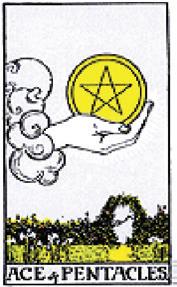



The cards this month indicate you will be in a very happy and calm mood, and there is a lot to be happy about. The new burst of energy and happiness around you is because of your positive thoughts and feelings. Work, finances and love seem to running smoothly. With the exception of delays relating to that promotion you are waiting to hear about. There will be good news mid-month, you may need to negotiate for a higher salary.

The cards this month indicate a time for celebrations and spending. There have been some major breakthroughs with regards to your business. There are a few stresses but you need to allow things to flow, as there are some positive changes on the way. Look closely at your diet and make some changes to what you are eating. There may be some food intolerances issues which may cause your stomach to bloat and make you feel uncomfortable.
 By NANcy JADE ALTHEA www.nancysood.com
By NANcy JADE ALTHEA www.nancysood.com
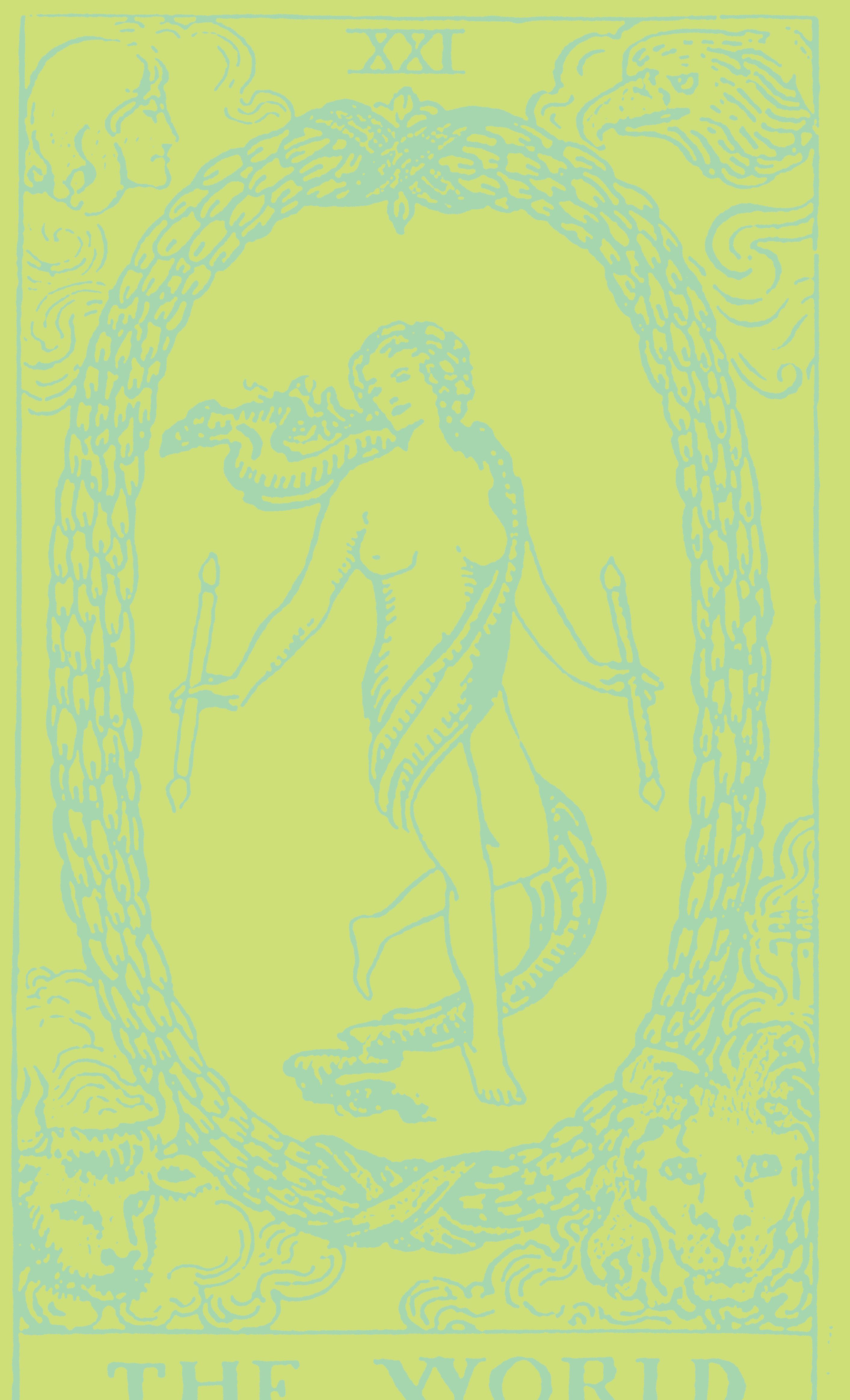
This month you will be looking after your body, mind and soul. You may look at starting a new exercise regime. You have been keeping very active lately, but have not been looking after your mind. You are thinking too much about the past. Let it all go and live for today. You are upsetting yourself by hanging on to those memories. There is a person who will be coming into your life to offer some wise words.
This month there are some difficult times, as someone in the family is not feeling too well. There will be some tests carried out and a need for a change in their care plan. Look forward to good news around your home, as you will be thinking of purchasing some land. Read all paperwork carefully. You are also looking at changing your work or business. Look at expanding in other cities too, and go forward with confidence.
This month you will look at moving from your current house. You have wanted to make a change for a while. This is the time to move forward into a new future. You are bursting with ideas and energy, and life now needs to move into a new direction. Leave behind the old emotional pain and move on. The colour red is very significant. You may think of joining an evening class to pursue a hobby, maybe dancing?
This month there is a feeling of being left a little unsure of what you want to do. The cards indicate that you are battling with decisions and there are no solutions coming to mind right now. Take time out and the right answer will come. Make sure you do not rush into anything or you will regret your actions. You may need to eat humble pie and apologise to a colleague or friend for being rather curt lately.
This month could see you making some major changes in terms of your attitude towards your work and home life. Lately you have been working at all hours and not giving your loved ones your time. There are some exciting family parties. This is the time to really relax, take time out and leave work behind. The weekends will be packed with different invitations. Try to avoid too much oily and dairy food. They will be hard to digest.
Some things have really upset you lately and you are not able to move forward. There will be news about a new opportunity. You may also need to travel at short notice. Your lover may not be giving you what you need, so try and speak to them. Life will be a little up and down, but take some time out for yourself. You have been worrying about everything and everyone. Now’s the time to have fun.
There is a feeling of restlessness this month. The cards indicate a time when you will want to take some major decisions about what you want to do. There may be a possibility that your spouse may want a child and you are not sure. If you have recently met a new lover, be careful not to get carried away. You are feeling vulnerable and need to stand firm about what you want. Keep clear quartz for luck.
This month you will be working hard to establish your position in the world. You will be feeling a little stressed out with how things have gone for you of late. There will be good news around work, and your love life looks as if it is about to take a huge turn for the better. The initial P is very significant in your life. Have fun and let your hair down. Start networking and meeting new people.
This month you will have a tough time with your loved one. You may need to have a heart-to-heart talk to solve misunderstandings. You will be under pressure from work, as lately you have not been able to concentrate properly. Let your mind be cool and take up deep breathing exercises. There will be a friend who needs your help. Try not to get too involved as things are more complicated than you are aware of.
This month your mind will be firmly focused on making money, and taking a long break somewhere. You want to treat your loved one. Life has been very hectic lately and you have been overdoing things. You also have knee and leg pains. Take yoga classes as they will do you a world of good. You also need to start taking care of your bones and look at taking supplements for bone health. Have your blood pressure checked.
Considering the racy pace at which Bollywood operates, it’s no wonder actors look forward to the occasional break from the industry. But not Karan Johar. The filmmaker candidly admits that he sleeps, eats, drinks and talks movies, and that he can’t think anything beyond celluloid.
“My work is my lifeline. My films move me and I don’t have a life besides my movies. They are my primary passion,” said Karan in an interview.
Karan gave a new definition to romance with his urbane, chic romantic comedy Kuch Kuch Hota Hai in 1998, following it with other films like Kal Ho Na Ho, but he admits that he doesn’t follow any trend.
“I am driven only by my instinct. I don’t go by what is happening around. If remakes are being made, that does not mean I will also make one. Or just because masala action films are working, does not mean I will make one. I make what I believe in and hope to achieve the best with it. I don’t follow a norm or go by trends. I make what motivates me,” he said.
And he realised a long-time dream of making a campus film with Student of the Year, which recently opened to mixed reactions.
“Whatever I think of, I make. I wanted to make a campus film about friendship, so made Student of the Year. It was different for us because we worked with newcomers for the first time. The whole idea excited me, so I made the film. Shooting with newcomers was a different but not a difficult experience,” said the 40-year-old director. The young newcomers, Varun Dhawan,
The mortal remains of famous comedian, actor and satirist Jaspal Bhatti were consigned to flames at a cremation ground in Chandigarh recently.
Bhatti died in a road accident near Punjab’s Nakodar town, 170 km from Chandigarh. Bhatti’s pyre was lit by his son Jasraj, who was injured in the accident, but was discharged from hospital without serious injury.
Hundreds of mourners from diverse fields attended the cremation. These included politicians, leading celebrities of the Punjabi film and theatre industry and scores of friends of Bhatti. Earlier, a large number of mourners visited his Sector 19 residence.
“The king of comedy has left everyone in tears. He did not deserve this,” one of his close associates said at the cremation ground.
Bhatti’s car rammed into a tree along the highway while he was on his way to Jalandhar early in the morning, to promote his latest film Power Cut. He was taken to hospital, but declared dead on arrival.
He sustained head injuries in the accident. Jasraj and the film’s heroine Surilie Gautam and publicist Navneet Joshi were also injured, but not seriously.
Power Cut had been produced and directed by him, and was to launch his son Jasraj.
Bhatti was a popular face on television and in Bollywood films with his comedy shows and appearances. His TV shows Ulta-Pulta and Flop Show were popular entertainers in the late 1980s and 1990s. He also directed a film Mahaul Theek Hai, a satire on the police, administration and society, in 1999.
Bhatti, perhaps the most famous Sikh comedian, acted in several Bollywood films too. Bhatti is survived by wife Savita Bhatti, herself an actor, son Jasraj and daughter Raabiya. Fans and the Indian film industry paid rich tributes to the actor and comedian, who leaves behind a legacy of laughs. Rest in peace, Jaspal Bhatti.
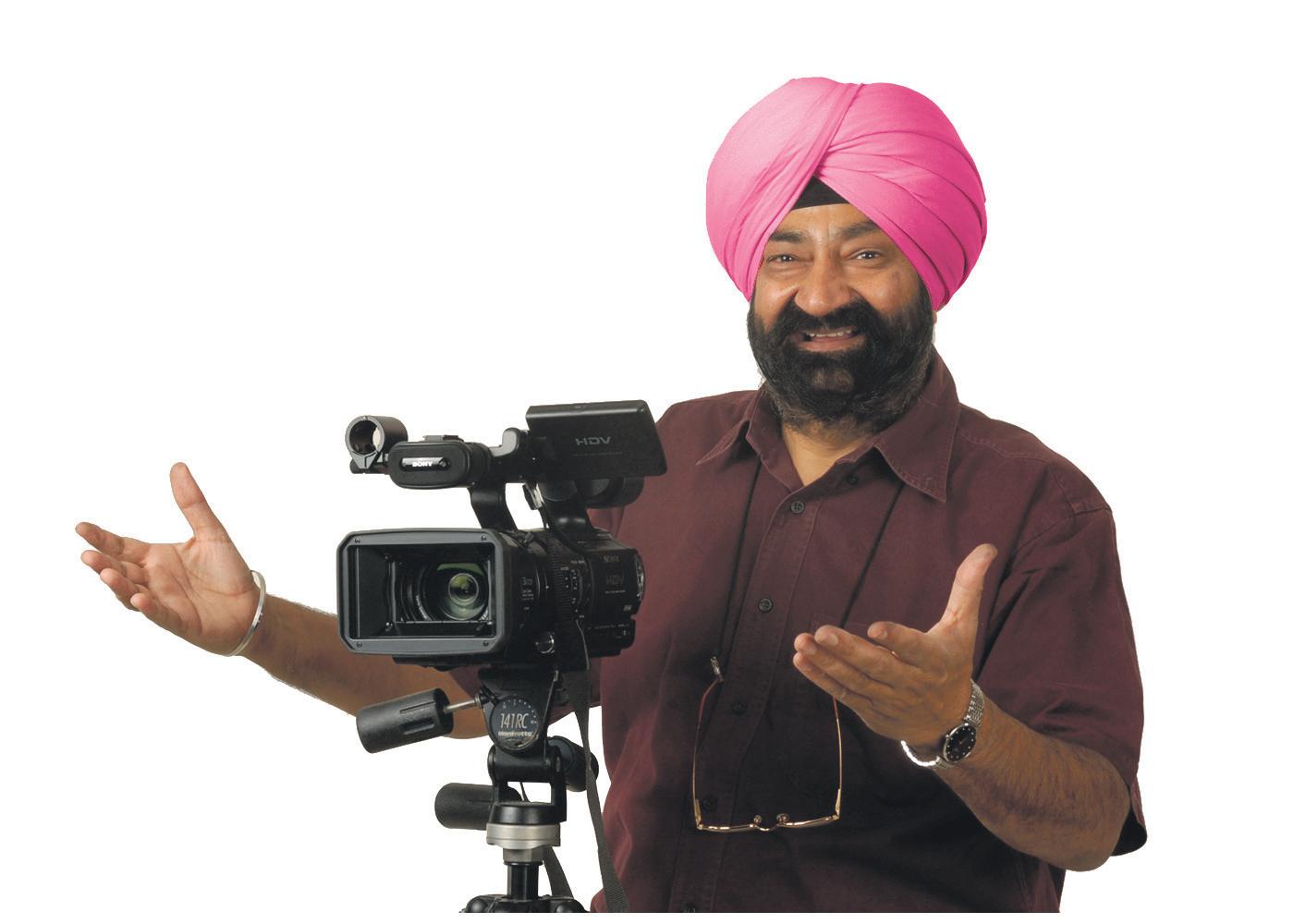
Alia Bhatt and Siddharth Malhotra, did a commendable job, but it’s anyone’s guess how the film will do at the box office. Karan’s not worried, though. He fulfilled his wish of making a campus film, and he doesn’t know what’s next. Watch this space to find out about his next venture.

Yash Chopra’s last directorial work Jab Tak Hai Jaan is set for a grand premiere as a tribute to the late filmmaker, and will be held on November 12, while the film itself releases on Diwali the next day.
“I want to give my husband an unforgettable farewell. Accordingly, we have decided to have a grand premiere for his ultimate film Jab Tak Hai Jaan, exactly the way he wanted it,” Yash Chopra’s wife Pam Chopra said in a statement. “This is a fitting tribute to a man who would have had it no other way. I have asked my sons Aditya and Uday to go ahead with all the preparations. This premiere is our way of celebrating his illustrious life, rather than mourning it,” she added.
The film features Shah Rukh Khan, Katrina Kaif and Anushka Sharma and Bollywood’s buzzing that it will be a box office superhit. A great way to farewell a great legend!
Hardcore masala is Bazmee’s best
Director Anees Bazmee, currently working on No Entry Mein Entry, promises that the new film will be a complete entertainer and a hardcore masala film.
“The kind of films that I have been making so far, you can call them full entertainers, hardcore masala films that are ‘paisa wasool’ like No Entry, Welcome, Singh Is Kinng, Ready. And No Entry... is just like them,” said Bazmee recently. “I feel that the script of the film is written beautifully and it will definitely turn out to be a good film”.
No Entry Mein Entry is the sequel to the 2005 hit film No Entry and will see Salman Khan, Anil Kapoor and Fardeen Khan reprising their roles.
Bazmee admits that the film is a biggie, with a large star cast and no less than ten heroines. Should be interesting to see how Bazmee deals with the heroine overload. Well, we’ll just have to wait and see.
Aashiqui 2’s
Her first film is just out, but will she struggle, despite her pedigree?
(Find the answer under Caption Contest)
To complete shooting the film, that is, as they rush to make the early 2013 release date. Filmmaker Mohit Suri says the cast and crew of Aashiqui 2 will shoot without any break, non-stop till December. It’s a bit hard on the actors and crew, but for good reason, says Suri. Produced by
SENGUPTA brings us up-to-date on what’s hot
Mahesh and Mukesh Bhatt, stars Shraddha Kapoor and Aditya Roy Kapoor.


“Contrary to reports, Aashiqui 2 not a sequel to Aashiqui”, clarified Suri and added, “It’s a new story. The only similarity is the music and the love story. There are seven to eight songs in the film. It’s a musical.”

The original Aashiqui starring Rahul Roy and Anu Agarwal was directed by Mahesh Bhatt. It came out in 1990 and was not only a box office success, but all its songs, including chahiye and Nazar ke saamne jigar ke were chartbusters. Let’s hope 2 brings in the money too!
Jha to take up Satyagraha
He’s one of Bollywood’s most respected filmmaker, and finds inspiration from many different quarters, but it is India’s current state of affairs that has inspired Prakash Jha to make his next film, Satyagraha
“You must be eagerly waiting for the next film Satyagraha. The whole world is in the line of agitation; people are fed up of corruption, inflation, and mal-administration. Amidst these problems, beautiful stories are coming out. I am bonding these stories together to make Satyagraha. So, I always try to match up to your expectations,” the 60-year-old said, addressing reporters recently.
Jha’s latest film Chakravyuh released on Dusshera, deals with the Maoist issue in India and stars Arjun Rampal, Abhay Deol, Esha Gupta and Anjali Patil. Jha is happy with the kind of response the film is getting.
“The kinds of compliments we are getting are beyond our imagination. Javed Akhtar saab, Shabanaji (Azmi), Shekhar (Kapur), friends, critics, people (like the film). I am so touched that every time a show ends, I get a call telling me that people are clapping,” he said.
“So, no matter what our marketing, I feel the audience will now market it. According to some reports that have reached me, people have liked the film, they have been getting emotional and reacting. This is my biggest achievement and I feel this is both - my award and reward,” he added.
Looks like Bollywood’s taking the path of righteousness and social issues to the big screen.
Let’s hope these ground-breaking movies make a positive change.
Bollywood is going pan-Indian. Punjabi mundas and kudis - the staple of so many movies - are making way for Marathi mulgis and Parsi dikras as Hindi films roll out a tapestry showcasing the diversity that is India.

From Parsi and Marathi to Gujarati and Bengali, filmmakers are bringing diverse cultures to the Hindi film firmament. And the credit for this versatility goes to changing tastes and mindsets of the viewers.
Sujoy Ghosh’s Kahaani is a case in
point. Made in Hindi, it had a strong Bengali flavour and was also shot in Kolkata, appealing to audiences so much so that it earned Rs.75 crore – almost 10 times more than its total cost of Rs.8 crore.
Lauding the new trend that he believes is a “great time for India cinema”, Ghosh said, “We make films with themes we are familiar with. For me, it was easy to write about Bengali culture, as I am a Bengali. Thanks to the audience, they are allowing us to experiment.”
Another small budget film, Vicky Donor, wove both Punjabi and Bengali cultures to show an interesting cultural contrast. And it worked.
A film’s success is estimated on the basis of its box-office earnings and this Rs.5 crore project, made by director Shoojit Sircar on an unconventional theme of sperm donation, got the thumbs up from viewers, earning Rs.45 crore.
It is a win-win situation for all - the viewer gets fresh stories to watch, directors are able to explore and experiment, and producers are laughing all the way to the bank.
Said an excited Sircar, “This is a new trend, which is very fascinating; and the best part is that these films are accepted by the audience. I really appreciate this era. This is a tribute to Indian cinema.”
Sanjay Leela Bhansali offered insights into the Gujarati community Hum Dil De Chuke Sanam, Catholics in Khamoshi - The Musical, Anglo Indians in Black and Bengalis in Devdas. His sister Bela focussed on the Parsi community in her debut film Shirin Farhad Ki Toh Nikal Padi and it was satisfactory, businesswise.
“The Parsi community talk is very bindaas. They are very bold and sweet. I picked up this aspect because I wanted to show them as nice and funloving people,” explained Bela, whose directorial debut was about a 40-plus Parsi couple.
The success of these films is proof of the viewers’ open-mindedness. Umesh Shukla, who is enjoying the success of Oh My God, which was set in a Gujarati community, says the film worked in all the
“You get to see different cultures in films these days. Your story should be good. For example, my film had Gujarati culture and it worked well in all the circuits. It worked even in Punjab, Maharashtra and many other places. It’s like a cultural
Sometimes, such films give a place or a culture much-needed
closely observing crime in the area, and decided to share his experience.
Now that the trend is here, filmmakers are using this as an opportunity to experiment with various cultures and share interesting stories from different parts of the country.
Director Sachin Kundalkar delved into the world of Marathis with the recent Aiyyaa. Rani Mukerji plays a Marathi mulgi in this drama that shows how a simple middle class girl falls in love with a guy for his peculiar body odour. The film didn’t do well, but it was like a window into the Marathi culture.

Kudos to multicultural India!
Alia BhattGangs of Wasseypur, for instance, few knew about the small town of Wasseypur in Jharkhand. Writer Zeeshan Quadri says he grew up in the town and spent his childhood Answer to GUESS WHO?
After that hugely successful love-yourparents message, Karan Johar now talks about loving your friends in his latest film Student Of The Year (SOTY).
Student Of The Year is light and fluffy, yet full of substance. The lead threesome - Varun Dhawan, Siddharth Malhotra and Alia Bhatt - are all new faces and quite adorable. The narrative goes back and forth in a similar fashion that was witnessed in Jaane Tu... Ya Jaane Na. School friends meet after a decade of leaving school when they come to meet their dean, Yogendra Vashisth (Rishi Kapoor) who is unwell, and recap their final year in school.
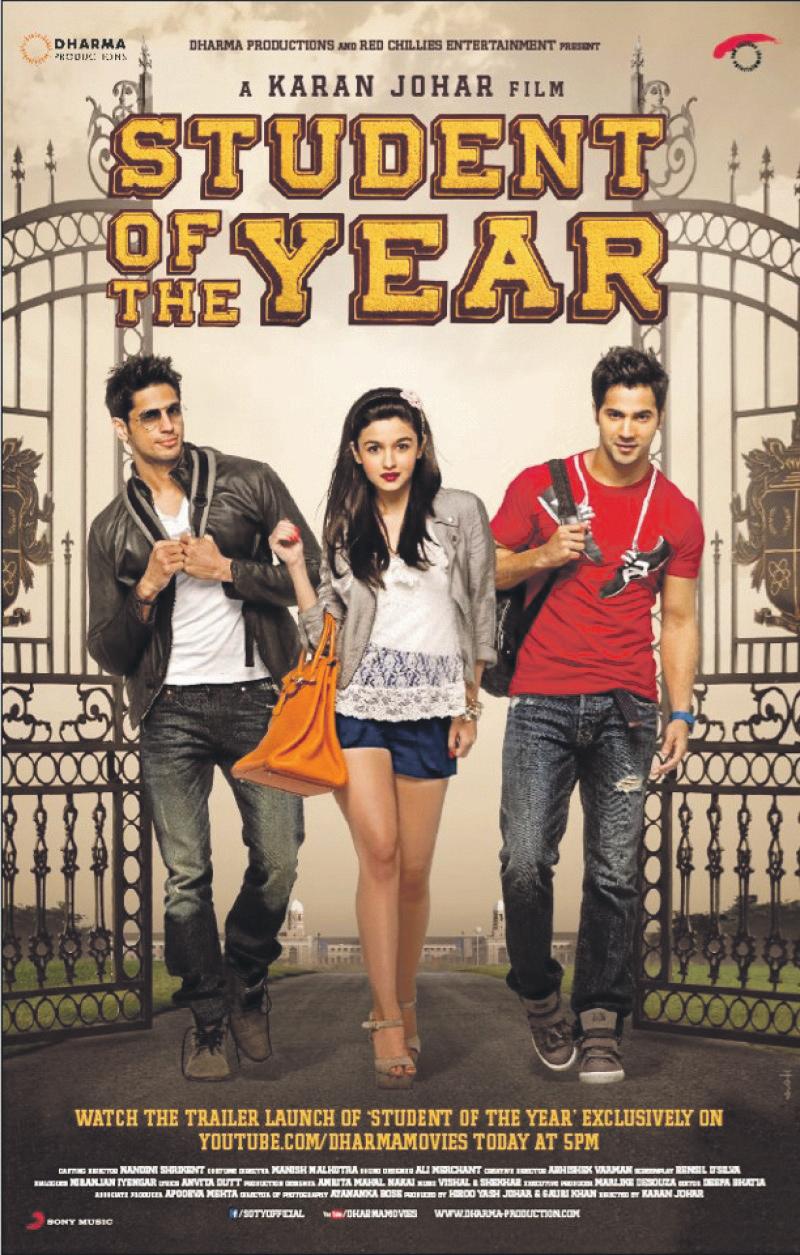
They studied in St. Teresa, a formidable school where kids of rich and famous mingle with hardworking scholars. The contrast is evident when the have-nots are at the beck and call of the creme de la creme.
The rich and flamboyant, Rohan Nanda (Varun Dhawan) is the heartthrob of the school.
Shanaya (Alia Bhatt) is his taken-for-granted girlfriend. Life is hunky dory, till Abhimanyu Singh (Siddharth Malhotra) enters.
SOTY is quite unpredictable. Instead of the regular cliched rivalry, here are two friends who bond together, till circumstances push them away.
Those who are not into teenybopper romances may find the film dragging in parts. It’s only post-interval when the competition for the Student of the Year Award hots up that the viewer is glued to his seat.
The pace of the film
FILm: Student Of The Year
picks up and we wonder who will walk away with the coveted trophy.
The film emits Karan Johar’s pink humour in plenty.
Rishi Kapoor as the gay dean with a roving eye and soft corner for sports coach, played by Ronit Roy, is fabulous. The scene where he throws the dafli at the coach’s wife during the sangeet ceremony of Rohana’s brother is thoroughly enjoyable. The camera does not miss any opportunity to capture the best of the male leads Siddharth and Varun, with their six-pack abs et al. A treat for the eyes of many. In terms of performances, all the three debutants are confidence personified. Siddharth is a bit stiff in certain scenes, whereas Alia Bhatt obviously has acting in her genes. But it is Varun Dhawan who steals the show with his charismatic and endearing performance. He is spontaneous, and an elegant dancer to boot. Niranjan Iyengar’s dialogues have their moments. With puns and rhymes, he wows the audiences.
Alia’s dialouge that her marriage will not be decided by rab (god in Punjabi), but at the rich wife’s club elicits lots of laughter.
If Rensil D’silva’s screenplay is sleek, production quality is visually appealing, glossy and vibrant. Vishal-Shekhar’s young, peppy and soulful compositions are enjoyable and foot-tapping. Overall, the film is larger than life. A blend of High School Musical and Julia Robert’s Monalisa Smile is an enjoyable combination.
Definitely worth a watch. Troy
RibeiroCAST: Siddharth Malhotra, Varun Dhawan, Alia Bhatt, Rishi Kapoor, Ram Kapoor, Ronit Roy, Gautami Kapoor, Sana Syed, Kayoze Irani and Farida Jalal
DIRECTOR: Karan Johar
There is never a time or a place for true love. It happens accidentally, in a heartbeat, in a single throbbing moment.
That moment for the very rich, Rajveer Grewal (Jackky Bhagnani), an automobile modifier who has just completed his project - DC (Dream Car), occurs on the escalators of his office building where he sees the woman of his dreams.
Then starts his chase for Madhuri Singh (Niddhi Subbaiah), the girl who would be his mother, Rashmi Grewal’s (Kirron Kher) - DB (Dream Bahu).
The premise of Ajab Gazabb Love pivots around DC and DB.
This love story takes a spin because Madhuri, a selfrighteous girl who works for an NGO, proclaims that she hates rich people.
To win her, Rajveer in all his foolishness claims he is a poor guy and Madhuri falls for him hook-line-and-sinker.
But then Indian marriages involve entire families. So here starts the drama and series of comic events. The Grewals move from their posh bungalow to a squatter’s colony to pretend to be poor.
To add drama to the poor
family story, mom Rashmi Grewal is forced to be a blind person. Rajveer’s brother poses as a drunkard, sister-in-law turns into a maid and his father Yashwardan Grewal (Dharshan Jariwala) becomes a banana vendor.
Ajab Gazabb Love has its hilarious moments but on the whole, the plot is on an even keel.
Kirron as usual is overdramatic and loud. Arshad Warsi as the south Indian friend is good and effective. Arjun Rampal, in a double role as Karan and Arjun, older brothers of Madhuri is good.
Jackky with his six-pack abs makes a sincere effort in delivering what is required of him. Of course, he is endearing at times but those moments are few and far between.
Niddhi as the leading lady is just passable.
Sajid-Wajid’s music is nothing to write home about, average and dismissible. The lyrics like Lip Lock etc, are no poetry either. The songs seem to be forced upon the audience.
After Dhoom, Dhoom 2 and Kidnap, Ajab Gazabb Love just reinforces that director Sanjay Gadhvi is slick and trendy. The ensemble of songs is ample
evidence to the fact.
The elements that don’t work in Gadhvi’s favour are that the songs are carelessly placed in the story, unrealistic approach of the premise of the story, treatment; and a clean-shaven Sardar. These were surely difficult to digest.
If you are having a boring weekend with nothing better to do and if Ajab Gazabb Love is your only option, then only go for it.
Troy Ribeiro
FILm: Ajab Gazabb Love

CAST:Jackky Bhagnani, Niddhi Subbaiah, Arjun Rampal, Kirron Kher, Dharshan Jariwala, Arshad Warsi
DIRECTOR: Sanjay Gadhvi
ouch, the TV channels won’t be flattered. Rush, like Ram Gopal Varma’s Rann three years ago, rushes into the cut-throat world of TRP-driven competition among news channels where news, if not discovered is created in the newsroom. So Varma told us in Rann.
And now late director Shamin Desai’s Rush takes us into the ostensibly murky chatroom politics of news channels where news-baron Roger Khanna (Aditya Pancholi, unintentionally hilarious) gets reporters, civilians, politicians and criminals bumped off to make news. Just like that.
Far-fetched, yes. But Rush has its adrenaline rushing moments in the second half when the narrative picks up momentum and moves steadily towards a climax that is not entirely edgeof-the-seat. But certainly the popcorn on your lap is likely to ignored for a bit as ambitious crime reporter Sam Grover (Emraan Hashmi) gets sucked into a web of crime created by his over-reaching dangerouslyconnected boss.
Rush is not the first film about a young ambitious professional losing moral and ethical equilibrium to attain success. Recently, we had Kunal Khemu in Blood Money and Paoli Dam in Hate Story reaping the bitter fruits of their savage harvest. More closely, Rush resembles Goldie Behl’s Bas Itna Sa Khwaab Hai where Abhishek Bachchan got trapped into a glamorous web of grime by media baron Jackie Shroff. Sushmita Sen had played the suave chic assistant to Jackie who took Abhishek under her sexy wings. In Rush it’s Neha Dhupia, every bit as suave and chic as Sushmita, playing the media baron’s righthand woman who gets too close to Emraan for comfort. And yes, they even share a furtive kiss in a long-shot to ensure Emraan’s hardcore following doesn’t commit suicide.

Rush does have its sluggish chunks in the storytelling. But the narrative gathers strength from the basic plot structure where a television journalist is shown to be on the run. Some of the chase sequences are
FILm: Rush CAST: Emraan Hashmi, Aditya Pancholi, Neha Dhupia, Sagarika Ghatge DIRECTOR: Shamin Desai
expertly done. And the whole theme of the newsmaker’s descent into compromised journalism makes for some riveting moments.
While many of the characters are sketchy, some like the sharp-shooter (played by Murli Sharma) who befriends our journalist-hero provide the plot with a spicy if not completely pungent propulsion.
The entire episode after the murder of Emraan’s journalistfriend Rikin (played by TV actor Alekh) makes for absorbing viewing.
Emraan as the backbone of plot performs decently. He has more speaking lines and less kissing to do here than in all
his recent films. Whether the verbosity actually translates into something substantial or not is debatable.
Rush has the bone though not enough meat to make for a juicy fare on the excesses of
television journalism. It leaves you wondering what director Shamin Desai would have done with his filmmaking career had he lived.
Subhash K. Jha
Daag, Kabhi Kabhie, Silsila, Lamhe, Chandni, Dil To Pagal Hai, VeerZaara….the list goes on and each of these blockbusters is a tribute to the legacy of late film-maker, producer and director Yash Chopra.
After an illustrious career spanning over 50 years in Bollywood, the 80-year-old doyen of the Hindi film industry passed away on October 21, following multiple organ failure brought about after an attack of dengue fever.
The news brought a wave of shock to Bollywood, as many of its most prominent luminaries rushed to pay respects to the person who was undoubtedly one of Bollywood’s most revered and respected filmmakers. For someone who had been present looking hale and hearty at the 70th birthday celebrations of megastar Amitabh Bachchan a few weeks ago, it was hard to comprehend how the veteran filmmaker could have suddenly succumbed to this illness.
But it was not just Bollywood who mourned the passing of this undoubtedly great director and producer. From politicians to the public, tributes poured in for the man who had created memorable films to entertain the masses and had made an indelible mark on the Indian film industry.
After his demise, Yash Chopra’s body was taken to his Juhu bungalow in Mumbai for a short while and later taken to Yash Raj Studios to allow his staff and the public to pay their last respects to the late filmmaker. A large black and white picture of Chopra was placed alongside his body, decorated with white flowers. Among close family members present at the studios were his son Uday Chopra, seen supporting his mother Pamela.
Thousands thronged to the studio to catch a glimpse of the man whose films are classics of a genre.
It is testimony to the greatness of Yash Chopra that the entire film industry turned up to pay homage, with his closest family and friends accompanying his body to the crematorium where his last rites were performed.
Yash Chopra was born in Lahore on September 27, 1932 and eventually came to Mumbai after Partition. In an interview some
days before he was hospitalised with dengue, Chopra said to Shah Rukh Khan, a star he had created, “My mother said do what your heart says. She gave me Rs.200 and said my blessings are with you. Go ahead and don’t worry.”
And that’s precisely what Chopra did when he came to Mumbai and took on the role as assistant to his late brother and filmmaker BR Chopra, to whom he gave credit in an interview before his death. “I’m sitting here just because of B.R. Chopra and no one else. I wanted to fly on my own wings,” he said in that interview.
Known as the ‘King of Romance’ for his success in that genre, Chopra created memorable love stories in Daag, Kabhi Kabhie, Silsila, Chandni, Dil To Pagal Hai, and Veer Zaara. To keep up with evolving audiences, he adapted new trends in each era and made the most glamorous and trendy romances.
However, life wasn’t always as rosy as his romantic films. Films like Faasle (1985) and Vijay (1988) bombed in succession at the box office. But it wasn’t long before Chopra triumphed once again at the box office with Chandni, a
hardcore romantic film with nine songs.
Chopra knew how to keep up with the times, and instead of being caught in a warp, he began to cater to the increasingly savvy Gen Y audience. He launched Dil To Pagal Hai in 1997, a sleek, urban, musical romantic saga that reaped gold at the box office. The crossborder romantic flick Veer Zara (2004) came next, and the latest still-to-be-released venture Jab Tak Hai Jaan starring Katrina Kaif and Shah Rukh Khan was to be Chopra’s swansong.
However, Chopra’s oeuvre was not limited to just romance and relationships. In his five decadelong career, he experimented with all genres.
His first film Dhool Ka Phool in 1959 was the story of an illegitimate Hindu child being brought up by a Muslim. His next project, Dharamputra (1961) was another hard-hitting film on communal conflict, and was one of the first films to depict the Partition and Hindu fundamentalism. The film marked the debut of Shashi Kapoor in a full-fledged role and won the
National Award for Best Feature Film in Hindi.
A precedent-setter, Chopra’s 1965 critically successful drama Waqt pioneered the concept of multi-starters in Bollywood, while Ittefaq (1969) was a taut thriller, being the first Hindi film which did not have any songs or an interval.
Proving his versatility, Chopra on one hand directed intense dramas Deewar, Trishul, and Mashaal, while on the other he made family sagas like Parampara and thrillers like Kala
Patthar and Darr
Chopra’s movies were sometimes based on real life tragedies. The Dec 27, 1975, accident in a coal mine in Chasnala near Dhanbad inspired the multi-starrer intense drama, Kala Patthar starring Amitabh Bachchan, Shatrughan Sinha and Shashi Kapoor.
Yet, Chopra was one of the few directors to make two superhit films simultaneously - action drama Deewar (1975) and crossgenerational romance Kabhi Kabhie (1976) - both proved his versatility and his hold on the pulse of audiences. But, like all legendary directors, it’s not just a couple of films that can sum up Chopra’s achievements. His run of successes has earned him a permanent and well-deserved spot in Bollywood’s annals of fame.
Yash Chopra’s style of filmmaking was unique because it crossed many genres and generations. He had the ability to bring across social and emotional messages in a manner that would appeal tremendously to his audience. With the use of romanticism, a message of moral responsibility, exotic locales and adept actors in directing over 22 films, he delivered entertaining and interesting movies through his 53 years in the industry.
Star maker
Punters watching the events unfold after Yash Chopra’s demise would note that stars Amitabh Bachchan and Shah Rukh Khan were prominent in their assistance to the grieving family. They were seen at the hospital and accompanying the body to its residence and for the final rites at the crematorium. Not surprising as both actors, and indeed many more, owed their success to this unique filmmaker.
Of all the many stars launched by Yash Chopra, the Big B and SRK are the greatest testimony to his star-making capabilities.
Amitabh Bachchan owes his ‘angry young man’ avatar to Chopra, who
consolidated that image through Deewar. SRK, the self-proclaimed King of Bollywood had Chopra to bring out the best in romance in him; and it’s hard to forget Darr, which remains one of SRK’s biggest blockbusters to date. He can claim his almost obsessive romantic tag to the filmmaker. Chopra also made other remarkably successful stars like Parveen Babi, who defied the norm of the established Bollywood heroine in Deewar, a coup for Chopra and Babi. Juhi Chawla, Karishma Kapoor, Sridevi and Rishi Kapoor were only a few of the actors who benefitted tremendously from being a part of the Yash Chopra camp.
From Ashok Kumar to Mala Sinha to the current crop of feisty actors, Yash Chopra worked with them all. Not to mention screenwriters, playback singers, cinematographers and all the many, many people involved in the film industry, who pay homage to his memory.
In his career, Chopra won many awards, including the prestigious Dadasaheb Phalke Award in 2001, six National Awards, 11 Filmfare Awards and was conferred the Padma Bhushan in 2005. But there was more. Many of Chopra’s romances were filmed in the beautiful alpine landscape of Switzerland. In fact, he shot so many times in Switzerland that a lake in the Alpenrausch, a favourite shooting spot of his, has been christened Chopra Lake. Not only that, he became the first recipient of the title of Ambassador of Interlaken, and a special Yash Chopra Suite and Yash Chopra Train were inaugurated in his honour in Interlaken in 2011.
Yash Chopra’s new film Jab Tak Hai Jaan was to be his directorial swansong before retirement, but unfortunately his untimely demise prevented him from enjoying what seems to be its certain success. To be released auspiciously on Diwali, the romantic saga stars Shah Rukh Khan and Katrina Kaif.
The 43rd International Film Festival of India (IFFI) to begin on November 20 will also pay homage to this exemplary filmmaker through a cinematic tribute.
Yash Chopra is survived by wife Pamela and two sons – Aditya, a filmmaker and Uday, an actor.

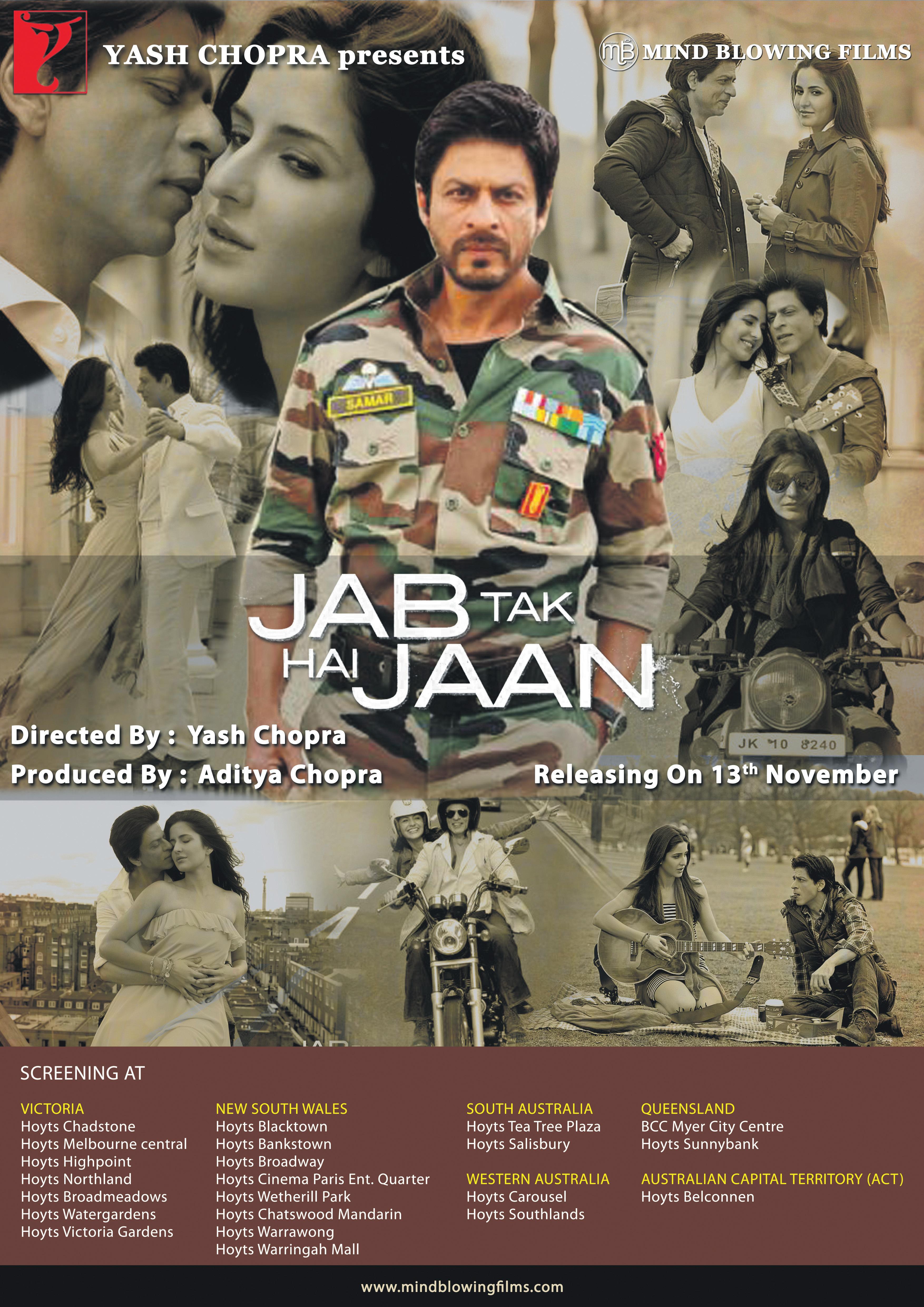
Fortunately for the innocent public supporting both sides with their tax dollars, the battleground was limited to a U-shaped chamber with opponents comfortably placed in cushioned trenches of green leather
By lP AyeR
Thank God! Or, should I say thank Goddesses, for bringing on Dusshera in time to edge out the great Gender War that is gripping this country out of our psyches. This WoW (war of words) was getting fiercer than WWII, with both sides tossing stink bombs at each other, turning serene springtime into a season of sleaze and slander.
Fortunately for the innocent public supporting both sides with their tax dollars, the battleground was limited to a U-shaped chamber with opponents comfortably placed in cushioned trenches of green leather, facing each other with a mound of bound tomes in the middle. Both sides had similar numerical
strength with a few aligning with one side or the other, depending on the situation. Another unique aspect of this stoush was the presence of a supposedly neutral person, not unlike the UN observer, whose job was to see the battle was kept within bounds.
Of the two fighting forces, the ‘Handbag Hit Squad’ was better equipped with finance, health and legal resources; whereas the opposing Coalition forces were only a shadow of their rivals. The Handbag squad’s verbal missiles, sounding very identical, showered the opposition with seldomheard-of terminology, forcing the general public to Google-search that word. The Coalition’s captain, with his habit of shooting from the hip and lip at the same time, was alleged to have fallen out of favour with the fair sex. But he had the full backing of his reserves in the home front. Sadly his allies ‘on’ air attack misfired, sending his supporters away.
The funniest thing about this gender war was that both sides claimed they were fighting for the same cause – regard for women. The Handbag Brigade branded the Opposition of having very little respect for women, quoting some ancient incidents. The Coalition hit back that the Women Warriors not only went mum, but tried to shield a spokesperson when he slipped so low as to make disgusting remarks about women. So much for the clamour of the two sides fighting for women’s honour in a season when women are raised to the highest level of respect and reverence in a land half the globe away - Mother India.
Yes, it is that time of the year - Dusshera (Karnataka and Bengal) and Navratri (Tamil Nadu) - when every female form of the Almighty is worshipped. In Hindu mythology every God has a Goddess including Ganesha (in some parts of Maharashtra),
emphasising the concept of equal status of women. An in-depth analysis of Hindu philosophy will help one to understand that various deeds in the divine domain are just a reflection of daily happenings in human lives.
For any individual or society to prosper, a certain amount of wealth is needed. To create and manage that wealth, proper skills are required that come about through education. And above all, to survive from external or internal threats, security is of utmost importance.

Realising this basic principle, these three important endeavours are entrusted in Hindu mythology to Durga (security), Lakshmi (wealth) and Saraswati (education). And as an act of great reverence, Shakti is regarded as an absolute equivalent to her male consort.
Refreshing this principle of equality and re-emphasising the need to pay due respect to women, the Dusshera/Navratri
The two sides fought for women’s honour in a season when women are raised to the highest level of respect and reverence in a land half the globe awayMother India.
festival serves as an annual reminder. Dusshera celebrations in Mysore and Durga puja in Bengal are very well known all over the land. During Navratri, in many Tamil households statuettes of goddesses are decorated and displayed in layers of steps (kolu) and women are invited to join in special prayers.
So it is very appropriate that this festival has arrived in time to end the war of words and the duel for dominance between the sexes. Thank Goddesses!



